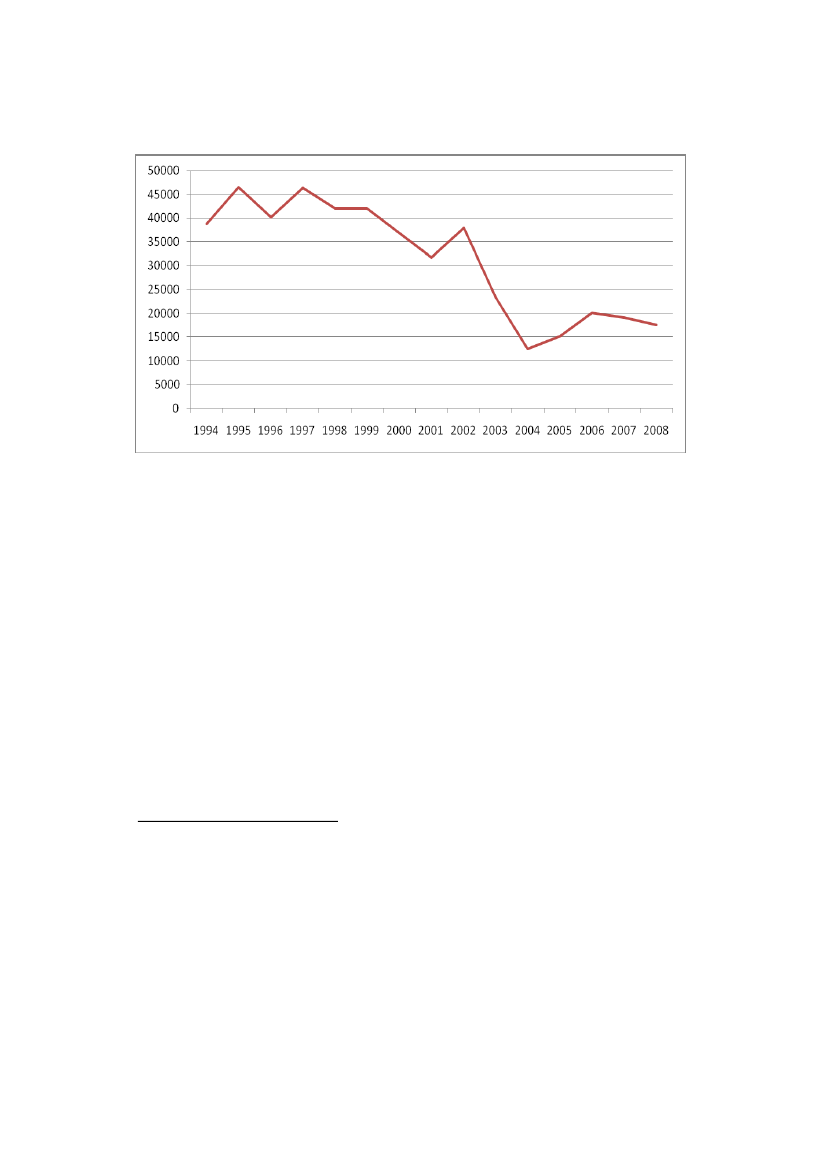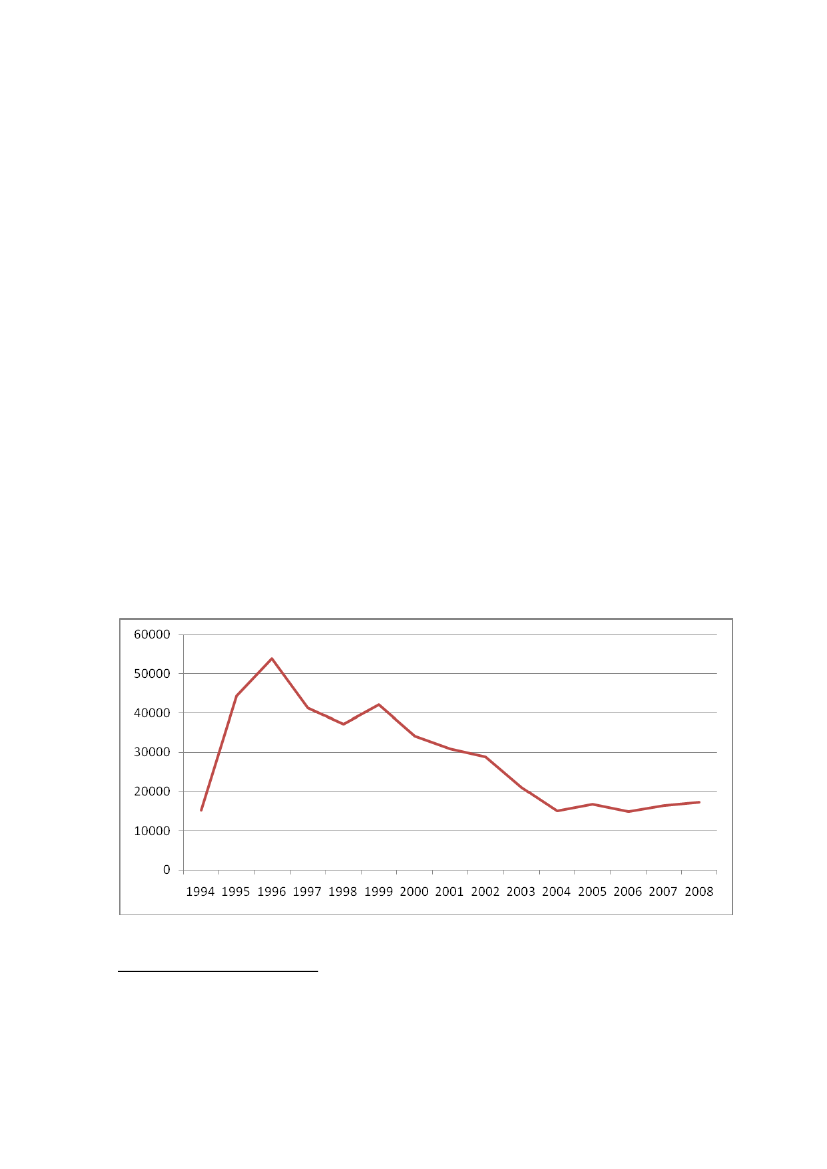Udvalget for Udlændinge- og Integrationspolitik 2010-11 (1. samling)
L 168 Bilag 7
Offentligt
Country Report The Netherlandsby Tineke Strik, Maaike Luiten and Ricky van Oers
The INTEC project:Integration and Naturalisation tests: the new way toEuropean CitizenshipThis report is part of a comparative study in nine Member Stateson the national policies concerning integration and naturalisationtests and their effects on integration.
Financed by the European Integration Fund
November 2010Centre for Migration LawRadboud University NijmegenNetherlands
THENETHERLANDS
IntroductionChapter 1: Overview of the policy developmentsChapter 2: Integration test abroad2.1 Description of the test2.2 Purpose of the test2.3 Effects of the test2.4 Strengthening the requirements: what effects are to be foreseen?Chapter 3: Integration test in the country3.1 Description of the test3.2 Purpose of the test within the framework of theWet Inburgering3.3 Evaluation and policy changes3.4 Effects: statistics3.5 Effects of the test on the residence rightsChapter 4: Integration test in the naturalisation procedure4.1 Description of the test4.2 Purpose of the test4.3 Effects of the test: statistics4.4 Effects of the naturalisation test: other researchChapter 5: Analysis of the interviews regarding the test in the country5.1 Introduction5.2 Motives of the migrants to take the integration test5.3 Obligatory status of the test5.4 The content of the course5.5 The level of the course5.6 General impression of the test5.7 Effects on integration5.8 Groups finding it difficult to meet the integration obligation5.9 Exemptions and dispensations5.10 Other purposes of the integration requirement5.11 Costs and finesChapter 6: ConclusionsBibliography
59
14182838
4149545562
64687284
8687899295969899100102102105113
3
THENETHERLANDS
IntroductionIn the Netherlands, a certain level of integration is required from immigrantsat three stages: at their application for admission to the Netherlands, at theirapplication for a permanent or independent residence permit and finally attheir application for Dutch citizenship.1The required language level in theadmission procedure is A1 minus (from 1 January 2011 it will be A1); in theother two procedures the required level is A2. Furthermore, immigrants areobliged to pass the integration examination at level A2 within 3.5 years aftertheir arrival. If they fail, a fine can be imposed or their social security can becut.These requirements have all been introduced in the last decade, in orderto promote integration of immigrants. This report tries to give an overviewof the social effects of these requirements. Do the requirements effectivelypromote integration? Do they have other intended or unintended effects?Hence this analysis aims to contribute to the question whether the goals ofthe introduction of the test have been accomplished. To this end, the cominginto force of the relevant acts will be described, including the political de-bates on the bills and the political response to the evaluations of the acts. Fur-thermore the content of the tests, comments from (international) experts andjurisprudence on the integration requirements and literature have been in-vestigated. The study on the effects has been based not only on special eval-uations and figures, but also on empirical research. This field research con-sisted of 56 interviews we conducted from March until mid-May 2010 in theNetherlands and in Turkey with several relevant actors. A description of thevarious respondents is given below.
Selection of the respondents and responseThe field research consisted of 56 interviews. In the Netherlands we inter-viewed 28 immigrants, five language teachers, five NGOs representing theinterests of certain groups of immigrants and five civil servants from differ-ent municipalities. In Turkey we interviewed three language teachers and tenparticipants on a Dutch language course. From the immigrants in the Nether-lands, we interviewed 25 at the test centre (11 in Amsterdam, 8 in Eindhoven1Since 1 April 2007 the tests for permanent residence and naturalisation have been simi-lar. Hence, once someone has passed the integration examination, he/she can apply foreither permanent residence or naturalisation. Those exempted from passing the integra-tion examination within the framework of the Integration Act will however need topass the examination when applying for naturalisation.
5
THENETHERLANDSand 6 in Nijmegen). Most of them had just taken the test; some of them werewaiting in between different parts of the test.2The interviews took on aver-age 15 minutes. A large group of migrants had difficulty giving detailed an-swers in the Dutch language. As one interviewer was of Turkish origin, Tur-kish respondents gave much more detailed answers to our questions. Thiswas also the case for three respondents we found through the individualnetwork of this Turkish colleague. These three interviews took on average 30minutes. Chapter five offers background information on these interviewedrespondents.The interviewed civil servants of the municipalities were all responsiblefor supporting the immigrants who have to comply with their legal integra-tion obligations and monitoring the achievements of the institutes of lan-guage and integration education. We interviewed civil servants in the twolargest cities (Amsterdam �750,000 and Rotterdam � 600,000 inhabitants),two smaller cities (Eindhoven � 212,000 and Nijmegen � 160,000 inhabitants)and one small university town (Wageningen � 35,000 inhabitants). These in-terviews took on average 90 minutes.The NGOs we interviewed are to be distinguished between organisationswhich represent immigrants from a certain country and organisations whichpromote the interests of immigrants with specific backgrounds or problems.In the first category we interviewed the chair of the Moroccan organisation(EmCeMo), the director of the Chinese organisation (IOC) and a policy advi-sor of a Turkish organisation (IOT).3In the second category we interviewed amember of the board of an organisation for victims of domestic violence inmigrant families (Kesban), a policy officer from the headquarters of theDutch Refugee Council (VVN) and a coordinator of a regional refugee orga-nisation (Vluchtelingen Werk Rivierenland), which supports the integrationof migrants with an asylum related background. All five organisations wereinvolved in supporting migrants with legal or social problems and acted astheir advocates before national or local decision makers. These interviewstook 60 to 90 minutes.
2
3
Efforts to find respondents at counters of municipalities or legal advisors, failed becausethere were not many people in a waiting room (they have consultations by appoint-ment), and most of them dealt with other questions or topics. Also efforts to arrangeappointments with clients of the civil servant in Nijmegen failed: a written request foran interview only led to one response from a newly arrived Somali man who couldbarely speak Dutch.The number of people in the Netherlands originating from Turkey is (in 2010) about384,000 and from Morocco (in 2010) about 349,000, source: CBS (Dutch Central Bureauof Statistics). The Chinese people in the Netherlands originate from different countries,such as: the Peoples Republic of China, Hong Kong, Taiwan, Indonesia, Surinam, Viet-nam and Singapore. The total size of this group is estimated at 80,000.
6
All language teachers we interviewed were employed at the RegionalEducation Centre (ROC), a national institute for vocational training, whichalso offers language courses. Three of them were based in Amsterdam, twoin Nijmegen. These interviews took on average 60 minutes.From the 56 interviews, we conducted 13 interviews in Turkey: 3 lan-guage teachers and 10 participants on a language course. The three languageteachers had lived in the Netherlands for a long time and had founded theirown language course in Turkey (in Bursa one year previously, in Ankara 3.5years previously, in Karaman 3 years previously). These interviews took 60to 90 minutes. Via these teachers, we got in contact with ten migrants who(had) participated in their courses, in preparation for the integration testabroad. Seven respondents had already passed the examination applied forfamily reunification or family formation, three were still preparing for it. Asthe interviewer was Turkish, these respondents gave detailed information ontheir background, their motivation for passing the test and their opinion onthis requirement, and the problems they perceived, also in relation to theother requirements for family reunification. The interviews with immigrantstook 30 to 45 minutes.
Working methodAfter giving a description of the content and the application of the test (in-cluding target group, exemption, costs etc), we assessed the purpose of therequirement and the arguments and positions taken during the political de-bate in the decision making process. We also investigated to what extent theact had been amended after the entry into force, in reaction to evaluation re-sults, jurisprudence or other reasons. In assessing the effects of the tests, weinvestigated whether the purpose(s) of the acts had been achieved by thetests and if there were side effects which had affected the integration or otherpurposes of the requirement.
Already conducted empirical researchAs the number of respondents was relatively low, we tested our research re-sults against the results of accomplished empirical research on the integra-tion and naturalisation tests. These were the official evaluation of the CivicIntegration Act Abroad (hereafterWet Inburgering,WIB) of 2009 (paragraph2.3) and the official evaluation of the Civic Integration Act (WetInburgering,WI) in 2010 (paragraph 3.3 and chapter 5). With regard to the integration testabroad we also involved the results of interviews conducted in 2009/2010 bythe Turkish organisation IOT with people who faced problems with(re)uniting with their partner residing in Turkey (paragraph 2.3). These in-7
THENETHERLANDSterviews offered some insight into the causes of these problems. With regardto the naturalisation test we involved the results of the research by Van Oers,conducted in 2006 (see paragraph 4.3 and chapter 6).We finally thank Anita Böcker, Ayse Ekmek§i, Carolus Grütters andMarjolein Hopman for conducting and analysing the interviews and Hannievan de Put for the lay out of the report.
Overview reportThis report starts in chapter one with an overview of the developments of theintegration requirements, in order to show the interaction between the de-bate and introduction of the various tests. Chapter two describes the contentof the integration test abroad and the way the introduction was motivatedand discussed. The final paragraph in this chapter deals with the outcome ofthe Intec interviews and the evaluation of the act. Chapter three deals withthe content and the establishment of the integration requirement for perma-nent and independent residence. Chapter four deals with the development ofthe integration requirement for citizenship and the development of the num-bers and background of applicants for naturalisation. As the integration testfor permanent residence and naturalisation have the same content, the inter-views regarding the integration test in the Netherlands have not distin-guished between the two application procedures. The outcome of the inter-views in the Netherlands and background information on the interviewedimmigrants are described in chapter five. The conclusions of the research onthe effects of integration tests are described in chapter six.As the Dutch integration policy is developing rapidly, the reader hasto be aware that developments after November 2010 have not been taken intoaccount.
8
Chapter 1: Overview of the relevant policy developments4In the Netherlands, the discussions regarding a more demanding integrationtest for naturalisation started in the early 1990s. Since 1985 the immigrant hashad to fulfil the requirement of being ‘sufficiently integrated’ to become aDutch citizen. A ‘reasonable knowledge’ of the Dutch language and a certainlevel of integration into Dutch society served as indications for this criterion.5A civil servant from the municipality of registration of the immigrant as-sessed the fulfilment of this requirement on the basis of a short conversationwith the immigrant on ‘everyday issues’.6Proof of written skills was expli-citly excluded. Proof of having social contacts with Dutch citizens also servedas an indication of being integrated. The instructions for the civil servants re-jected a uniform application and prescribed that with regard to elderly, loweducated, illiterate and handicapped immigrants insufficient knowledge ofthe Dutch language should not be a reason for rejection of the naturalisationapplication. According to the instructions, the requirements for women couldalso be less severe.7The instructions were based on the basic principle thatnaturalisation fits into the process of increasing participation in Dutch socie-ty. This process however did not need to be accomplished at the moment ofnaturalisation.This principle was part of the view laid down in the integration policy atthat time, the so-called ‘Minorities’ policy’, that a strong legal position wouldfurther immigrant integration. Naturalisation was seen as a means of achiev-ing integration, as a step towards complete integration.8In 1995, the Chris-tian Democrats (CDA) in parliament started to oppose this notion. Theyfound that the demands on future Dutch citizens should be increased, andtherefore proposed to add the requirement of written language skills andknowledge of Dutch society. Instead of a means for integration, this partysaw naturalisation as the ‘legal and emotional completion of the integration’,thereby deviating from the position the government had so far held.9Thisidea was opposed by other political parties in parliament (the Liberal Demo-
4
56789
Parts of this overview have been taken from R. van Oers,‚Citizenship Tests in the Nether-lands, Germany and the UK‛,in Van Oers, Ersbøll and Kostakopoulou,‚A Re-definition ofBelonging?‛,2010, Koninklijke Brill NV, pp. 51-105.Article 8 (1) sub dRijkswet op het Nederlandschap1985.Until 1990 each applicant had an interview with a public prosecutor and a police officer(Groenendijk, 2010).Handleiding Rijkswet op het Nederlandschap,A1, pp. 10-21.Rijkswet op het Nederlandschap1985, A1– Article 8, p. 19.HandelingenTK, 16 February 1995, no. 49, p. 3150.
9
THENETHERLANDScratic D66, Green Left and the Social Democratic PvdA).10Also the ChristianDemocratic Minister of Justice was not in favour of adding the requirementof written language skills. He expressed the wish for Dutch nationality toremain open to ‘weaker’ groups living in the Netherlands.In 1998, the introduction of the Newcomers Integration Act (WetInbur-gering Nieuwkomers,hereafter WIN) emphasised the immigrant’s own re-sponsibility to integrate. The new act obliged newcomers to attend a civic in-tegration programme (inburgeringsprogramma), which included a test at thebeginning and the end in order to measure the progress the participant hadmade. Although the tests were intended simply as a measurement of thelevel of Dutch language knowledge that had been attained, the first step insubjecting immigrants to formalised integration tests had been taken. In thatsame period, the political debate regarding the requirements for naturalisa-tion started to concentrate on the language and integration requirements.The CDA (Christian Democrats) were now supported by the VVD (Conserv-ative Liberal) and the small Christian parties in their desire to demand writ-ten language skills for immigrants who wanted to become Dutch nationals.Together, they argued in favour of a higher proficiency in the Dutch lan-guage than the level targeted under the WIN. Although this level was only agoal of the WIN and not a requirement (unlike the language requirement fornaturalisation), the level of language proficiency of the WIN apparently ex-erted upward pressure on the level of language proficiency for naturalisa-tion. This time the Christian Democrats won, and the newly introduced natu-ralisation test required sufficient knowledge of Dutch society and being ableto speak, understand, read and write Dutch at level A2 of the Council of Eu-rope’s Framework of Reference.11The conviction that naturalisation wouldstrengthen the integration and should therefore be stimulated, was now re-placed by the idea that naturalisation was the reward for completed integra-tion. The Conservative Liberal Minister for Integration and Alien AffairsVerdonk carried out this idea, repeatedly referring to citizenship as the ‘firstprize’.12She nevertheless rejected in 2003 a new request by the Christian De-mocrats to raise the language level required for citizenship, with the argu-ment that this requirement should not serve as a selection criterion for citi-zenship.Following the 9/11 terrorist attacks, the rise of Pim Fortuyn’s right wingparty (LPF) and his subsequent murder shortly before the 2002 elections, acentre-right government came into power. This government decided to re-form the 1998 act, the results of which they referred to as disappointing101112HandelingenTK, 21 February 1995, no. 50, p. 3200.Staatsblad,21 December 2000, no. 618. The act entered into force on 1 April 2003.TK 29200 VI, no. 7, p. 3 (November 2003) andHandelingenTK 10 December 2003, p.2486; TK 27083, no. 63, p. 15 (June 2004) andHandelingenTK 2 September 2004, p. 6075and 6096.
10
(Groenendijk, 2010). A parliamentary commission was established to evalu-ate the results of the integration policies.13In its 2004 report, this commissionconcluded that the integration of many aliens had been successful, but that itremained questionable to what extent this was due to pursued integrationpolicy. The commission also concluded that only a small percentage of theparticipants in the integration courses had attained level A2, the level in-tended by the WIN. The commission however did not regard this failure asproof of the immigrants’ unwillingness to integrate, but pointed to failurefactors such as the slow development of courses and the existence of longwaiting lists.14These balanced conclusions however led to the demand inparliament and government for a radical change in the integration regime bystrengthening the responsibility and obligations of the migrant regardinghis/her integration. The government announced that in future immigrantswould be required to first pass a basic examination in the country of origin asa condition for family reunification. Furthermore, all immigrants who de-sired to stay in the Netherlands on a permanent basis would have to attendintegration courses, for which they would have to pay themselves. Not pass-ing the integration examination at the end of the course would entail finan-cial sanctions and would keep the residence right of the migrant on a tempo-rary basis.At the same time, the government installed a commission, the Franssencommission, which was requested to define the concept of integration and toassess the most appropriate level of integration requirements.15In September2005, a proposal for a new WI, which was meant to replace the WI of 1998,was introduced in parliament.16According to the centre-right government, amore obliging and result-oriented integration policy was required in order tocombat the supposedly failed integration of ‘large groups’ of immigrants.17Inthe explanatory memorandum to the bill, the government stated that in order‘for immigrants to catch up and to allow them to successfully participate inthe social markets’, they would need to have knowledge of the Dutch lan-guage and to know and accept Dutch norms and values.18The new WI em-phasised the responsibility of the migrant to meet these criteria. Hence,courses would no longer be organised and financed by the government ormunicipalities, but left to the market and the immigrants. The WI came into
131415
161718
‘Building Bridges’, report of the temporary research commission integration policy, TK2003-2004, 28 689, nos. 8-9.TK 2003-2004, 28 689, no. 9, p. 522.Advice regarding the level of the new integration examination by the Franssen Commission,TheHague, June 2004. For the advice, see http://www.degeschiedenisvaninburgering.nl/docs/advies-franssen.TK 2005-2006, 30308, nos. 1-2.TK 2005-2006, 30308, no. 3, p. 13.TK 2005-2006, 30308, no. 3, p. 14.
11
THENETHERLANDSforce on 1 January 2007, introducing the integration examination as a condi-tion for permanent or independent residence.19Since the level of the integra-tion examination was equal to the level of the naturalisation test, it was de-cided that the integration examination would replace the naturalisation test.Hence, since 1 April 2007, the Netherlands has required newcomers to meetthe same standards as future citizens. This development again led to a call byChristian Democrats, the Christian Union and the Conservative Liberals toraise the language level of the naturalisation test, in order to emphasise thedifference between a permanent residence permit and citizenship.Until now,this political desire has not been fulfilled.The Civic Integration Abroad Act (WetInburgering Buitenland,hereafterWIB) entered into force on 15 March 2006.20The act sets an additional condi-tion for obtaining a regular temporary residence permit, namely that peoplemust first have a basic knowledge of the Dutch language (listening andspeaking skills) and Dutch society.21The WIB was meant to force migrants tostart their integration in their country of origin in order to improve their po-sition in the Netherlands. Furthermore the government intended to makemigrants more aware of their responsibilities and to select the motivatedones among them for admission.This outline of the developments regarding integration requirements inthe last 15 years shows that the principal idea that a strong legal position of amigrant promotes his/her integration has been replaced by the convictionthat this position serves as a reward for having reached a certain integrationlevel. This swing in thinking illustrates the shift from an equally shared re-sponsibility by the authorities and the migrant to the sole responsibility ofthe migrant regarding his/her integration.The integration requirement was first introduced as a condition for citi-zenship, and second as an obligation for admitted migrants. The introductionof a test for migrants (although it did not include an obligation to pass) led toan increase in the required level for naturalisation. The evaluation of the in-tegration courses and tests (and the political conclusion that the integrationpolicy had failed) became the reason for the introduction of integration re-quirements for admission as well as for independent and permanent resi-dence rights. Although in 2003 the government warned that language testsshould not serve as a selection of new Dutch citizens, nowadays a generalpolitical acceptance has emerged that integration tests function as selectioncriteria for admission and for permanent and independent residence rights.
192021
WI of 30 November 2006,Staatsblad625.Staatsblad.2006, no. 94.Article 16 (1) sub hVreemdelingenwetjo. Article 3.71aVreemdelingenwet.
12
Development of the government’s interpretation of integration22In 1979 the Dutch government introduced the first integration policy (the so-called ethnic minority policy), which aimed at granting equal rights to ethnicminorities and improving their position on the labour market and in the fieldof education, housing and public health. Already in this period, the ScientificCouncil for Government Policy (WRR) called for attention to the importanceof language courses for labour migrants and their family members.23Becausethe government did not feel responsible for offering language courses, exceptfor refugees, language education was depending from the work of volun-teers. Only after a second advice from the WRR to invest in language educa-tion in order to strengthen the socio-economic position of migrants (especial-ly the first generation Turkish and Moroccan migrants lagged behind in thatsense) and to promote their integration, the government started to offer edu-cation for adult migrants in the beginning of the nineties. For two reasons itdid not oblige migrants to attend a language course: the limited educationcapacity would be insufficient and the notion was dominant that migrantsdid not need to be obliged, as they were motivated to learn the Dutch lan-guage.In 1994, the government reformulated its integration policy, aiming atthe development of migrants towards active and responsible citizens. Thepurpose of the Integration Act, theWet Inburgering Nieuwkomers (WIN),wasthat migrants would achieve a certain level of capability to live independent-ly, in a social, educational and/or professional sense. Attendance of thecourse offered in the framework of the WIN would result in a first but essen-tial step towards integration.For the preparation Civic Integration Act, which would replace the WIN,the Franssen commission advised (on request of the government BalkenendeII) in 2004 on the content of the new integration examination.24In its advice,the commission defined active participation in society as the goal of integra-tion. According to the commission, everyone should be able to acquire a fullsocial position as free and autonomous citizens. Dutch language skills andknowledge of social relations, norms and values are mentioned as require-ments for achieving this goal. Furthermore, integration and ‘the proper func-
22
2324
For this subparagraph we made use of the article of Odé and De Vries, De Geschiedenisvan inburgering in Nederland, in Odé et al.,Jaarboek Minderheden 2010, Inburgering inNederland,The Hague: Sdu, 2010, pp. 15-32.Wetenschappelijke Raad voor het Regeringsbeleid (1979),Etnische Minderheden. Deelrap-port A. Advies aan de regering.The Hague: WRR.Advice regarding the level of the new integration examination by the Franssen Commission,TheHague, June 2004. For the advice, see http://www.degeschiedenisvaninburgering.nl/docs/advies-franssen.
13
THENETHERLANDStioning of a migrant’ implies knowing and living up to unwritten rules,codes and agreements. This aspect of integration requires the immigrant toassimilate into Dutch society by prescribing the way he/she is supposed tobehave. Finally the commission mentioned that integrated citizens are re-quired to be active in societal life in one way or another. The commissionmentioned voluntary activities at a community centre, in a sports club or as amember of the school board as examples. The commission advised to streng-then the own responsibility for migrants, but under the condition that thegovernment offers adequate tools to take this responsibility.In its integration acts, the governments’ definition on integration seemsto be only partly inspired by the Franssen Commission. The three successiveBalkenende governments (2002-2007) increasingly put emphasis on the indi-vidual responsibility of the migrant and on shared values, amongst othersequal rights for men and women and the separation of religion and state.Hence, the aim of socio-economic participation of the nineties has been re-placed since 2002 by the purpose of cultural adaption of migrants to Dutchsociety. The responsibility for the integration itself was no longer equallyshared between the state and migrants, but merely shifted to the migrants.The integration tests which are assessed in the Intec research, are based onthese principles of integration policy.
14
Chapter 2: Integration test abroad2.1Description of the test
2.1.1 The integration examination abroadThe Civic Integration Abroad Act (WetInburgering Buitenland,hereafter WIB)entered into force on 15 March 2006.25The act sets an additional condition forobtaining a regular temporary residence permit, namely that people mustfirst have a basic knowledge of the Dutch language and Dutch society.26Thisbasic knowledge will be tested in the Basic Civic Integration Examination inthe country of residence of the applicant. The proof of having passed this ex-amination must be handed over at the application for admission.27The level of the knowledge that is tested in the examination has been laiddown in theVreemdelingenbesluit.28Listening and speaking skills in the Dutchlanguage and knowledge of Dutch society will be tested in the integrationexamination abroad. The examination consists of two parts: knowledge ofthe Dutch language and knowledge of Dutch society. The knowledge of bothparts is tested by an oral examination conducted over the telephone fromDutch consulates and embassies abroad, using voice recognition software,which is based in the US. This computer programme also decides whetherthe candidate has passed the examination.29If there is no Dutch consulate orembassy in the country of residence, the examination will be held at thenearest Dutch representation in a neighbouring country.Knowledge of the Dutch languageThe required basic level is A1 minus of the Common European Frameworkfor Modern Languages. This level, which is one step lower than A1, meansthat the examination candidate understands announcements and instruc-tions, simple questions and answers which are related to his/her immediatepersonal life, can give elementary information on his/her identity and per-sonal life and can express himself/herself to a very limited degree (with theassistance of isolated words and standard formulas). The language require-ments are limited to listening and speaking skills. The language test consistsof repeating sentences (the sentences presented become increasingly more2526272829Staatsblad.2006, no. 94.Article 16 (1) sub hVreemdelingenwetjuncto Article 3.71aVreemdelingenbesluit.Article 3.102 (1)Vreemdelingenbesluit.Article 3.98aVreemdelingenbesluit.Article 3.98cVreemdelingenbesluit.
15
THENETHERLANDSdifficult), answering short questions on basic information, responding towords by saying a word with an opposite meaning, and retelling a short sto-ry. The topics dealt with are randomly selected from an item bank of 50items, in order to present a different set of items to each candidate.Knowledge of Dutch societyThe required knowledge of Dutch society consists of ‘elementary practicalknowledge’ on the Netherlands, (including geography, history, legislationand political science), housing, education, the labour market, the system ofhealth care and civic integration. Furthermore the required knowledge cov-ers the rights and duties of migrants and citizens in the Netherlands and theaccepted norms in everyday life and in society.30The knowledge is tested ona level not higher than A1 minus. This part of the examination includes 30questions which correspond to images selected from the film ‚Coming to theNetherlands‛. The questions vary between yes/no questions, open questionsand closed questions with two options.Costs and preparationApplicants are charged €350 each time they take the examination.Passing the examination is a condition for granting an authorisation for tem-porary stay, which is for certain nationalities a necessary document for enter-ing the Netherlands. This authorisation is known as‘Machtiging VoorlopigVerblijf(hereafter MVV).31The migrant must apply for a MVV within oneyear after having passed the examination.32After this period, the result ofthe examination becomes invalid and he/she must take a new test in order tobe admitted.The Dutch government does not provide either courses or learning ma-terial. It has however compiled a practice pack which can be purchased at€ 70.40 and which consists of the film ‚Coming to the Netherlands‛ and apicture booklet about Dutch society, an exhaustive list of questions that mayarise during the knowledge of society test, and a set of mock language tests.
2.1.2 Who has to take the examination?This entry condition applies to those persons aged between 18 and 65 who:1. apply for admission to the Netherlands with a view to settling perma-nently,2. and need to have a MVV,3330313233Article 3.98 (6).Vreemdelingenbesluit.Article 16 (1) a juncto h and Article 16aVreemdelingenwet.Article 3.71a (1)Vreemdelingenbesluit.Article 17 (1)Vreemdelingenwetmentions the exemptions for the requirement of a MVV.
16
3.
and are obliged as newcomers, under the terms of the WI to participatein a civic integration programme after arrival in the Netherlands.34
In practice this obligation primarily concerns applicants for family formationor family reunification with a citizen of the Netherlands or with a migrantoriginating from a non-EU country.35Furthermore the WIB applies to reli-gious leaders coming to the Netherlands in order to enter the labour mar-ket.36ExemptionsAs persons with a certain nationality are not required to apply for a MVV,they are exempted from taking the test. These are citizens from the MemberStates of the EU and EEA, Surinam, Australia, Canada, US, Switzerland, NewZealand, Iceland, Japan and North Korea.37Furthermore migrants coming tothe Netherlands for a temporary reason, such as study, au pair work, ex-change or medical treatment, are exempt, as well as persons with a workingpermit, self-employed and highly educated migrants. Also migrants whowere granted a status on the basis of the Long-term Residence Directive(2003/109/EC) in another Member State and who fulfilled an integration con-dition for this purpose, are exempted.38Finally, family members of a migrantwith an asylum-related residence permit do not need to take the test, unlessthe marriage was concluded after the sponsor was granted a residence per-mit (family formation).39Exemptions for medical reasonsMigrants who belong to the category to which the act applies are exempt ifthey have demonstrated (to the satisfaction of the Minister of Integration)that they are permanently unable to take the examination due to a mental orphysical disability.40The legislator refers to the situation where the applicantis blind or deaf, or has difficulty hearing, seeing or speaking and is not inpossession of audio-visual aids.41Proof of this disability consists of a declara-tion from a doctor or expert appointed by the head of the embassy or consu-late. This medical assessment takes place at the expense of the applicant.423435Detailed information on this act is to be found in paragraph 3.Family reunification means that the marriage was concluded before the applicant wasadmitted to the Netherlands; in other cases (including marriages to Dutch nationals) thedefinition family formation is used.Article 3.71 (3)Vreemdelingenbesluit.Article 17(1) a and bVreemdelingenwet.Article 3.71a (2b)Vreemdelingenbesluit.Artikel 3.71a (2a)Vreemdelingenbesluit.Article 3.71a (2c).Article B1/4.7.2Vreemdelingencirculaire.Article 3.10Voorschrift Vreemdelingen.
36373839404142
17
THENETHERLANDSBeing functionally illiterate does not constitute a ground for exemption.During the legislative process, the Minister of Alien Affairs and Integrationpointed out that the test is taken orally, which should therefore be possiblefor illiterates to pass.43The administrative law section of the Council of State(AfdelingBestuursrechtspraak Raad van State),the highest court in this regard,did not consider this assumption unreasonable, and therefore confirmed thatbeing illiterate was no reason for exemption.44
2.1.3 Consequences of failing the testIf the immigrant fails, he/she will not be granted a MVV, and will thus not beadmitted to the Netherlands. There is no legal remedy with regard to theoutcome of the examination.45The applicant is allowed to do the test as many times as necessary, aslong as he/she pays € 350 for each examination.
2.2
Purpose of the test46
2.2.1 When was it first proposed, by whom and with what arguments?In the Coalition Agreement of the second right-wing Balkenende govern-ment in 2003, the following principles were included: ‘Any newcomer whocomes voluntarily to our country and to whom the WIN applies, first have tolearn the Dutch language in their home country as a condition for admission.Once arrived in the Netherlands, he or she has to gain more in-depth know-ledge of the Dutch society.’47One year later this agreement led to the propos-al for the WIB.48This was only a few months after the entry into force of thedecree that raised the minimum age for spouses to 21 and the income re-quirement to 120 per cent of the minimum wage in the case of family forma-tion.4943444546TK, 2004-2005, 29700, no. 6, pp. 40-41.ABRS, 200806121/1, 9 February 2009, JV 2009/151.Article 3.98dVreemdelingenbesluit.For this paragraph, I gratefully made use of the article by S. Bonjour: ‚Between Integra-tion Provision and Selection Mechanism. Party Politics, Judicial Constraints, and theMaking of French and Dutch Policies of Civic Integration Abroad‛, European Journal ofMigration and Law, 2010, no. 3.TK 2002-2003, 28637 no. 19, p. 14. The coalition of this ‘Balkenende II’ government con-sisted of Christian Democrats (CDA), Conservative Liberals (VVD) and Social Liberals(D66).TK 2003-2004, 29700, nos. 1-2, 21 July 2004.Koninklijk Besluitof 29 September 2004,Staatsblad.2004, no. 496.
47
4849
18
According to the explanatory memorandum, the WIB concerns mainlymigrants who come to the Netherlands for family reunification or familyformation reasons. The government selected this target group because familymigration (in 2002 responsible for one-third of total migration to the Nether-lands) would cause the largest integration problems. It stated that ‘the largescale immigration of the last ten years has seriously disrupted the integrationof migrants at group level. We must break out of the process of (family) mi-gration which time and again causes integration to fall behind’. In particular,the integration process was thought to have been ‘held back by the fact that alarge number of second generation migrants opts for a marital partner fromthe country of origin’. According to the government, ‘an important part ofthese [family migrants] has characteristics that are adverse to a good integra-tion into Dutch society. Most prominent among these – also in scale – is thegroup of marriage migrants from Turkey and Morocco’.50Almost half of thefamily migrants would belong to these communities and would find them-selves in a bad socio-economic position. The government described familymigration as a ‘self-repeating phenomenon of serial migration’, whichseemed to be a ‘self-repeating phenomenon of continuous growth of ethnicminority groups in a socio-economic deprived position’.51As it appeared thaton the basis of the integration programmes offered in the Netherlands, 25 to30 per cent of the newcomers did not reach the required level, the govern-ment found it necessary to start the integration before admission.52This wasin line with two motions adopted by the parliament in 2002, calling formeasures which led to a start of the integration in the country of origin.53The government mentioned four purposes of the introduction of the in-tegration test abroad. First, the test would enable family migrants to ‘get by’better on their arrival. Second, it would allow them to make a more deliber-ate and better informed choice on moving to the Netherlands. Third, itwould make the migrant and his or her partner residing in the Netherlandsmore aware of their responsibility for the integration of the newcomer intoDutch society. The government felt that the ‘supply-oriented approach’ wasno longer appropriate: emphasising the own responsibility of the migrantwould fit into the new approach to integration that it had in mind. In thisview, supporting the migrant in his/her preparation for the test abroadwould send the wrong signal. Furthermore, offering no support would allowthe migrant more freedom of choice on how to prepare for the examination.54As a fourth and final purpose of the WIB, the government expected theintegration requirement would work as a ‘selection mechanism’: only those5051525354TK 29700 no. 3, p. 4. Bonjour (2010), p. 306.TK 29700 no. 3, pp. 2-5.TK 29700 no. 3, pp. 15-16.TK 29700, no. 3, pp. 1-2 andStaatsblad2006, no. 94, p. 5.TK 29700, no. 3, pp. 15-16.
19
THENETHERLANDSwith the ‘motivation and perseverance’ necessary to integrate successfully inthe Netherlands would be admitted.55At the same time, the ones who wouldnot be able to make themselves familiar with the Dutch language wouldcause serious integration problems in Dutch society and therefore not be al-lowed to settle in the Netherlands.56The government stated that reduction inimmigration was ‘not a primary goal’, but welcomed the ‘side-effect’ that theWIB was expected to result in a decrease in family migration flows by an es-timated 25 per cent.57The government explained that it would prefer delayor even cancellation of family migration to the situation in which integrationimmediately after arrival in the Netherlands would lag behind.58According to the government, the integration requirement was in linewith ‘recent European developments in the field of migration of third coun-try nationals’, referring to the Family Reunification Directive and the Long-term Residents Directive. As a matter of fact, the Dutch government itselfwas a strong promoter of the insertion of an optional clause regarding inte-gration requirements in those directives.59Even more interesting to note, isthat the government referred to the ‘Tampere conclusions’, in which theEuropean leaders of governments in 1999 announced the strengthening ofthe residence rights of migrants in order to improve their integration.60
2.2.2 Debate in parliamentIn the Dutch parliament, all political parties shared the government’s viewthat family migration, in particular marriage migration from Turkey and Mo-rocco, had very problematic consequences for the migrants themselves, fortheir partners and children, and for society at large.61All political parties ex-cept the Green Left (Greens) agreed with the proposal to require a certainlevel of knowledge of the Dutch language and society before being admittedto the Netherlands. The motions to which the government referred were filedby members of the ‘Balkenende II’ coalition: VVD (Conservative Liberals)
5556575859
6061
TK 29700 no. 3: p. 6 and 11.TK 29700, no. 3, pp. 4-6.TK 29700 no. 3 p. 6 and pp. 14-15, and no. 6, p. 43. Bonjour (2010), p. 306.TK 29700 no. 3, p. 14.TK/EK 23490, nos. 8e and 254, pp. 16-17. At that time the government only had the ideato introduce the admission condition that the applicant for family reunification wouldpre-finance the integration course in which he/she had to participate after admission;TK/EK 2002-2003, 23490, nos. 8 and 244, pp. 22-23.TK 29700, no. 3, p. 2. See no. 18 and 21 of the Tampere conclusions of the EuropeanCouncil, 15 and 16 October 1999, Conclusions of the Presidency, SN 200/1/99.Bonjour (2010), p. 308.
20
and CDA (Christian Democrats).62But the left opposition parties SP (SocialistParty) and PvdA (Social Democrats) also agreed with the possible migrationreducing effect of the act as a purpose. The last party went a step furtherwith the proposal to require a certain education level from the spouseabroad.63As a matter of fact, the WIB can be regarded as a continuation ofthe policy of the government which included the Social Democrats(‘PaarsII’),to link migration to integration and to consider family migration as acause for large societal problems. All approving parties accepted that somemigrants might never be able to meet the requirement. They agreed with thedecision of the government to withhold its support from migrants while theywere preparing for the test. The Social Democrats found it legitimate to askmigrants to prepare for their integration, but nevertheless requested ade-quate and accessible learning material. The parliament did not adopt thismotion.64The Greens, who voted against the act, however, thought a lan-guage could be much more effectively learned in the country in which it wascommonly spoken and considered it unacceptable that ‘the reduction of thefreedom of choice due to family pressure’ be ‘replaced by a reduction of thefreedom of partner choice by the government’.65Despite the political support for the principle of the bill, there was criti-cism on the execution of the requirement. The debate concentrated on twoquestions: on the admissibility of a mandatory language test without provid-ing sufficient facilities for immigrants to learn Dutch in their country and onthe validity of the language test, as it was based on software developed in theUnited States for a completely different purpose.66The Minister for Alien Af-fairs and Integration had disregarded the conclusion by linguists (who hadbeen asked for advice by the Minister herself) that civic integration could notbe properly tested abroad. The majority of parliament however was satisfiedwith the promise by the Minister to verify the outcome of the computer testduring the first period.During the parliamentary debate on the bill, the government announcedthat it would evaluate the effectiveness and effects of the act on the integra-62Motie-Blokc.s. (VVD), 10 December 2002, TK 28600 VI no. 60 andMotie-Sterkc.s.(CDA), 17 December 2002, TK 27083, no. 25. At that time, Balkenende I was in power, inwhich both parties also participated.TK 2004-2005,Handelingennr. 60, 16 March 2005, pp. 3885-3888.TK 29700, no. 25. TK 2004-2005,Handelingenno. 60, p. 3886, Bonjour (2010), p. 309.TK 2004-2005,Handelingenno. 60, p. 3895 andHandelingenno. 62, p. 4028, Bonjour(2010), p. 309.J. v.d. Winden,Wet inburgering in het buitenland,Den Haag: Sdu 2006; T. Spijkerboer,Ze-ker weten: Inburgering en de fundamenten van het Nederlandse politieke bestel,Den Haag: Sdu2007. About the linguistic arguments: Willemine Willems, De politiek aan de knoppenvan de machine: spraaktechnologie in het inburgeringsbeleid, in H. Dijstelbloem and A.Meijer (eds),De migratiemachine: de rol van technologie in het migratiebeleid,Amsterdam:Van Gennep 2009, pp. 123-156.
63646566
21
THENETHERLANDStion and participation in the Netherlands and the legal effect in practice. Inparticular attention would be paid to the situations in which exemption wasrequired, for instance by Article 8 ECHR.67The act however does not providefor an exemption ground based on Article 8 ECHR. Furthermore, the Minis-ter promised to monitor the application of the act each half year.68
2.2.3 Comments of experts during the legislative processThe advisory committee involved in alien affairs (AdviescommissieVreemde-lingenzaken),appointed by the government, concluded that not all legal ques-tions could be answered immediately, as there was no precedent in Europe.69The committee thought that the requirement was in compliance with theFamily Reunification Directive, but advised not to apply the requirement ifArticle 8 ECHR obliged it to do so. Furthermore, the committee pointed to apossible violation of the principle of equality, as certain nationalities wereexempt.70According to the committee, an exception on grounds of nationali-ty should have a proper justification. Finally, the advisory committeestressed that the government should ensure that all knowledge necessary forpassing the test was easily accessible abroad.71The general advisory body on legislation of the Council of State (RaadvanState)went less far, but advised the government to take responsibility for thedevelopment of appropriate teaching materials. Furthermore the Councilstressed the importance of exemption from the requirement relating to Ar-ticle 8 ECHR.72Groenendijk rejected the one-sided responsibility of the migrant andwarned not to be too optimistic about the reliability of the computer results.7367 TK 29700, no. 3. pp. 10-11.68 TK 2004-2005,Handelingenno. 62.69Advies inzake het concept voorstel van een wet inburgering in het buitenland, Adviescommissievoor Vreemdelingenzaken,27 November 2003, www.acvz.com.70AdviesACVZ van 27 november 2003, p. 5.71Inburgeringseisen als voorwaarde voor verblijf in Nederland, Advies van de ACVZ over het ver-eiste om te beschikken over kennis op basisniveau van de Nederlandse taal en maatschappij alsvoorwaarde voor toelating tot Nederland en over het inburgeringsvereiste voor een verblijfsver-gunning voor onbepaalde tijd‛,ACVZ 2003/07, februari 2004, p. 3, www.acvz.com.72Advies Raad van State en Nader Rapport bij het wetsvoorstel Wet inburgering in het buiten-land,TK 2003-2004, 29700, no. 4, p. 5.73 C.A. Groenendijk, Het inburgeringsexamen in het buitenland: vier onjuistheden en tienvragen,Journaal Vreemdelingenrecht2006, p. 450-455 en Dupliek: Het inburgeringsexa-men in het buitenland, validiteit niet aangetoond en onrechtmatigheid verdonkere-maand,Journaal Vreemdelingenrecht2006, p. 511-513; C.A. Groenendijk, Integratie en uit-sluiting in het Nederlandse vreemdelingenrecht, in: P. Boeles en G. G. Lodder,Integratieen uitsluiting,Den Haag: Sdu 2005, p. 9-32; C.A. Groenendijk, Inburgeren in het buiten-→
22
These arguments and questions were raised in the political debate, but themajority of the parliament was quickly convinced by the Minister, who didnot bring up new arguments. One year after the coming into force of the act,the court judged that the government was allowed to make the migrant fullyresponsible for the preparation for the examination. According to the judge,the legislator had taken these possible obstacles into account.74
2.2.4 The WIB in force: international comments and national jurisprudenceTwo years after the WIB had entered into force, Human Rights Watch urgedfor the abolition of the civic integration examination abroad. The organisa-tion deemed the act discriminatory, as it only applied to family membersfrom ‘non-western’ countries. As the difference in treatment bore no relationto the aim of the measure (better integration in the country of destination),and the government had failed to justify the difference, Human Rights Watchconsidered the distinction as (direct) discrimination on the basis of ethnicorigin and nationality and therefore incompatible with Article 14 ECHR andArticle 26 of the International Covenant on Civil and Political Rights.75Fur-thermore, Human Rights Watch argued that the Dutch legislation amountedto indirect racial discrimination (and therefore to violation of the UN conven-tion on the Elimination of All Forms of Racial Discrimination) because it dis-proportionately affected residents of Turkish and Moroccan origin in theNetherlands who wanted to live with their spouse and children. From theparliamentary debate it appeared that the government was especially target-ing these two groups. The Social Democratic Minister of Housing Communi-ties and Integration replied that the measure was in compliance with Euro-pean and international treaties. She mentioned three justifications for the dif-ferent treatment. First, the requirement was linked with the existing differ-ence between countries whose citizens did not need to apply for a MVV andother countries. Second, citizens who were exempted because of their natio-nality were in a cultural, economic and social situation from which it couldbe expected that they would have a good understanding of the Dutch socialrelations, norms and values. Third, the interest in requiring an integrationlevel from them was lower than the Dutch interest in maintaining good for-eign and economic relations with these countries. These interests could be atstake if the government decided to introduce a MVV and an obligation to in-land: de Gezinsherenigingsrichtlijn biedt meer bescherming dan artikel 8 EVRM,Mi-grantenrecht3- 07, pp. 111-113.Rechtbank Den Haag, nevenzittingsplaats Middelburg, 16 augustus 2007, LJN: BB3524,JV2007/492.The Netherlands: Discrimination in the name of Integration. Migrants’ Rights under the WIB,May 2008, www.hrw.org, p. 4 and pp. 24-29.
7475
23
THENETHERLANDStegrate before admission for citizens who were currently exempt from thisrequirement on the basis of their nationality. The Minister added that theDutch policy served as an example within the European Union.76A fewmonths before this reply by the government, a court had judged that the WIBwas not discriminatory, because the protection of the economic relations withthese countries justified the ground for exemption.77In March 2010, thecommittee on the Elimination of Racial Discrimination (CERD), in its con-cluding observations on the application of the UN convention in the Nether-lands, endorsed the point of view of Human Rights Watch. The CERD foundthat the exemption led to discrimination on the basis of nationality, particu-larly between ‘western’ and ‘non-western’ state nationals, and recommendedthat the Netherlands review its legislation.78Two critical comments emerged from the Council of Europe. In 2008, theEuropean Commission against Racism and Intolerance expressed its con-cerns about the reduction in applications and the fees for the examination. Itrecommended monitoring the impact of the test abroad and reviewing thesystem of exemptions, in order to comply with the prohibition of discrimina-tion on grounds of nationality.79In spring 2009, the Commissioner for Hu-man Rights of the Council of Europe Hammarberg presented his findings onthe Dutch policy regarding human rights. In his view, the Family Reunifica-tion Directive did not allow Member States to impose passing an examina-tion as a condition for family reunification. He requested that the govern-ment review entry conditions for family migration to ensure that tests, feesand age requirements did not amount to a disproportionate obstacle.80In itsreply, the Dutch government agreed with this recommendation and referredto the coming results on the evaluation of the WIB.81
2.2.5 Political reaction on figures and the evaluation: new measuresFrom the report on the monitoring of the first year after the entry into forceof the WIB, it became clear that approximately 90 per cent of the candidates
7677787980
81
TK 29700, no. 56; TK 2007-2008,Aanhangsel van de Handelingenno. 2687; EK 2007-2008,Aanhangsel van de Handelingen,no. 13. See also TK 29700 no. 3 p. 19.Rechtbank Den Haag, nevenzittingsplaats Rotterdam,23 April 2008, AWB 07/35128, JV2008/282.CERD/C/CLD/17-18 of 16.European Commission against Racism and Intolerance, ‚Third periodical report on theNetherlands‛, Strasbourg, February 12, 2008, points 50, 57 and 58.Report by the Commissioner for Human Rights Thomas Hammarberg, on his visit tothe Netherlands, 21-25 September 2008, 11 March 2009, paragraph 4.2, no. 83 and rec-ommendation no. 15.TK 31700V, no. 95, 27 April 2009.
24
passed the test.82This information formed the reason for the Minister to con-sider the introduction of two strengthening measures: raising the limit topass in order to decrease the number of successful candidates, and increasingthe minimum test level from A1 minus to A1, which would make the exami-nation more difficult. These conclusions and measures made clear that thegovernment intended to obtain a lower pass rate. Both measures werestrongly supported by the majority of the parliament. The limit to pass hasbeen raised since 15 March 2008, but the Minister felt that raising the test lev-el to A1 would only be justified if the government facilitated the preparationof the test. To this end the Minister would assess the possibility of coopera-tion with the Goethe Institute, which supports candidates worldwide withtheir preparation for the test on the German language.83In October 2009, the government responded to the evaluation on the in-tegration requirement abroad and the increase in the age limit and incomerequirement for family formation (see paragraph 2.3).84The governmentmentioned the drop in the number of applications without judging this con-sequence of the measures positively or negatively. It expressed its concernabout the fact that a quarter of the partners still had a poor education andthat the lasting impact of the integration test appeared to be limited. Accord-ing to the government, the latter was due to the low level of the examination.It therefore announced that it would raise the examination level to A1 andinclude a written examination. In spite of its former position that a better fa-cilitation of the candidates first had to be realised before the level could beraised, the government now only announced it would develop ‘specific ma-terial’. It also did not pay attention to its argument, put forward until now,that illiterate migrants should be able to fulfil the integration criterion be-cause there was no written examination involved. As researchers already hadconcluded (on a request of the government) that requiring writing and read-ing skills without offering personal education, would probably lead to theexclusion of large groups of family members, the decision to introduce areading test can be seen as an acceptance that certain groups of family mem-bers are excluded because of the integration requirements.85In the same reaction to the evaluation, the government informed the par-liament of its intention to introduce the requirement of a certain educationlevel for both the applicant in the Netherlands and his/her spouse abroad. Ifthe spouse lacked sufficient education, he/she would be obliged to reach thiseducation level after admission into the Netherlands. The government ac-knowledged the non-compliance of these proposals (and a number of otherwishes that would restrict the right to family reunification) with the Family82838485SeeMonitor Inburgeringsexamen Buitenland,April 2007, INDIAC.TK 2007-2008, 29700, nos. 47 en 48 andHandelingenTK 2007-2008, no. 51, p. 3725.Kabinetsaanpak huwelijks- en gezinsmigratie,TK 2009-2010, 32175 no. 1, 2 October 2009.See paragraph 2.3 for the advice on strengthening the requirements.
25
THENETHERLANDSReunification Directive. It therefore announced it would make an effort toadapt the directive in this regard.In February 2010, the Advisory Committee on Alien Affairs published itsadvice regarding these new proposals. The committee referred to the con-clusion in the evaluation that it was too early to draw conclusions on thequestion whether the integration test abroad served the purpose of improv-ing the integration in the Netherlands. The committee therefore thought thatthe proposals to strengthen the integration requirements abroad were lackingfoundation. According to the committee, restrictive measures should not leadto a permanent obstacle for certain groups to (re)unite with their family inthe Netherlands. The committee pointed out that the official evaluation didnot give clarity on this aspect related to Article 8 ECHR, especially regardingthe cumulation of conditions for admission. Furthermore, the committee ex-pressed its opinion that problems, which concentrated on a certain group,should be dealt with by more targeted measures rather than general ones. Itemphasised the need for proportionate and effective measures and urged formore research on the effects of the current requirements before new require-ments were introduced.86In its reaction to this advice, the government referred to the strong sup-port in parliament for the new proposals, and emphasised that the advice ofthe committee would take nothing away from the political decisions in thisregard. The government pointed to the fact that the raising of the level of thetest abroad to A1 and its extension to a test in literacy and reading, were al-ready under preparation for execution.87This letter made clear that the gov-ernment had decided not to introduce a test in writing, but only in reading.A few months later the Advisory Department of the Council of State offeredits advice on the proposal to strengthen the integration requirements abroad.The Council expressed its doubts that illiterates and people who had beeneducated in another alphabet (Chinese or Arabic) would be able to learn toread and write in Dutch on the basis of a DVD or the Internet. The Counciltherefore advised the government to substantiate this presumption. Becauseof its doubts whether all immigrants would be able to fulfil the new require-ments, the Council warned that certain groups would be excluded fromfamily migration. In this regard the Council of State pointed to the risk thatthe Dutch policy would not be in compliance with the purpose of the FamilyReunification Directive, thereby referring to the interpretation by the Euro-pean Commission of Article 7 (2) of the Family Reunification Directive andthe explanation of this directive by the Court of Justice in the case ‘Cha-kroun’.88The Council therefore advised the government to substantiate thatno group would be excluded, or otherwise to change the draft legislation. Fi-868788Briefadvies huwelijks- en gezinsmigratie,ACVZ, 19 February 2010, www.acvz.org.TK 2009-2010, 32 175, no. 9, 20 April 2010.COM (2008) 610, October 2008 and C-578/08, 4 March 2010.
26
nally, the Council pointed to the risk that the application of the (streng-thened) integration requirement abroad to Turkish nationals was not incompliance with Article 13 of Decision 1/80, hereby referring to the decisionof the Court of Justice of September 2009 in the case Sahin.89In its reaction,the government emphasised the own responsibility of the immigrant to meetthe integration requirement and referred to the development of special edu-cational material for illiterates. With regard to the Turkish nationals, it rep-lied that jurisprudence on the scope of the standstill clause of the AssociationTreaty was still developing. Hence, it was, according to the government, tooearly to draw conclusions on this jurisprudence.90In September 2010 thegovernment informed the parliament that the level would be raised to A1 on1 January 2011, and that the tests in literacy and reading would be intro-duced on 1 April 2011.91In reply to questions from the Senate, the government stated that the sta-tistics and the evaluation of the Wib show that the Act has not led to the ex-clusion of large groups. It compared however the numbers of visa granted in2006 and 2008 (both 15.000), not mentioning that the Wib has been intro-duced in March 2006. In 2005 the number of granted visa was 21.900. Regard-ing the application of the Act on Turkish nationals, the government informedthe Parliament that no other EU Member State had drawn further conclu-sions out of the Jurisprudence of the Court of Justice.92It probably was notyet informed on the decision of the Danish government to exclude Turkishcitizens from the integration test for admission, in order to comply with therelevant jurisprudence of the Court of Justice (see the Danish report, chapter1). In its letter to the Senate, the government explained that the limitation totesting reading skills (instead of reading and writing) had two reasons:avoidance of the need to adapt the examination infrastructure and of theneed to introduce an education infrastructure. According to the government,also illiterates and migrants with another alphabet should be able to learnreading Dutch with the support of a specially developed learning package.93
89909192
93
EUCJ Case C-242/06 (Sahin), 17 September 2007 and C-92/07, European Commissionagainst the Netherlands, 29 April 2010.Adviesno. Wo8.10.0119/IV, 15 July 2010,Staatscourant2010, no. 13998.TK 2010-2011, 32 175, no. 12, 9 September 2010.Staatsblad2010 nr. 679.The Senate had referred to the decision of April 2010 in the case Commission againstthe Netherlands, C-92/07, in which the Court judged that the high fees for admission ofTurkish nationals were not in compliance with the stand still clauses of Regulation 1/80.EK 2010-2011, 31791 G, 26 November 2010.
27
THENETHERLANDS2.3Effects of the test
2.3.1 StatisticsIn May 2008, the Minister of Housing, Communities and Integration (afterthe change of government in 2007 the integration portfolio had been trans-ferred from the Ministry of Justice to the Ministry of Housing, Spatial Plan-ning and Environment) wrote that 89 per cent of the candidates passed theexamination the first time. Nearly 75 per cent of the candidates had an aver-age or high education. At the same time the attached monitoring reportshowed that the number of MVV applications for family reunification andfamily formation had dropped from 21,947 in 2005 to 12,105 in 2007.94Al-though the higher income requirement and the raising of the age limit formarriage immigrants (these measure were introduced in 2004 and thereforeespecially affected the numbers of 2005) have also influenced the number ofapplications, several studies have indicated that the WIB is the main cause ofthis drastic decline.95The number of MVV applications for family migrationrose to 15,025.96Figures on the first half of 2010 indicate a rise in the numberof applications to 18,000 in 2010. The largest part of this rise is explained bythe inreasing number of Somalian applications. Most of them are not re-quired to do a test.97Therefore the slight ‘recovery’ of the numbers cannotonly be seen as an indication for a better preparation for the integration ex-amination.According to the monitor report for 2008 and the first quarter of 2009, thepass rate remained unchanged compared to 2007, as well as the number ofdistributed teaching materials. The number of requests for exemptions formedical reasons increased slightly in 2008 compared to 2007, but the numberof granted requests remained unchanged. The number of requests for an ex-emption is still relatively low.98The reports are silent on the grounds for ex-emption for other reasons, such as Article 8 ECHR. This is remarkable, as the
9495
9697
98
TK 2007-2008, 29 700, no. 55 and Monitor Inburgeringsexamen Buitenland, april 2008,IND, pp. 30-31.Monitor Inburgeringsexamen Buitenland,april 2008, IND, p. 6; IND-rapport,Jaarresultaten2006, Den Haag, maart 2007, p. 3;Jaarrapport Integratie2007, Sociaal Cultureel Planbu-reau, J. Dagevos en M. Gijsberts, 16 april 2007, p. 316;Korte termijn evaluatie Wet inburge-ring buitenland, eindrapportage,WODC, Ministerie van Justitie, Januari 2008.Monitor Inburgeringsexamen Buitenland,augustus 2009, INDIAC, en TK 2009-2010, 32005,no. 3, 19 November 2009.Monitor Inburgeringsexamen Buitenland, eerste helft 2010,Significant, 21 October 2010, 25-26. The figures on the family members who are obliged to take the integration tests, areonly available from 2009.In 2007, 19 out of 41 requests for exemption were granted (out of 12,000 applications fora MVV), in 2008 this was 18 out of 59 requests (out of 15,025 applications for a MVV).
28
Minister had promised to monitor this aspect in reaction to the concerns ofthe advisory bodies.In November 2009, the government sent the first evaluation of the act tothe parliament, together with a study on the possibility of raising the exami-nation level to A1.99The researchers who conducted the evaluation con-nected the decline in the number of applications for a MVV for family reuni-fication reasons with the introduction of the integration test. They concludedthat the number of MVV applications dropped most dramatically for immi-grants originating from Turkey, Morocco, Brazil and Indonesia. Remarkably,the drop in the number of applications for family reunification seemed to re-cover less than the drop in the number of applications for family formation,although the introduction of the test targeted this latter form of family migra-tion. According to the researchers, there is no indication that migrants useopportunities to avoid the integration requirement, such as the applicationfor a residence permit on grounds other than family migration.100In anotherresearch authorised by the government, no evidence appeared of a massiveuse by Dutch nationals of the union rules regarding free movement (the socalled-Belgian route) in order to avoid the Dutch family reunification rules.There was an increase in the number of Dutch citizens requesting familyreunification during their stay in another Member State, but they were gen-erally found to have resided there for a long time.101In April 2010 the government presented some figures on the effects of thetest abroad in 2009 to the parliament.102These figures show that the pass ratefor candidates doing the examination for the first time is quite stable (anoverall percentage of 89 per cent) but that the pass rate reduces for migrantswho have to do the examination twice or more (72 per cent). This could indi-cate the existence of a group which does not manage to pass, no matter howmany times the examination is taken. In the same letter the governmentwrote that in 2009 six out of 38 requests for exemption from the test weregranted, which is only one-third of the number in former years.
99
TK 32005, no. 1.De Wet Inburgering Buitenland, een onderzoek naar de werking, de resultatenen de eerste effecten,Regioplan publicatie no. 1754, april 2009. Zie ook A. Odé, De WetInburgering buitenland: zelfselectie belangrijker dan selectie,Migrantenrecht2009, no. 7,pp. 288-292.100 G.G. Lodder, ‚Legal aspects of the WIB‛, part two of the research, p. 34.101 ‚Gemeenschapsrechten Gezinsmigratie, het gebruik van het gemeenschapsrecht door gezinsmi-granten uit derde landen‛, Regioplan Beleidsonderzoek in samenwerking met het Instituut voorImmigratierecht en INDIAC, in opdracht van het WODC,November 2009, www.wodc.nl.102 TK 2009-2010, 32 175, no. 9, 20 April 2010.
29
THENETHERLANDSFigure 1. Number of Visa applications for family reunification (or family formation)to the Netherlands, 2005-2008 (source Indiac 2008).
6.0005.0004.0003.0002.0001.00005566jan-05jan-06jan-07jul-0jul-0v-07nor-0t-0r-0t-007mei-56
ap
ok
ap
all applications
applications from ACAI countries
2.3.2 Did the test achieve its goals?In this paragraph, the results of the evaluation conducted by Regioplan (un-der the authority of the government) and the interviews conducted withinthe framework of Intec are investigated. After an introductory paragraph onthe methods of Regioplan, the results will be categorised in line with thepurposes of the legislator with regard to the WIB.MethodsThe methods applied in the Intec research are described in the introductorychapter of this report. In this subparagraph a short description is given onthe methods of the two other researches to which this report refers and onthe way they are incorporated into this research.Regioplan, an independent policy research firm that conducted the eval-uation under the authority of the government, assessed the compatibility ofthe act with international and European law, the functioning of the tests andits effects on the language level and the integration of the immigrants. Forthe last two parts, Regioplan assessed 34 replies on questionnaires from staffmembers of the embassies or consulates where the test is taken, and six in-terviews with staff members on the telephone. Furthermore, Regioplan paidfour working visits to embassies and received replies on a questionnaire30
ok
from 444 candidates. This questionnaire mainly dealt with the preparationfor the examination. The main assessment of the effectiveness of the test con-sisted of a comparison of the language level between immigrants who hadjust arrived in the Netherlands after having taken the test abroad, and thosewho had not taken the integration test abroad. The results of the research onthe effects and the conclusions from them are reflected in the following sub-paragraph, and compared with the results of the Intec interviews.Another research question concerned the possibility and effectiveness ofraising the level of the test to A1 and the extension to writing and readingskills.103The government wanted to know which preconditions were neces-sary to avoid the exclusion of large groups of family members by this streng-thening of the requirements. The second principal question in this regardwas whether level A1 would contribute more to the integration of immi-grants than level A minus. This second question was assessed in a workshopwith experts in the field of integration and with an academic feedback group.In 2009, the Turkish organisation IOT conducted in-depth interviewswith 25 Turkish citizens in the Netherlands who were forced to live sepa-rated from their partners in Turkey.104The respondents were selected be-cause of their difficulties complying with the admission conditions. As theserespondents are not representative of all immigrants, their information is on-ly involved in defining the role of the integration test abroad in their difficul-ties meeting the conditions for family reunification or formation.Research resultsIn order to assess whether the purposes of the WIB have been achieved, thefindings of Intec interviews will be categorised in line with the four purpos-es: getting by after arrival, a more deliberate and better informed choice, em-phasising the own responsibility of the immigrant and selection on motiva-tion and perseverance. Under each theme the findings of the interviews willbe compared with the findings of the evaluation by Regioplan. Afterwards,some additional findings and conclusions are investigated.2.3.2.1 Getting by after arrivalIntecOne teacher in Turkey pointed to the advantage of the larger vocabulary ofDutch words migrants benefit from after their arrival in the Netherlands.Most of the migrants in Turkey are aware that their level of the Dutch lan-103 This part of the research has mainly been conducted by Triarii Bv,Randvoorwaarden ni-veau A1 Inburgeringsexamen Buitenland, Deel I Hoofdrapport, Deel II Feitenonderzoek en sce-nario’s.These rapports form part of the official evaluation, for which Regioplan is re-sponsible.104Gescheiden gezinnen,by Ömer Hünkar Ilik, under the authority of IOT, April 2010.
31
THENETHERLANDSguage is just a first basis and insufficient for participating in the labour mar-ket. They however expect that their preparation will enable them to act moreindependently in the Netherlands (see a doctor, go shopping). It is notewor-thy that this expectation does not correspond with the experience of the threerespondents who had already entered the Netherlands after having passedthe test. The level appears to be too low and the knowledge too soon forgot-ten to enable them to act independently in the Netherlands. One of thesethree respondents thought it had helped him in learning the Dutch languageafter arrival. Also four out of five teachers in the Netherlands hardly noticedany difference between migrants who did the test abroad and others. Oneexplanatory factor could be the time that passes between the test and thestart of a course in the Netherlands. Some respondents in Turkey said theyhad terminated their study or employment, because they were awaiting theadmission procedure and were concentrating on the test. A long waiting pe-riod in these circumstances (which was mostly the case) could diminish theirintegration chances in the Netherlands. According to the respondent fromthe Dutch Refugee Council (VluchtelingenWerkNederland),migrants in theNetherlands find it hard to concentrate on their integration as long as theirfamily is still abroad. These experiences imply that the integration process ofboth partners can be slowed down by long application procedures.Most of the respondents argued that learning the language in the Nether-lands would be much quicker and more effective. According to one teacher,knowledge of Dutch society is appreciated and is regarded as the most usefuleducation. It helps migrants to prepare for their stay in the Netherlands.Two teachers pointed to the importance of the contact old participants keepwith each other in the Netherlands, which prevents them from isolation. Thisadvantage is of course only applicable to immigrants who are able to attend acourse.RegioplanIt is noteworthy that in the Regioplan evaluation the young and highly edu-cated in particular complained that they hardly learned the Dutch languagein their preparation. This could be related to their relatively high expecta-tions.105With regard to the language level, Regioplan found no large differ-ences between migrants who took the examination abroad and migrants whodid not do so. They only noticed slightly better listening skills in migrantswho took the examination at their time of arrival in the Netherlands, in com-parison with migrants who did not take an examination abroad. The re-searchers based this conclusion on a comparison between these two groupsof their level of listening during the intake soon after admission to the Neth-
105De Wet Inburgering Buitenland, een onderzoek naar de werking, de resultaten en de eerste effec-ten,Regioplan, April 2009, pp. 26-27.
32
erlands. The researchers suggested that this difference might also relate tothe changing background of migrants.According to the researchers of Regioplan, it was too early to draw con-clusions on the effect of the WIB on the integration of the migrant in theNetherlands. They also pointed to the fact that the success of their integrationdepended on many other factors as well.2.3.2.2 More deliberate and better informed choiceOne teacher said that she prepared women for the risk of pressure in theNetherlands from her family-in-law, and the possibly more old-fashionedand poor environment than they were used to in Turkey. She also preparedmigrants for the first difficult stage of their stay and advised them not to giveup too quickly on the integration process. She sometimes advised old partic-ipants after their arrival in the Netherlands on procedures for divorce. It ishowever not to be expected that this approach is representative of all teach-ers (abroad). These mentioned advantages all depend on the (quality of)courses that private partners have set up. The test itself does not lead tothese advantages.RegioplanFrom the respondents in the official evaluation, approximately half of themhad prepared for the test via lessons. Nevertheless, Regioplan drew the ten-tative conclusion that people who have passed the examination, seem to havea greater awareness about Dutch society.2.3.2.3 Emphasising migrants’ own responsibilityIt is hard to say whether the test improved the responsibility. The purposeimplies that the migrants did not feel responsible for their integration beforethe introduction of the test. Four out of ten respondents abroad were of-fended and angry about the requirement. They found it unreasonable: onepointed to the fact that Dutch citizens are not obliged to learn Turkish beforebeing admitted to Turkey. The four respondents said they would also haveprepared for their migration to the Netherlands without the integration test,be it merely on Dutch society. Most of the respondents were of the opinionthat learning the language in the Netherlands would be easier and more ap-propriate than learning it abroad. Three of them were positive and three oth-er respondents were afraid of not passing the test. For them, the test caused alot of stress and tension.Bearing this responsibility of preparing for the test constitutes difficultiesin some situations. According to the Moroccan organisation, migrants livingin the rural areas have problems travelling to the embassy several times (aswell as communicating with the embassy from a distance) and finding prep-aration material. Often a course is not available to them. The Dutch RefugeeCouncil pointed to the extremely harsh situation in the (former) war coun-33
THENETHERLANDStries such as Afghanistan, Iraq, Angola and Somalia.106The family membershave to travel (twice) through unsafe areas, in a substantial number of casesto an embassy settled in another country. There are no courses offered inthese countries, and they also lack educational material and sometimes eventhe Internet or electricity. Access to the test is a more general problem, as in40 countries there is no possibility to take the test. Furthermore the access tothe learning material is limited: the learning package has only been devel-oped in 13 foreign languages.107As a consequence, migrants who speakanother language, first have to learn English, before they are able to use theeducation material for their preparation on the Dutch language test. Thiscomplication causes an extra delay of the family reunification and constituteseven more obstacles for illiterates and low educated migrants.Besides these problems of access to the test and the preparation for thetest, the respondents in Turkey, who were able to follow lessons, alsopointed to some negative consequences of the necessary preparation of thetest. According to teachers it was difficult for migrants who worked full-timeto do the course. One had to give up her job in order to be able to follow thelessons. As the admission procedure had been delayed, she had alreadywaited for a long time without an income. More respondents felt negativeabout the fact that they had to invest a lot (in time and in money) while theoutcome of the application procedure was insecure. Also the combination ofrequirements caused stress, as the outcome of the test was only valid for oneyear. In one case the partner in the Netherlands had lost his job in the mean-time: the migrant would have to take the test again. Some respondents knewmigrants whose relationship had broken down as a result of the ongoingproblems and frustrations because of the test and the whole application pro-cedure.Our interviews showed that a substantial proportion of the respondentsalready felt responsible for preparing for their stay in the Netherlands. Thepreparation for the test furthermore appeared to be very difficult, partly be-cause of the lack of support (no courses, no good educational material), thehigh costs involved and the long-standing insecurity, and partly because ofthe personal problems reaching the required level. In cases where it is diffi-cult for the migrants to take responsibility, one may question whether the ef-fort which is demanded is proportionate to the right to family life and thepurposes of the test.
106 The Dutch Refugee Council submitted a complaint at the European Commission be-cause the Dutch integration requirement for admission would violate article 7 (2) of theFamily Reunification Directive:Complaint against the Netherlands due to violation of Euro-pean Union law,12 November 2010, www.vluchtelingenwerk.nl’/pdf-bibliotheek/Klacht-brief_VWN_over_WIB_121110.pdf.107 www.naarnederland.nl.
34
RegioplanRegioplan observed a small group for whom the examination was more dif-ficult and inaccessible than on average. This was with regard to migrantswith an asylum related background, because of the necessity to travel longdistances (sometimes to another country) and through unsafe areas, and be-cause study material was unavailable for them.108According to the advisory commission of the evaluation conducted byRegioplan, a main concern is the question whether the integration test isproportionate in all individual cases. The commission referred to the inter-pretation by the European Commission of Article 7 of the Family Reunifica-tion Directive. In 2008, with regard to the integration tests abroad, the Euro-pean Commission wrote in its report on the implementation of this directive:‘The objective of such measures is to facilitate the integration of family mem-bers. Their admissibility under the Directive depends on whether they servethis purpose and whether they respect the principle of proportionality. Theiradmissibility can be questioned on the integration (e.g. high fees excludinglow-income families). The procedural safeguard to ensure the right to mounta legal challenge, should also be respected.’109More generally, the advisorycommission advised improving the facilitation of the preparation for the ex-amination.2.3.2.4 Selection on motivation and perseveranceGiven the reduction in the number of applications and the relatively higheducational level of the remaining applicants, one could conclude that thegovernment's planned selection and reduction of the number appeared to beeffective.The language teachers in Turkey informed that among the participantson their courses there were slightly more women than men. One mentionedan average age of between 30 and 35, another mentioned an average age ofbetween 20 and 30. According to one teacher, the present applicants (at leastthe participants on the course) constituted a more faithful reflection of Tur-kish society than the first generation of Turkish migrants, because of theirhigher education. One teacher in the Netherlands noticed that after the in-troduction of the WIB, he only received highly educated newcomers. This
108 Family members of migrants with an asylum status are exempted from the require-ment, but family members of naturalised refugees or migrants with a regular status butoriginating from a country where a war is going on, are not exempted.109Evaluatie Wet inburgering buitenland, Centrale bevindingen en conclusies,mei 2009, p. 12.COM (2008) 610, pp. 7-8. In her reaction to this opinion by the European Commission,the Minister of Alien Affairs replied that the integration test was in compliance with thedirective because it would facilitate the integration of the immigrants. Furthermore theMinister referred to the evaluation of the act, which was under preparation at that time,see EK 2008-2009,Aanhangsel van de Handelingen,no. 2, 4 December 2008.
35
THENETHERLANDSconfirms the observed change in background of the migrants in the evalua-tion of the WIB.According to the teachers and migrants in Turkey, illiterates, elderly mi-grants and the low educated suffered the most from the integration require-ment. One respondent and one teacher pleaded for an exemption from a cer-tain age. The Dutch Refugee Council pleaded for exemption for migrantswith psychological problems. Some migrants pointed to the fact that motiva-tion was more important than background. According to them, feeling ob-liged to do the test is an obstacle for the preparation.Although motivation is mentioned as a crucial element for meeting theintegration requirements, the interviews confirm the figures that the testabroad creates a selection on age and education. This type of selection differsfrom the purpose of the policy makers to select on motivation and persever-ance.RegioplanAccording to more than one-third of the respondents of Regioplan, specificgroups will have less chance of passing the examination. They refer to illite-rates and low educated immigrants, some of them also refer to elderly immi-grants. The average age of family migrants who come from a country wherethe integration requirement applies, has dropped slightly since the introduc-tion of the act, while their average level of education has increased. Accord-ing to the researchers this could imply that the act triggers a degree of self-selection, whereby the elderly and lower educated are being deterred themost by the integration requirement. Also the pass rate differs: the averagepass rate is 96 per cent (including resits), while the average pass rate for el-derly migrants and the lower educated is 80 per cent.On the basis of this experience, the researchers advise investing in specif-ic information for elderly, illiterate and low educated migrants, in order totake away their psychological barrier. In their view, the level of the examina-tion is suitable for these groups as well.IOTThe interviews IOT conducted confirm that especially the partners of theelder respondents could not pass the integration test, because they were loweducated or illiterate.2.3.2.5 The practical part of the testIntecWith regard to the test itself, 5 out of 10 respondents and one teacher com-plained about the bad quality of the sound, which made it difficult to under-stand the words. The examiner leaves the room soon after the test hasstarted, which leaves no opportunity for complaint. Some others complained36
that the embassy does not take the travel time into account (people comingfrom far away have to be present very early) and that they may only enterthe building fifteen minutes before the start of the test.RegioplanTwelve per cent of the respondents in the Regioplan research were not satis-fied with the functioning of the computer programme, while in 21 per cent ofthe investigated consulates technical malfunctions were signalled. Amongthe investigated consulates, 62 per cent had experienced a technical break-down of the telephone connection with the computer base. Although initial-ly an assessment of the technical aspects of the examination was planned (onthe functioning of the examination computer and the biometric identificationsystem), this research did not take place because the causes of the distur-bances were clear and were being solved. This conclusion seems to contradictthe seriousness of the sound problems which the respondents in the Intec re-search experienced.Additional conclusionsAlthough the researchers acknowledged that it is difficult for certain groupsto meet the integration criterion, they do not mention data about exemptionswhich are granted in relation to Article 8 ECHR. Apparently, there are nofigures in this regard. The report however makes mention of the relevant na-tional jurisprudence.2.3.2.6 Cumulation of admission conditionsIOTBesides the integration requirement many of their respondents in the IOT re-search experienced problems meeting the requirement of a sustainable in-come of 120 per cent of the minimum wage (for reunification 100 per cent ofthe minimum wage is required).110IntecThis problem was confirmed by the Moroccan organisation and one teacherin Turkey, who thought that this income requirement constituted more prob-lems than the integration requirement. The long period that it takes to meetthe income requirement (combined and well timed with the integration re-quirement), as well as the consequence that people seek jobs which pay bet-ter but offer fewer prospects in the labour market, has negative effects on theintegration in the Netherlands. The slight possible effect of ‘getting by’ better110 The sustainability criterion is fulfilled if the applicant has a labour contract of at leastanother year or proof of having earned that income during the three years before thedate of application.
37
THENETHERLANDSin the Netherlands because of the integration requirement, is neutralised bythis negative effect of the combination of requirements.111Since the ruling bythe Court of Justice in the case Chakroun, the income requirement for familyformation has been lowered to 100 per cent of the minimum wage.112
2.4
Strengthening the requirements: what effects are to be foreseen?
On the basis of the evaluation, the government decided to raise the level ofthe test to A1 and extend it with a test on writing and reading. The govern-ment will limit its support for the preparation for the test to the developmentof learning materials. On the basis of research results, this subparagraph willassess what the effects of the new requirements could be.IntecIn countries from where a large number of migrants living in the Nether-lands originate, especially Turkey and Morocco, an offer of language courseshas emerged in the private sector. Most of the participants on these coursesfollow this education because of their application for admission to the Neth-erlands, for which they have to pass the integration test.According to the teachers and most of the participants we interviewedin Turkey, a course is necessary in order to pass the examination. Neverthe-less, there is no such offer in all countries or parts of a country. These mi-grants prepare themselves by inviting a family member living in the Nether-lands to teach him/her in Turkey, by visiting the Netherlands to follow acourse, or via the Internet or a DVD. The teachers and migrants lack goodpreparation material, especially a book (or method) for learning the lan-guage. Learning the language is experienced as the most difficult part of thetest.113RegioplanAlso the respondents in the Regioplan research experienced the languagepart as the most difficult: 42 per cent thought it was difficult and 25 per cent
111 See the evaluation of the increase in the age limit and of the income requirement Kulu-Glasgow, I, Leerkes, A., Muermans H., and Liu, L.,Internationale gezinsvorming be-grensd?Een evaluatie van de verhoging van de inkomenseis en leeftijdseis bij migratie van bui-tenlandse partners naar Nederland,The Hague: WODC, INDIAC 2009, cahier 2009-04.112 C-578/08, 4 March 2010; TK 2009-2010, 32175, no 8, 12 March 2010.113 This was also the outcome of the questionnaires within the framework of the officialevaluation: 42 per cent found this part difficult and 25 per cent found it very difficult,whereas only 17 per cent found the part on knowledge of Dutch society difficult, and 10per cent found it very difficult.
38
found it very difficult, whereas only 17 per cent thought the part on know-ledge of Dutch society was difficult, and 10 per cent found this very difficult.From the workshops with experts, Regioplan and Triarii concluded thatraising the level of the test abroad to level A1 would probably contribute topassing the integration test in the Netherlands. According to the researchersit remained unclear whether it would contribute to their integration. The re-searchers emphasised that they were not able to give any guarantees in thisregard, as academic research was lacking. On the basis of the fact that almost80 per cent of the candidates who passed the examination had alreadyreached level A1 with regard to their oral capacity, Regioplan and Triariiconcluded that raising the level to A1 would not exclude large groups offamily members. The experts however mentioned that the time that passesbetween the taking of the test and the start of the language course in theNetherlands is of crucial importance. A long period in- between leads to theloss of the language skills gained. The experts also pointed to the importanceof the distribution of better methodologies for learning the Dutch languageabroad.The researchers who were asked to investigate the possibility of requir-ing reading and writing skills without extensive support from the govern-ment and without excluding certain groups, had advised negatively on thisquestion. With regard to this scenario, the researchers expected the exclusionof a larger group of family members, especially illiterates and immigrantswho had been educated in another language, such as Chinese and Arabic. Asexperts pointed to the necessity of local, periodic and personal education inpreparing for the test, Regioplan and Triarii concluded that this scenariocould not be realised without considerable investment by the government.Even with this investment, the researchers expected more immigrants to beexcluded than in the case of an oral examination. According to Regioplanand Triarii, the extension to writing skills would strengthen the support ofthe citizenship application, at least if the immigrant started additional educa-tion immediately after arrival in the Netherlands. The researchers could notsubstantiate whether testing on writing skills would also lead to better inte-gration in the Netherlands, as relevant scientific research was lacking. Intheir conclusions to the research, Regioplan and Triarii advised the govern-ment to raise the level of the test to A1, but to refrain from the introduction ofa test in writing and reading skills. The firms also advised introducing acourse which could be broadcast via the World Service and assessing thepossibility of creating an infrastructure of courses worldwide. Furthermorethey advised to develop a quality mark for courses offered on the free mar-ket.The choice by the government of the introduction of a reading test incombination with the development of special educational material, madeclear that it did not follow the advice based on the evaluation. The develop-ment of learning materials has to be regarded as minimal support and does39
THENETHERLANDSnot meet the necessary criteria of local, periodic and personal education. Theprivate sector has developed courses in different countries, but their qualityshows huge differences, as well as the costs for the immigrants. Despite thesedifferences, the government does not intend to ensure a certain quality ofthese courses. Furthermore, not all immigrants have access to a course. Innine of the ten important destination countries a course is available, but notin Pakistan or Afghanistan or countries from where a relatively small propor-tion of the family members originate. As the respondents in the Intec and theRegioplan interviews emphasised the importance of attending a course forthe oral examination, it can be concluded that family members from thesecountries will face the most difficulties meeting the strengthened integrationrequirements.
40
Chapter 3: Integration test in the country3.1Description of the test
The Civil Integration Act (WetInburgering,hereafter WI)114came into force on1 January 2007. This act replaces the Civil Integration Newcomers Act (WetInburgering Nieuwkomers,hereafter WIN) and extends the obligation to inte-grate to migrants already living in the Netherlands for a long time (includingholders of a permanent residence permit). On 1 April 2010, the integrationexamination, introduced by this Act, replaced the naturalisation test. Thismeans that since that date, passing the integration test has been a conditionfor naturalisation. Since 1 January 2010, passing the test has been a conditionfor permanent residence. The integration examination consists of two parts, acentral part and a practice part. The examination has to be passed within atime frame of 3.5 years.115The first contact point for information on migration courses in the Neth-erlands is the municipality. All migrants who are bound by a civic integra-tion requirement under the WI receive a letter from the local authorities oftheir place of residence. This letter informs the migrant about this obligationand also contains an invitation to make an appointment at the local govern-ment offices: local civic integration units. If an appointment has been madethe officer at the local civic integration unit explains the procedure. Subse-quently, an interview on admission is conducted and a screening is done.This results in a programme for the migrant including a timetable for thecourse offered and the concluding test.The test consists of two parts: a practice part, assessing language skills,and a central part, assessing certain knowledge of Dutch society. Below, bothparts are described.
3.1.
The practice part of the examination
In the practice part, candidates will have to use the Dutch language in a situ-ation based on practice in daily life.116According to Minister for Integrationand Alien Affairs Verdonk, this part of the examination would be ‘more suit-able for testing lower educated persons than standardised tests, which gen-erally appeal to someone’s general cognitive capacities rather than his skills114Staatsblad.2006, 625, entry into forceStaatsblad.2006, 645.115 See Article 7(1) WI.116 See Article 3.7 and 3.8Integratie besluiton the content of the practice part of the exami-nation.
41
THENETHERLANDSto apply his knowledge’.117In the practice examinations, a distinction is madebetween those who will perform paid labour and those who will primarilyfocus on raising children. There are some domains which can be distin-guished: ‘citizenship’, ‘work’, ‘education and health care’, ‘entrepreneurship’and ‘social participation’. Candidates can pass the practice part of the inte-gration examination by either submitting a portfolio, taking part in an as-sessment, or choosing a combination of both.In the assessment route, candidates will have to reenact four differentsituations which might occur in practice (initially six situations had to bereenacted). Each assessment consists of a number of assignments in which at-tention is paid to reading, writing and speaking. The speaking exercises aredone in a role-play.A portfolio consists of 20 proofs (initially 30 proofs were required), col-lected by the candidate, of written and oral language skills obtained in prac-tice.118Candidates can choose from four different portfolios: ‘work’, ‘educa-tion, health care and upbringing’, ‘entrepreneurship’ and ‘social participa-tion’. Model portfolios for each domain can be found on www.inburgeren.nl.The model portfolios contain lists of proofs that need to be gathered to con-firm that the immigrants have spoken Dutch or written something down inDutch. Proofs can be gathered only for situations mentioned in the modelportfolios. To collect proofs of oral language skills, the conversation partnerwill need to complete and sign a form, which can be found in the model port-folio, which also contains a letter of explanation.119Situations for whichproofs can be gathered are: registering a child’s birth at a municipality (citi-zenship), looking for vacancies (looking for work), talking to a client aboutwork that needs to be conducted (having a job), talking to a parent of aschool friend of one’s child to make an appointment for the children to playtogether (education, health care, raising children), talking to other partici-117 TK 2005-2006, 30 308, no. 16, p. 51.118 It is not specified how many proofs of either written language skills or oral languageskills a portfolio must contain. But a portfolio containing only proofs of written or orallanguage skills will be rejected (answers obtained from theServicecentrum Inburgering(Service centre Integration) of DUO (the Service Implementation Education) to author’squestions. For each portfolio, different proofs need to be gathered. But there are alsosimilarities. Every portfolio requires 12 proofs regarding ‘citizenship’ that need to begathered. Furthermore, each portfolio requires proofs that the candidate knows how tolook for work. The model portfolio ‘social participation’ requires six proofs that thecandidate knows how to look for voluntary work.119 On the form, the conversation partner has to fill out his/her name, telephone number,function (e.g. ‘neighbour’, employer’, ‘municipal official’ etc.), conversation date, con-versation place and answer the following questions: did the person who is integrating(deinburgeraar)speak Dutch? Yes/No; Did the person who is integrating understandwhat you were saying? Yes/No; Did you understand the person who is integrating?Yes/No. There is room for clarifications.
42
pants in an activity in the neighbourhood (social participation), completingan intake form for voluntary work (looking for voluntary work), and talkingto an advisor from the Chamber of Commerce (entrepreneurship). Once theportfolio has been completed, it can be sent to the Service ImplementationEducation (DUO) or a designated private examination agency, where it willbe judged. If a portfolio contains sufficient proofs which are of high enoughquality, the candidate will need to take a final test consisting of a conversa-tion with an examiner and a written language test.Lastly, the candidate can pass the practice part of the examination by fol-lowing a combination route by submitting a portfolio containing ten proofsand taking part in two assessments.
3.1.2 The central part of the examinationThe central part can be taken at seven different locations.120It consists ofthree parts: an electronic practice examination, a test spoken in Dutch, and anexamination regarding knowledge of Dutch society.121The level of the ex-amination is A2.122The exact content of the examination is not publicly avail-able and there is no possibility of getting access to it.The electronic practice examination operates as a check on the level oflanguage skills as assessed in the practice part of the examination. As in thepractice part of the examination, a candidate needs to show he/she has suffi-cient language skills to cope with situations with which everyone in theNetherlands has to deal (domain for ‘citizenship’), and in situations whichare important for him/her (domain for ‘work’ or ‘education and health care’).Examples of electronic practice examinations can be found on the Internet.123In the test spoken in Dutch, a candidate’s oral language skills are judged.This examination is taken via a telephonic connection with a computerequipped with programmes for speech recognition and automatic result cal-culation.In the test ‘Kennisvan de Nederlandse Samenleving’(Knowledge of DutchSociety examination, hereafter KNS examination), a candidate’s knowledgeof Dutch society is tested in about 43 questions.124This part of the examina-
120 Examination centres can be found in Amsterdam, Eindhoven, Nijmegen, Rotterdam,Rijswijk, Utrecht and Zwolle.121 See Article 3.9Integratie besluitfor the content of the central part of the examination.122 See Article 2.9Integratie besluit.Settled migrants (so-called oldcomers, see footnote 122)have to pass speaking and listening at level A2 and writing and reading at level A1.123 http://www.inburgeren.nl/inburgeraar/examen/oefenen_met_examens/voorbeeldexa-men_elektronisch_praktijkexamen.asp, Site accessed 8 January 2010.124 Each question starts with a short film in which a certain situation is addressed. After thefilm, question and answer possibilities, from which the candidate has to choose the cor-→
43
THENETHERLANDStion is taken on a computer. In the test, three main subjects can be retrieved:factual knowledge, norms and values (how are citizens supposed to behavein the Netherlands) and functional knowledge, how not to ‘be off target’ incontacts with Dutch citizens and Dutch society.125In the curriculum for theexamination (final achievement levels), mentioned in Article 2.10 of theVreemdelingenbesluit,the following topics are listed: work and income; man-ners, norms and values; housing; health and health care; history and geogra-phy; authorities; polity and the constitutional state; and education and up-bringing.126For each topic, so-called ‘crucial acts’ have been determined.127Each crucial act concerns behaviour which the person who is integrating isrequired to be able to show. Subsequently, for each crucial act, crucialknowledge and norms indicating when the act can be considered to be suc-cessful, so-called indicators, have been formulated. Not only is knowledge ofsocial norms expected, test candidates are also required to indicate whichbehaviour deals with differences in norms, manners and values in a sociallyaccepted way (Klaver & Odé 2009: 68). The KNS examination hence also aimsat testing actual behaviour, rather than merely factual knowledge.
3.1.3 Who has to do the test?All immigrants with a residence permit (hence the Act is not applicable toasylum seekers) from outside the EU and EER, between the ages of 18 to 65,who are here for a non-temporary purpose of stay (hence most labour mi-grants fall outside the scope of the Act), have to pass an integration examina-tion. The integration obligation applies to ‘newcomers’128as well as to ‘old-comers’.129The integration obligation also applies to religious ministers.130The possibility exists to do the integration test voluntarily.131The muni-cipality may offer an integration facility to the volunteer.132The possibility of
125126127128129
130131
rect answer, are shown. Depending on the length of the films, some examinations con-sist of less than 43 questions.TK 2005-2006, 30 308, no. 25, p. 2.See Article 2.10Integratie besluit.For each topic, four crucial acts have been determined, except for the topic ‘health andhealth care’ for which nine crucial acts have been formulated.These are migrants who came to the Netherlands after 1 January 2007.Oldcomers are immigrants who already resided in the Netherlands before the entry intoforce of the Act, but not during eight years of the school age and who do not possessany diploma proving a sufficient knowledge of the Dutch language (Odé et al 2010: 21).See Article 3(1)(b) WI.A volunteer is a Dutch national or a migrant within the meaning of Article 5(2) who is:older than 15 years, has resided for less than eight years during his/her school age in theNetherlands; has no diploma, certificate or other document; has no education duty or→
44
voluntary integration came into existence after the Council of State133statedthat an integration obligation for Dutch naturalised persons would violatethe principle of equality. The target groups for voluntary integration werehence Dutch naturalised, EU citizens or EER nationals and persons from theNetherlands Antilles and Aruba (Odé, Dagevos, Van der Leun & De Valk2010: 25).134
3.1.4 Immigrants who are exempted from taking the testMigrants can be exempted from taking the test because they are incapable oftaking it or because they have attained a sufficient level of integration.Article 6 of the WI exempts immigrants who have an integration obliga-tion from taking the examination if he/she has proved that he/she is mentallyor physically disabled and hence is permanently unable to pass the integra-tion examination.135Migrants can also apply for release from the obligation ifthey are not capable of passing the test. In order to ensure that they havemade a serious effort to reach the required level, the application for exemp-tion can be made not earlier than six months before the time frame for pass-ing the examination has passed. A release can also be decided upon by theMinister without an application by the migrant [ambtshalve.]136An ‘oldcomer’aged 60 years or older is also exempted from the WI.137Immigrants who are already obviously integrated into Dutch society –sufficient Dutch language skills and knowledge of Dutch society - and whocan prove this with a diploma or certificate are exempt.138Only diplomas atsecondary school or higher educational level qualify for exemption. It ispossible to be exempted from a part of the examination, either for the lan-
132133134
135136137138
qualification duty or follows an education that will eventually lead to a diploma, certifi-cate or other document. See Article 1(q) WI.See paragraph 3 of chapter 5 of the WI. In the first half of 2010 27 per cent of the facili-ties were given to volunteers.Advice of the State Council of 3 August 2006.Despite the fact that the integration will be voluntary, the municipalities will have theopportunity to use sanctions and instruments to obligate immigrants to follow a lan-guage course (Odé et al 2010: 26).Article 2.8(4) of the decree speaks of a period of five years after application for exemp-tion.Article 5.5 Integratie besluit.According to Article 63 of the WI.See Articles 2.3 and 2.4 of theIntegratie besluit.The two articles list the possible diplo-mas and certificates. For example a diploma for the State Examination in the Dutch lan-guage at Programme I or II.
45
THENETHERLANDSguage test or for the KNS part.139Since 1 April 2007, immigrants with a Flem-ish or Surinamese diploma (high school or higher) have not had to pass anintegration examination in order to become a Dutch national, if the educationfollowed was in the Dutch language and the subject Dutch language waspassed with a sufficient grade.140Persons from the Netherlands Antilles andAruba are exempted from the integration obligation (Odé et al 2010: 21).141According to recent case law, Turkish nationals are exempted from pass-ing the integration examination. The court ruled on 12 August 2010142thatputting an integration obligation on Turkish nationals is contrary to the non-discrimination provisions in Articles 9 and 10 of the Association AgreementEEC-Turkey because according to Article 5(2)(a) of the WI, citizens of the EUare exempted from the integration obligation. Furthermore, according to thejudgment the requirement to pass the integration examination is contrary toArticle 13 of Decision 1/80 because it is dated after 1 December 1980 and re-stricts entry into employment.143Despite this judgment, the integration obli-gation is still applied on Turkish citizens: the government has lodged an ap-peal against this decision at the Council of State.Short exemption testImmigrants who are ‘evidently’ integrated, but who do not possess the re-quired diploma or certificate necessary for an exemption, can prove theirlevel of integration by passing the so-called ‘short exemption test’. Passingthis test releases the immigrant from the obligation of taking the integrationexamination. The possibility of passing the short exemption test has been in-troduced along with the possibility of passing the State Examination in theDutch language. The short exemption test consists of an electronic practicaltest and a knowledge of Dutch society test. The level of the short exemptiontest is higher than that of the integration examination, B1 instead of A2, andcan only be taken once. The Minister explicitly chose the possibility to ex-empt persons after they successfully passed a test, instead of giving the mu-nicipalities the possibility to exempt evidently integrated persons, with theargument that it would limit the administrative burden for the municipali-ties.144
139 See Article 2.4 of theIntegratie besluit.For example a certificate within the meaning ofArticle 13(2) of the Integration Act Newcomers.140 Article 2.3 paragraph 1 sub d and eIntegratie besluit.Exemption is only provided if thesubject Dutch was passed.141 See for the discussion concerning this group also paragraph 3.2.142 Court of first instance Rotterdam 12 August 2010, AWB08/4934 LJN BN3934 and AWB09/3814 LJN BN3935.143 The Court refers to case of 29 April 2010, C-92/07, European Commission v Kingdom ofthe Netherlands, ECR 2010, p. 0000.144 TK 2005-2006, 30 308, no. 73, p. 4.
46
In a judgment of 16 September 2009, the Central Council of Appeal (Cen-trale Raad van Beroep)declared Article 2.7 paragraph 1 of the Integration de-cree, which provides that the level of the short exemption test is higher thanthat of the integration examination, non-binding, for its incompatibility withthe principle of equality.145The Council judged the short exemption test to beunreasonably onerous since it demanded language skills at level B1, insteadof level A2, which is the level of the integration examination. The Councilbased its judgment inter alia on the explanatory memorandum of the WI,which stated that level B1 would form an unreasonable barrier for manyimmigrants with an obligation to integrate.146Until now, the government didnot react on this judgment, nor has it changed the required level of the shortexemption test.
3.1.5 Consequences of not participating in or failing the testFailing the test has consequences for the residence rights of the immigrant.Since 1 January 2010 thefirstapplication for a permanent residence permit147and the application for an independent residence permit can be refused if thecandidate has not passed the examination. This implies that immigrants re-main to stay in the Netherlands on a temporary basis, which is a less secureposition related to a permanent residence status, because the grounds forwithdrawal are less restrictive. For holders of a residence permit on asylumgrounds, it means that they can be expelled at the moment the governmentdeclares their country of origin to be safe. If they have a permanent residencepermit, the situation in their country is no longer a ground for withdrawal oftheir permit. The more insecure position of immigrants can have conse-quences for their attitude towards Dutch society and the need to integrate.Also practical consequences of a permit for temporary stay can hinder inte-gration: most of the immigrants are not able to buy a house, as banks do notgrant them a mortgage. Furthermore, the temporary character of their resi-dence permit makes employers more hesitant to offer an employment con-tract.There can also be financial sanctions for the immigrant for not passingthe integration examination within the given time frame. He/she will receivean administrative fine.148However, the WI contains a few exemptions: 1. the145146147148Centrale Raad van Beroep16 september 2009, LJN BJ9330.TK 2005-2006, 30 308, no. 3, p. 19.See Article 21(1)(k)Vreemdelingenwet.Article 31(1) WI. For most migrants with an integration obligation the time frame forpassing the examination has not yet expired so municipalities did not have much rea-son to impose a fine. The few fines imposed were given because a migrant did not showup at his/her interview for admission. Approximately 18 per cent of the municipalities→
47
THENETHERLANDSimmigrant is not to blame for not passing the integration examination, 2. theimmigrant can prove that he/she follows/followed a literacy course andtherefore the given time frame was prolonged, and 3. the immigrant canprove that he/she is reasonably not capable of passing the examination. To-gether with the fine a new deadline for passing the examination is set, with amaximum time frame of two years.149This system of fines and new timeframes can be repeated every two years.150Another possible sanction is a lo-wering of the level of social assistance.151
3.1.6 CostsAccording to the principle of the WI, the migrant is responsible for financingthe preparatory course and the examination. At the entry into force of theWI, the government only offered migrants a loan for a maximum period ofthree years.152The loan could be requested for both the preparatory courseand the examination itself. This money would be paid directly to the exami-nation institute or course institute where the immigrant follows the integra-tion course or will do the examination.153If the migrant would pass the inte-gration examination within the given time frame the costs will be partly re-funded.154This financial burden (the loan could amount to €6000), combinedwith the insecurity of reimbursement, appeared to be a hurdle for immi-grants to subscribe for an integration course.Since the introduction of the Deltaplan Integration in 2007 (see para-graph 3.3.1), municipalities are responsible for financing the integrationcourses and the test, including those who are not obliged according to theAct, but chose to take the test as a volunteer. A municipality must offer an in-tegration facility or language facility to a migrant who has a temporary or
149150151152153154
have imposed fines. In most situations the local government official first tries to find outwhy the migrant did not show up or explains the reason for the call. See Evaluation re-portIntegration in the Netherlands,Ministry of Housing, Spatial Planning and the Envi-ronment (VROM), June 2010, p. 31.Article 32 WI.Article 33 WI.Article 37 WI.This option is not available for volunteers.See Article 16 WI and chapter 4, section 1 of theIntegratie besluit.Article 18(1) WI and 4.17 Integration Decree (Integratiebesluit).Every candidate whopasses the examination will automatically receive a minimum of €650. Sometimes ahigher amount will be reimbursed depending on the costs the immigrant had to pay.This will be 70 per cent of the total costs of the course and the examination with amaximum of €3,000. For this extra compensation the immigrant has to make an applica-tion.
48
permanent residence permit.155The migrant who is obliged to integrate coop-erates in the execution of the facility.156The municipality can require thathe/she pays a part of the costs himself/herself.157Most of the time this con-cerns the costs of a re-examination. If a volunteer accepts an integration facil-ity offer an agreement will be made which contains the facility as well as therights and duties of the migrant. Since 1 January 2010 the level of the owncontribution of a volunteer can be chosen by the municipality.158The onlyway the local government can put pressure on a volunteer to cooperate withan integration facility is by using the acts on social welfare.As far as the costs for the tests are concerned, they vary according towhich route is chosen in the practice part. According to a study conductedby Regioplan in 2010, the price can vary between €250 and €1,200 (Stouten &Brink 2010: 16). Following the portfolio route costs €104 and the maximumprice for following the combined route according to Regioplan is €800, andthe minimum price €185. The costs for the – three parts of the - central part ofthe examination are €126.159The costs for the short exemption test are €81 andfor the State Examination €90.From 1 January 2010 the Personal Integration Budget (PIB) has been partof the WI.160The immigrant can apply for a PIB at a municipality. The inte-gration programme will be formed to conform with the needs and wishes ofthe individual migrant. If the municipality grants such a PIB, the immigrantcan ‘buy’ an integration course of his/her choice. The provider of this coursewill be paid directly by the local government, meaning that the immigrantwill never have the actual money in his/her hands. So the municipality is re-sponsible for the financial settlement.
3.2
Purpose of the test within the framework of theWet Inburgering
3.2.1 Arguments for introducing the testIn the coalition agreement of the second Balkenende government (May 2003 -June 2006) a new line in integration policy was introduced. The governmentapparently judged the policy which had been conducted so far as insuffi-ciently successful. According to the coalition agreement of the second Balke-
Article 19 WI. Social guidance forms part of this facility.The local government can oblige the migrant to cooperate.€270, the amount can be changed, see Article 23(2) WI.The standard obligatory amount before 1 January 2010 was €270. The local governmentcan now also choose not to request a contribution from the volunteer.159 KNS €37, Dutch spoken language test €52, electronic practice examination €37.160 Article 19(2) and 24a(2) WI juncto Article 4.27Integratie besluit.The Personal IntegrationBudget already existed on 1 January 2008.
155156157158
49
THENETHERLANDSnende government ‘whoever wants to permanently settle in our country willhave to actively participate in society and master Dutch language, be awareof Dutch values, and observe the norms’.161Every newcomer who voluntarilycomes to the Netherlands for family reunification would first have to learnDutch at a basic level as a requirement for admission. Once arrived in theNetherlands, the newcomers would have to gain more in-depth knowledgeof Dutch society. In a letter of 16 September 2003, Minister for Alien Affairsand Integration Verdonk (VVD) presented the ‘New Style in Integration Pol-icy’ (IntegratiebeleidNieuwe Stijl),containing a first realisation of the agree-ments regarding integration contained in the coalition agreement.162Sharedcitizenship for allochthonous and autochthonous residents would be the aimof the integration policy.163Shared citizenship is subsequently defined asspeaking Dutch, keeping to basic Dutch norms and being prepared to ac-tively contribute to society.The idea that a radical change in the course needed to be followed in in-tegration policy was enhanced by the report of the Blok Commission, whichwas installed on 27 November 2002 to investigate the intended effects andthe factual results of the integration policies which had been pursued in thepast 30 years (Klaver & Odé 2009: 45).164The surprising conclusion of theBlok report, offered to Parliament in January 2004, was that the integration ofmany aliens had been successful, but that it remained questionable to whatextent this was due to pursued integration policy. Apart from the improve-ment of the immigrants’ legal position, causal links between the successfulimmigrant integration and pursued integration policies were hard to estab-lish.165The commission thus pleaded for a stricter integration policy for im-migrants (Odé et al 2010: 19).Shortly after the publication of the research results of the Blok Commis-sion, on 12 May 2004, the government presented a policy outline memoran-dum (Contourennota) on the revision of the integration regime.166The disap-pointing results of the integration policy were the reason for a radicalchange. Emphasis was put on the responsibility of the individual and thecommon values, like equality of gender (Odé et al 2010: 20).167Core notionswere ‘more obliging’ and ‘own responsibility’ of immigrants, in this docu-ment referred to as ‘persons with an obligation to integrate’. In future, immi-161Meedoen, Meer Werk, Minder Regels,Coalition Agreement for the CDA, VVD and D66cabinet, 16 May 2003, p. 11.162 TK 2003-2004, 29 203, no. 1.163 TK 2003-2004, 29 203, no. 1, p. 8.164Building Bridges,report of the temporary research commission integration policy, TK2003-2004, 28 689, nos. 8-9.165 TK 2003-2004, 28 689, no. 9, p. 522.166 TK 2003-2004, 29543, no. 2.167 The Knowledge of Dutch Society part of the examination can be seen as the output ofthis new emphasis.
50
grants would be required to first pass a basic examination in the country oforigin as a condition for family reunification. Furthermore, all immigrantswho desired to stay in the Netherlands on a permanent basis would have tofollow integration courses, for which they would have to pay themselves.Not passing the integration examination at the end of the course would entailfinancial sanctions and have consequences for their residence rights. Attain-ment levels would be of crucial importance: the government decided to es-tablish a ‘Temporary Advice Commission Standardisation Integration Re-quirements’, on the basis of the advice of which it would determine the finalachievement levels.168
3.2.2 The political debateThe government’s ideas for a new integration policy were materialised in aproposal for a WI, which was sent to parliament on 21 September 2005. Theproposed act would replace the WIN 1998, which, according to the explana-tory memorandum, had two important flaws: it did not contain an integra-tion obligation and it only addressed newcomers.169The proposed act henceaimed to introduce a more compelling and general integration policy.170In-stead of an obligation to make an effort (inspanningsverplichting), the pro-posed act contained an obligation to acquire a certain level of knowledge (re-sultaatsverplichting).Immigrants who had an obligation to integrate would berequired to pass a test at a certain level within a certain period of time.171Fur-thermore, by emphasising the immigrant’s own responsibility to fulfil the in-tegration requirements, immigrants would need to make their own arrange-ments to prepare for and pass the examination by buying a course from alanguage school or an education institution. If the persons with a duty to in-tegrate did not reach the required level of integration in time, they would berefused a permanent residence permit or the right to an autonomous resi-dence permit or be given an administrative fine.172Eventually, in May 2006 itwas decided that passing the new integration examination would be a condi-
168169170171
TK 2004-2005, 29 543, no. 2, p. 3. The Franssen Commission.TK 2005-2006, 30308, no. 3.TK 2005-2006, 30308, no. 3.Five years for persons who had not passed the integration abroad examination, intro-duced 1 March 2006, and three and a half years for persons who had passed this exami-nation. Article 6 paragraph 1 of the proposed WI. After the coming into force of the act,it was decided to ‘simplify’ the rules. Since 4 December 2009, all persons with a duty tointegrate have been required to pass the examination within a period of three and a halfyears (Wet van 3 december 2009tot Wijziging van de WI (vrijwillige inburgering, per-soonlijk inburgeringsbudget en harmoniseren handhavingstermijnen), Staatsblad.2009, 539.172 Articles 29 and 52 of the proposed WI.
51
THENETHERLANDStion for both permanent residence and naturalisation.173The proposed actalso applied to oldcomers.The proposed act differed from the WIN in three important ways. First,the primary responsibility for the integration was put on the immigrantsrather than on the (local) government. Second, the proposed act includedoldcomers within its scope. And third, the proposed legislation put new de-mands on immigrants by requiring them to pass an integration test underpenalty of a fine or denial of an application for permanent residence. An-other interesting point was the fact that the government chose not to providecourses itself, but left the provision of courses to the market. The introduc-tion of a free market system was aimed at ensuring a good relationship be-tween price and quality and to increase the choices of the person obligated tointegrate. To guarantee the quality of the courses provided by the differentinstitutions, a quality mark was introduced.174In November 2005 and June 2006, the proposed act was discussed in thegeneral commission for integration policy.175Right-wing parliamentarianWilders (of the party ‚List Wilders‛) asked the government to insert into theConstitution an article stating that the Netherlands had only one guiding cul-ture: Wilders referred to the German notion ofLeitkultur,which has its basisin Christianity, Judaism and humanism, and from which Islam, now and inthe future, does not form part. Minister for Alien Affairs and IntegrationVerdonk (VVD) responded that, even though shared citizenship implied afocus on ‘the things we have in common’ (hetgemeenschappelijke),this did notentail that there was no room for diversity or that integration equals assimi-lation.176According to the Minister, the focus of the new integration policywas laid on ‘what binds us as a Dutch society’: the Dutch language, the basicvalues ‘we share with each other’ and the norms ‘we consider binding forall’.177With this reply, the Minister stipulated that the basis of the new policywas shared citizenship. According to the Minister, the practice part of the in-tegration examination would ensure that the integration programme focusedon the practice.178The initial plan of the government to introduce a general civic integrationobligation for both foreigners and naturalised citizens who had not beenborn in the EU or the EER and who had insufficient knowledge of the Dutchlanguage was largely criticised. Discussions focused on aspects of the im-plementation of the act and the possibility that certain categories of natural-173 TK 2005-2006, 30 308, no. 16, p. 50.174 Ministry of Housing, Spatial Planning and the Environment (VROM), Evaluation reportIntegration in the Netherlands,June 2010, p. 15-16.175 TK 2005-2006, 30 308, no. 6, TK 2005-2006, 30 308, no. 63.176 TK 2005-2006, 30 308, no. 7, p. 9.177 TK 2005-2006, 30 308, no. 7, p. 9.178 TK 2005-2006, 30 308, no. 7, p. 39, 89.
52
ised Dutch citizens would in future come within reach of the act via a Decree.An advice of the Advisory Commission of Alien Affairs emphasised that thisdistinction was discriminatory and that the target group should be changedto all residents in the Netherlands, without taking into account the country ofbirth, who had not completed eight years of education in the Netherlandsduring school age.179However, the Council of State stipulated that this wasstill a discriminatory distinction since a distinction was made between vari-ous Dutch citizens and between Dutch citizens and EU citizens. The Counciladvised thatallDutch nationals should be exempted from an integration ob-ligation. The government removed the obligation for all Dutch nationals, butmaintained an obligation for specific groups of naturalised Dutch nationals:citizens who were entitled to benefits, carer parents and religious minis-ters.180This classification led to a new discussion in parliament as regards theprinciple of equality. In a second advice the Council of State stipulated thatthe classification was contrary to this principle.181So eventually the idea toinclude certain categories of Dutch nationals of immigrant descent in the in-tegration obligation was abandoned.182Hence persons from the NetherlandsAntilles and Aruba as well as naturalised Dutch nationals are exempt fromthe integration obligation.The uniform level of the integration examination, A2 for newcomers andA1 for written language skills of oldcomers, was criticised by almost all po-litical parties, in the First as well as in the Second Chamber, for either de-manding too much or too little from immigrants. According to MinisterVerdonk, the level of the examination, carefully chosen by the FranssenCommission, was neither too high nor too low. Courses could be shaped ac-cording to the candidates’ needs.183The European dimension of the proposed integration policy was alsoaddressed. Minister Verdonk stated that the Netherlands, in the Europeancontext, was seen as a pacesetter when it came to integration of third-countrynationals. Even though the Netherlands, in Verdonk’s opinion, needed to beseen as the big example in Europe when it came to integration measures, theIntegration Act, after its coming into force, had been fundamentally amend-ed several times.
179 Adviescommissie voor Vreemdelingenzaken,Van Contourennota naar Inburgeringswet,Den Haag, november 2004, p. 11.180 TK 2005-2006, 30 308, no. 4.181 TK 2005-2006, 30 308, no. 16.182 TK 2005-2006, 30 308, no. 108.183 TK 2005-2006, 30 308, no. 7, p. 68.
53
THENETHERLANDS3.3Evaluation and policy changes
3.3.1 Deltaplan IntegrationWith the entry into force of the WI, the notion of individual responsibility ofthe immigrant was introduced. This basically meant that the responsibility toprepare for the examination rested with the immigrant. The responsibility ofthe local municipalities to provide integration courses to immigrants was re-duced to certain categories of immigrants (Klaver & Odé 2009: 64). Soon afterthe entry into force of the new act it appeared that the execution of the newpolicy had stagnated. This resulted in a low number of immigrants who pre-pared for the examination. TheDeltaplan Integration184was introduced onlynine months after implementation of the WI to improve the execution andthe output of the integration system.185This was deemed necessary since theresults of the oldcomers and newcomers were lower than expected from themigrants and of what was necessary to participate in society. With the intro-duction of theDeltaplan Integrationin 2007 the municipalities were given thecompetence to provide integration courses to all immigrants who fell underthe scope of the WI.186The local government again played a larger role andhence the individual responsibility of the immigrant was partly diminished.However, the main responsibility for passing the examination still restedwith the migrant (Klaver & Odé 2009: 66). Furthermore, the Deltaplan intro-duced measures to adjust a programme to the needs of the individual mi-grant. With the plan, the municipalities thus obtained more freedom to exe-cute their own policy.The main principles of individual responsibility and the obligation topass the examination have been preserved. Furthermore, the Deltaplan em-phasises the importance of ‘participation’ in making civic integration suc-cessful. The plan points to the fact that participation and integration are in-trinsically connected: integration stimulates participation and an integrationprogramme will be more successful if the migrant participates at the sametime.187Language forms an integral part of participation. The Deltaplan aimsat promoting participation from the beginning of the integration process by184 TK 2006-2007, 31 143, no. 1.185 The quality should be improved by simplifying legislation and reinforcing the execu-tion.186 Act of 29 December 2008 altering the Civic Integration Act,Stb.2008, 604. Municipalitieswere also given the opportunity to oblige the immigrant to accept an integration offer(Odé, Dagevos, Van der Leun & De Valk 2010: 24) The introduction of the Deltaplan In-burgering further stipulates that foreign nationals will follow integration courses lead-ing up to levels of language proficiency which go beyond the level of social self-reliancewhich is the minimum level decreed in the WI (Klaver & Odé 2009: 66).187 Ministry of Housing, Spatial Planning and the Environment (VROM),Deltaplan Inbur-gering,p. 10-11.
54
stimulating dual integration courses. These dual integration courses combinereintegration into the labour market with integration. Whether duality alsoleads to further participation in society after the integration examination isunknown.188
3.3.2 Evaluation report ‘Integration in the Netherlands’In the letter accompanying the evaluation reportIntegration in the Netherlandsthe acting Minister of Housing, Communities and Integration Van Mid-delkoop (Christian Union), stated mid 2010 that after a difficult start in 2007,the execution practice of the integration policy is now at a good pace.189Thenumber of participants ha grown and the pass rate (74 per cent in 2009) ishigh. However, the complexity of the rules governing integration is consid-ered as a bottleneck by 40 per cent of the 177 municipalities who participatedin the evaluation.The Minister also drew attention to the fact that an alteration to the Inte-gration Decree was foreseen. An extra possibility for exemption from the in-tegration obligation would be introduced, namely the possibility for the mu-nicipalities to exempt a migrant from the integration obligation earlier thansix months before the examination has to be passed. This can only be done ifthe migrant has made a considerable effort but it has become clear thathe/she will never be able to fulfil the integration requirement.As another alteration the minister announced the expansion of the dis-cretion of the municipalities to exempt migrants from the integration obliga-tion if the municipality thinks that the immigrant is clearly already suffi-ciently integrated. The short exemption test will still be available for personswho want to meet their obligation to integrate.
3.4
Effects of the test: statistics
The effects explained in this section are based on the statistics presented inthe evaluation reportIntegration in the Netherlands.Other information of theevaluation such as the perception by the respondents are described in section5. If the information provided stems from other sources, this will be men-tioned. It is not recorded whether persons took the examination in order tofulfill their duty under the WI, or to fulfil the language and integration re-quirement for naturalisation.188 Municipalities interviewed for the official evaluation state that they have facilities afterthe examination that can contribute to further participation by integrating persons.189 Letter of 12 August 2010,Voortgang inburgering 2010 en evaluatierapport Inburgering inNederland.
55
THENETHERLANDS3.4.1 Number of persons taking the full integration programmeIn the period 2007-2009 almost 33,000 people took the full integration pro-gramme which means that they participated in all four parts (electronic prac-tice examination, practice examination, test in spoken Dutch, knowledge ofDutch society) at least once. This figure is significantly lower than the targetfigure of 115,000. The reasons for this lower figure are the number of integra-tion facilities provided by the municipalities and the slow start of the execu-tion practice. The number of first examinations shows an upward trend. In2007, 1,000 first examinations were taken, in 2008 almost 9,000 and in 2009this number increased to 23,000 first examinations. The pass rate in 2009 forpersons who took the full examination for the first time was 74 per cent.Of 33,000 persons, 26,000 had passed the integration test by the end of2009 (79 per cent). Almost 6,000 successful candidates made use of specificpart exemptions, meaning that they did not have to take all four parts of theexamination.Table 3.1: Percentage of candidates who passed the full examination the first time inthe given year and cumulative pass rates 1 or 2 years laterYear first fullexam200720082009Pass at firsttime85 %82 %74 %Cumulative 1year later95 %89 %-Cumulative 2years later96 %--4%11 %26 %Not passed yet
Source: Evaluation Report Integration in the Netherlands
The pass rates are higher than the target figure in the budget (2009) of 55 percent. However, the table shows a drop in the pass rates. This can be ex-plained by the fact that in 2009 the number of examinations augmented. In-terviewed municipalities and course institutions for the official evaluationmention the possibility that in 2007 and 2008 it was the particularly quick ormotivated persons who took the test and who passed relatively easily. Theinterviewees also believe that the percentage will drop some more in the fu-ture, because it is expected that less motivated persons with an integrationobligation will take the examination and that these persons will also have alower level of education which will lead to a longer time needed for thecourse. In the first four months of 2010, 9,718 persons passed the integrationexamination.190The pass rate was 71 per cent.Of all the persons obliged to integrate who were enforced and given anintegration facility, 19 per cent had passed at the end of 2009. The group ofobligated enforced persons without a facility showed a lower pass rate of 12
190 http://www.vrom.nl/47696, site visited on 23 June 2010.
56
per cent. Of the persons who had an agreement with the municipality for vo-luntary integration with an integration facility 8 per cent had passed.
3.4.2 Pass rates for the integration examinationIn the table below, the pass rates for the different parts of the integration ex-amination are depicted in percentages for the years 2007-2009. The tablegives pass rates for the first examination and for the last examination (includ-ing repeats). The third column indicates the average number of examinationsneeded to pass the specific part successfully.Table 3.2: Pass rates for integration examination per examination part in percentag-es and number of examinations neededPart of testPass rateexam88 %firstPass rate last ex-am (cumulative)91 %Examstakenbefore pass1.041.061.141.15
KnowledgeofDutch societyTest spoken Dutch81 %85 %Electronic practice69 %77 %examPractice part of the72 %83 %examSource: Evaluation Report Integration in the Netherlands
The pass rate for the electronic practice examination (69-77 per cent) is thelowest followed by the practice examination (72-83 per cent). For these twoparts the number of examinations to be taken before passing the part success-fully is higher than for the other parts of the examination. Candidates ap-peared to have least problems with the knowledge of Dutch society part ofthe test, which almost all candidates passed in 2007 and 2008.
3.4.3 Pass rates according to sex, age and country of originThe examination results for 2007-2009 can be linked to sex, age and countryof origin. However, it is too early to draw conclusions from this informationwhile a huge part of the population is still following an integration course.Table 3.3: Pass rates according to sexNumber of succesfulcandidatesMale1240010300Female2040015500Source: Evaluation Report Integration in the NetherlandsSexNumber of examsPass rate83 %76 %
57
THENETHERLANDSApproximately 76 per cent of the women against 83 per cent of the menpassed the test.Table 3.4: Pass rates according to ageNumber of succesfulcandidates0 - 252700230026 to 35140001170036 to 4511100850046 to 554100270056 and older800500Source: Evaluation Report Integration in the NetherlandsAgeNumber of examsPass rate85 %84 %77 %66 %60 %
Candidates up to the age to 35 pass the test more often than older partici-pants. The pass rate drops slowly from 85 per cent of candidates aged below36 to 60 per cent for candidates who are 56 years or older. It must be stipu-lated that this last group is much smaller (around 500 persons) than the otherage categories (a few thousand). There is almost no difference between old-and newcomers (78 per cent against 80 per cent).There are also differences between ethnic groups. Turkish nationals havethe lowest pass rate (63 per cent) within the category of groups with morethan 200 candidates and Polish nationals the highest (93 per cent). Other passrates of large groups are 90 per cent for candidates from the former SovietUnion, 85 per cent for former Yugoslavians, 85 per cent for Iraqis, 80 per centfor Afghans and 74 per cent for Moroccans.Table 3.5: Pass rates according to country of originCountry of originNumber ofexams1500350410320210110027020051033045028031070026008204000Number ofsuccesfulcandidates120029035026016090021013043024035023026063022006902900Pass rate
AfghanistanAngolaBrazilBurundiCape VerdeChinaColombiaDominicanRepublicEgyptEthiopiaGhanaGuineaIndiaIndonesiaIraqIran
80 %82 %86 %82 %73 %74 %75 %66 %85 %73 %77 %82 %84 %91 %85 %85 %74 %
58
Morocco480400Nigeria400290Pakistan390350Philippines250230Poland530440Sierra Leone860620Somalia500420Sudan260240Surinam480420Syria750620Thailand51003200Turkey270200Vietnam14001200Former Yugoslavia21001900Former Soviet47003900UnionOtherSource: Evaluation Report Integration in the Netherlands
84 %74 %90 %93 %83 %72 %83 %91 %86 %82 %63 %74 %85 %90 %83 %
3.4.4 Pass rates for oldcomers at level A2Although oldcomers can take the test at level A1 almost all successful candi-dates (91 per cent) passed the test at level A2. The remaining 9 per centpassed at level A1. Almost 500 persons who passed the test at level A1 thefirst time chose to redo parts of the test at a higher level and were successful.Of the oldcomers with an integration obligation, 87 per cent passed at levelA2 although A1 was sufficient to meet the obligation.
3.4.5 State examinationApproximately 4,400 candidates between 2007 and 2009 passed the State ex-amination NT2 Programme I or II. It is at the moment impossible to give thepass rate for this group. Based on the results of the four different parts of theexamination in the evaluation report, a careful estimate has been made. Inthe end approximately two-thirds of the candidates pass the examination.The State examination can be taken at two levels: B1 or B2. More than 56 percent pass the examination at the lower level and 43 per cent are successful atthe B2 examination.
3.4.6 Short exemption testWe have seen that passing the integration test is not the only way to fulfilone’s duties under the WI or the language and integration requirement of the59
THENETHERLANDSDutch Naturalisation Act (Rijkswetop het Nederlanderschap, RwN).Those whohave language skills at level B1 or higher can also choose to take the so-called‘short exemption test’, or pass the Dutch state examination. Of the 6,500 per-sons with an integration obligation who took the short exemption test, 2,100persons actually passed. In principle, the test can only be taken once. An ex-emption was provided for the first group who had, as afterwards appeared,too little time to do the test. They were allowed to do it once again. From in-terviews with the municipalities for the official evaluation, it became clearthat they advised the aliens against taking the short exemption test becauseof the higher level (B1) and the low pass rate.In the table below, the number of candidates in and the pass rates for theshort exemption test are shown for 2007 and 2008.Table 3.6: Number of candidates and pass rates for short exemption test 2007 - 2009Number of candi-datesPass rate32313432Number of candi-4817868332100dates who passedSource: ISI, adapted by Regioplan (the year 2009 is our own calculation based on the total numbersmentioned in the evaluation report).200715022008253720092461Total6500
From the table above it becomes apparent that the pass rates for the short ex-emption test are very low: approximately two-thirds of the candidates failedthis test in the years 2007-2009. In those years a total of 1,267 candidatespassed the short exemption test. The reason for the high failure rate wasprobably the higher level B1.191The advantages of taking the short exemptiontest instead of the integration examination however are its lower price and itslength. The short exemption test lasts 45 minutes, whereas it takes two hoursto take the central part of the integration examination, and probably at least afew weeks to complete a portfolio. Attracted by these advantages, immi-grants are probably willing to take a chance. There is no possibility to re-takea failed short exemption test, since immigrants are only allowed one attemptto pass it.
191 As explained above, the Central Council of Appeal, in a judgment of 16 September 2009,judged the short exemption test to be unreasonably onerous since it demanded lan-guage skills at level B1, instead of level A2, which is the level of the integration exami-nation. It therefore declared the article of the Integration Decree which provides that thelevel of the short exemption test be higher than that of the integration examination, non-binding. At the time of writing this report (August 2010), the level of the short exemp-tion test had not been adapted.
60
3.4.7 Profile chosen by candidateAs described in section 3.1.1, candidates have to choose a profile for the prac-tice part of the examination: work, education, health and upbringing (EHU),entrepreneurship or social participation. The last two options only enteredinto force on 1 January 2009 and therefore there are as yet no statistics avail-able for these profiles. Pass rates are available for work and EHU statisticsindicating the number of candidates who chose one of these profiles. Ap-proximately two-thirds of the candidates chose the work profile and one-third chose EHU.Table 3.7: Pass rate for practice examination according to profile chosen by candi-datesElectronicPractice exampractice examWork82 %86 %EHC69 %77 %Source: Evaluation Report Integration in the NetherlandsProfile
As follows from the table, the pass rates for the work profile are higher thanfor the EHU profile.The electronic practice examination and the practice examination can betaken at level A1 or A2. Around 80 per cent of the candidates take the exami-nation at level A2 and the other 20 per cent at level A1. It is remarkable thatthe pass rate for examinations taken at the lower level A1 is 20 per cent lowerthan the pass rate for level A2. According to the official evaluation it is as yetimpossible to indicate the reasons for this since the total number of examina-tions taken is too low at the moment.The practice part of the examination can be done in three different ways:the portfolio route, the assessment route or a combination of both. Approx-imately 40 per cent use the portfolio route, 20 per cent the assessment routeand the other 40 per cent prefer a combination of both routes.Table 3.8: Pass rate for practice examination according to examination route chosenby candidates (2007-2009)WorkEHUExam route practiceexamPortfolio route90 %86 %Assessment route80 %57 %Combination route86 %77 %Source: Evaluation Report Integration in the NetherlandsTotal88 %73 %82 %
The above-mentioned pass rates are based on the last examination taken forthe profiles work and EHU and the total number. The pass rates differ foreach route and the lowest pass rate (57 per cent) is that for the EHU assess-61
THENETHERLANDSment route. Overall the pass rates for the portfolio route are highest, fol-lowed by the combination route. The number of candidates who pass thepractice part is the lowest for the assessment route.
3.4.8 Exemptions and dispensationsApproximately 63,000 persons are exempted from the integration obligation.In the period 2007-2009 around 4,000 persons received dispensation from theintegration obligation on medical grounds.There have been no dispensations from the integration obligation basedon a sufficient and serious effort to fulfil the obligation, but which did not re-sult in passing the examination. Since an application for release from the ob-ligation cannot be made earlier than six months before the time frame forpassing the examination has expired, in practice there are no cases wherethese last six months have already been reached.
3.4.9 OtherTo the specific group religious ministers municipalities have given 140 inte-gration facilities of which 30 persons had taken the examination as of 31 De-cember 2009. Twenty have passed the examination.Data show that 18 per cent of the municipalities have imposed a fine onpersons who did not meet their integration obligation.
3.5
Effects of the test on the residence rights
Since 1 January 2010, passing the integration examination has been a condi-tion for permanent residence. It is hence hard to draw any conclusions on theeffect of the coupling of the passing of the examination to the granting of apermanent residence right. Mention could be made of the fact that in No-vember 2009 the fees for the permanent residence permit doubled to €401.On the basis of the above mentioned data, it is to be expected that the in-troduction of the integration requirement will affect the number of grantedpermanent and independent residence permits. From the 127.00 migrantswho are obliged to pass the integration test, only 35.710 had passed the inte-gration test on 1 May 2010. It is to be assumed that the migrants with theleast problems to meet the criteria, will be the first to pass the test. Part of thegroup which has not taken the test yet (or failed), will need a lot more time orwill face permanent obstacles to fulfill the requirement. Although a numberof these migrants already possesses a permanent residence permit (88.000 ofthem were oldcomers), it shows that a significant number of immigrants is62
not fulfilling the newly introduced condition for permanent or independentresidence permit. Prior to the introduction of the integration condition, ingeneral approximately 95 per cent of holders of a temporary residence permitreceive a permanent residence right after five years. The integration condi-tion will lead to a delay in the granting of a stronger residence right, and in anumber of cases result in a permanent situation of temporary stay or a resi-dence right depending on the partner of the immigrant. In both cases thisweaker residence right can hamper the integration of these migrants.The statistics on the number of applications for permanent or indepen-dent residence in the first half year of 2010 show a decline of 29 per centcompared to the first half year of 2009.192According to the Ministry of Justice,this is related to the rise of the fees and the introduction of the integrationcondition. Taking into account the data showed in the previous paragraphs,it is to be expected that especially elderly, low educated migrants, refugeesand migrants from certain countries are relatively more often affected by theintegration requirement.
192 From January to June 2009, the number of applications was 51.720, from January to June2010 the number was 36.500. Ministerie van Justitie (2010),Rapportage Vreemdelingen-keten. Periode januari 2010- juni 2010.Den Haag: Ministerie van Justitie, p. 31.
63
THENETHERLANDS
Chapter 4: Integration test in the naturalisation procedure4.1Description of the test
On 1 April 2003, a revised Dutch Nationality Act (Rijkswetop het Nederlander-schap,hereafter RwN) was introduced. Under the revised act, the languageand integration requirement was reformulated. Under the ‘old’ RwN, immi-grants who applied for naturalisation were deemed to have fulfilled the lan-guage and integration requirement if they could make themselves unders-tood in a short interview with a municipal official. Knowledge of society wasnot tested. The revised RwN introduced the so-called ‘naturalisation test’,which tested both oral and written Dutch language skills at level A2 andknowledge of Dutch society. Four years after its introduction, the naturalisa-tion test was replaced by the integration examination, which was introducedby the WI. Since 1 January 2010, passing the integration examination is also acondition for permanent residence. Immigrants who have passed the integra-tion examination within the framework of the WI have fulfilled the languageand integration condition for naturalisation. Hence, they are not required tosubmit further proof of integration. This does not apply to ‘oldcomers’, whowithin the framework of the WI (WetInburgering,see chapter 3) also pass theintegration examination if they have written language skills at level A1. Ifthey apply for naturalisation, oldcomers will need to take a re-examination toprove their written language skills are also at level A2.The naturalisation test will be described below. For a description of theintegration examination, we refer to paragraph 3.1.
4.1.1 The naturalisation test (1 April 2003 – 1 April 2007)The naturalisation test had to be passed before an immigrant could apply fornaturalisation. Candidates could take the test at nine Regional EducationalCentres (RECs). The test, developed by the commercial testing agency ICEand the Cito foundation, was made up of two parts. The first part, the com-puterised Societal Orientation (SO) test, consisted of 40 multiple-choice ques-tions concerning, inter alia, the state, employment, income and financial mat-ters, residence, health care, transport and traffic. When at least 28 questions(70 per cent) were answered correctly, the candidate passed the test. Thecosts of the test were at the candidate’s expense. Costs for this part were €92.A candidate could only take part after the costs had been paid. In the timethe test was applied, 19 per cent of all candidates who had registered for Part
64
I did not respond to the notice to pay the costs and consequently did not takepart in Part I of the test.193The difference between the number of personswho registered for the test and the number of actual participants could beexplained by the fact that a proportion of those who registered were reluc-tant to pay the costs for a test for which the content was unknown, and forwhich it was impossible to prepare. The reason for the undisclosed test con-tent and the absence of possibilities for preparation offered by the govern-ment was that ‘integration (<) in Dutch society cannot be acquired fromstudy material, but will have to grow in practice’.194After candidates had passed Part I, they could, after payment, take partin Part II, the language test, which consisted of four elements: speaking, un-derstanding, reading and writing. The language test was at level A2 of the sixlevels of the Common European Framework of Reference (CEFR) adopted bythe Council of Europe. Costs for taking part in Part II were €168.If candidates failed Part I, they had to pay the same amount to repeat thetest. Each section of Part II could be retaken for €51. If an applicant failed (apart of) the naturalisation test, he/she would have to wait six months beforethe test could be retaken. The Ministry of Justice justified this waiting periodwith the argument that every six months part of the test questions were re-placed, in order to minimise the possibility that candidates would memorisethe test and pass on test questions. Furthermore, during the six months be-fore a candidate could retake the test, he/she would be able to finally acquirethe required level of integration.195On 1 April 2007, the naturalisation test was replaced by the integrationexamination. For a description of this examination see paragraph 3.1. Withthe replacement of the naturalisation test, the six-month waiting period be-fore re-examination was abolished. Currently, when someone wants to takepart in the test, for the first time or after failing it on the first attempt, he/shewill be able to take the test once his/her application has been registered,which will generally take a few weeks.
4.1.2 Exemptions from naturalisation test/integration examinationNot all immigrants who want to acquire Dutch nationality have to pass thenaturalisation test. Immigrants who, in the eyes of the government, are obvi-ously integrated and immigrants, for whom the test would be such a high
193 In total, 23,716 persons registered to take part in Part I of the test; 19,314 persons actu-ally took part (source: INS).194 Evaluation Naturalisation Test, Immigration and Naturalisation Service Informationand Analysis Centre (INDIAC), June 2005, p. 10.195 Evaluation Naturalisation Test, INDIAC, June 2005, p. 12.
65
THENETHERLANDSbarrier that they would never be able to pass it, can be exempted.196The rulesregarding exemption were somewhat extended after the entry into force ofthe integration examination as a condition for naturalisation on 1 April 2007.Exemption on the basis of a mental or physical handicap or illiteracyThose who are illiterate or disabled have the possibility of being exemptedfrom the naturalisation test. An illiterate candidate who wishes to qualify forexemption has to be illiterate in both Dutch and his/her first language, andhas to show that a serious attempt has been made to learn Dutch. For thispurpose he/she has to undergo a feasibility investigation (haalbaarheidsonder-zoek)at the Amsterdam ROC, where it is assessed whether he/she will be ableto learn Dutch at level A2 within the next five years. If the conclusion of thisinvestigation is that attaining such a level is feasible, he/she will not be ex-empt. If the conclusion is reached that acquiring the required level of lan-guage skills within five years is not feasible, the immigrant will be exemptedfrom passing the test as a condition for naturalisation. Since 1 April 2007,however, the immigrant has been in this case also required to pass the ‘testspoken Dutch’. For the feasibility investigation, €287 is charged. The fact thatilliterate candidates have to undergo an expensive examination, for whichthey have to travel to Amsterdam, before they can be exempted from thenaturalisation test or, since 1 April 2007, the integration examination, mayconstitute a barrier to naturalisation for this category of immigrants.The Naturalisation Test Decree (BesluitNaturalisatietoets)furthermoreprovides for a possibility for exemption for the mentally or physically handi-capped.197It is up to the disabled persons themselves to prove, supported bya statement from an expert, such as a doctor or psychiatrist, that they will beunable to learn Dutch at level A2 within the next five years. Since the entryinto force of the integration examination, only certificates from independentdoctors appointed by the municipality can be submitted to enable disabledcandidates to qualify for exemption.198Instead of advising exemption fromthe obligation to pass the examination for the person concerned, the ap-pointed doctor can also advise that the handicapped immigrant take the ex-amination under special examination circumstances. Special circumstances
196 The rules regarding exemption, as applied since 1 April 2003, are stricter than before,when someone’s integration was determined in an interview. Until the entry into forceof the naturalisation test, a more lenient treatment was offered to the elderly, those withlimited or no education and women who had fallen behind in their integration. As of 1April 2003, they are required to pass the test before they can file a naturalisation appli-cation.197 Article 3 paragraph 1 sub gBesluit Naturalisatietoets.198 Article 5 paragraph 1Regeling Naturalisatietoets Nederlandand Article 2.8 paragraph 1In-tegratie Besluit.
66
can be, for instance, longer duration of the examination, taking the examina-tion with breaks and taking the examination in large text.Exemption for the ‘obviously integrated’Those who can prove that they have sufficient knowledge of the Dutch lan-guage may also be exempted from the naturalisation test. Only diplomas atsecondary school or higher educational level qualify for exemption. Immi-grants who can prove they reached level A2 of the ‘profile test’ at the end ofan integration course introduced by the 1998Wet Inburgering Nieuwkomerswill also be exempt, as will immigrants who pass the State Examination inthe Dutch language at Programme I or II. This examination is cheaper thanthe naturalisation test (€90 instead of €260), but it has a higher level (B1 (Pro-gramme I) or B2 (Programme II) instead of A2). Since only knowledge of theDutch language which can be proven in a diploma will lead to exemption,the naturalisation test will primarily affect the first generation of immigrants,who have generally not followed education in the Netherlands, and theschool dropouts from the second generation. Knowledge of the Dutch lan-guage they have acquired in the workplace or by residing in the Netherlandswill not qualify for exemption.With the introduction of the integration examination in 2007, the possi-bilities for exempting obviously integrated immigrants have been extended.Since 1 April 2007, immigrants with a Flemish or Surinamese diploma (highschool or higher) do not have to pass an integration examination in order tobecome a Dutch national, as they are shown to have adequate knowledge ofthe language.199Moreover, immigrants who have spent at least eight years inthe Netherlands during their school years are presumed to speak enoughDutch and have sufficient knowledge of Dutch society to become a nationalwithout having to prove this by passing the examination.200Lastly, persons who have been exempted from the obligation to partici-pate in an integration programme under the WIN because they were deemedto have ‘already sufficiently acquired the knowledge, the understanding andthe skills which he could acquire by participating in an integration pro-gramme’ are exempted from the obligation to pass the integration examina-tion when filing for naturalisation.201The ‘short exemption test’Furthermore, immigrants who have ‘evidently’ integrated, can prove this bypassing the so-called ‘short exemption test’, which will release the immigrantfrom the obligation of taking the integration examination as a requirement199 Article 2.3 paragraph 1 sub d and eIntegratie besluit. Exemption is only provided if thesubject Dutch was passed.200 Article 3 paragraph 1 under jBesluit Naturalisatietoets.201 Article 3 paragraph 1 sub eBesluit Naturalisatietoets.
67
THENETHERLANDSfor naturalisation. The possibility of passing the short exemption test hasbeen introduced along with the possibility of passing the State Examinationin the Dutch language. The new test consists of an electronic practical testand a knowledge of Dutch society test. The level of the short exemption testis higher than that of the integration examination, B1 instead of A2, but it is alot cheaper: €81 instead of €230. The short exemption test can only be takenonce.In the framework of the WI, the Minister for Alien Affairs and Integra-tion Verdonk explicitly chose the possibility to exempt persons after they hadsuccessfully passed a test, instead of giving the municipalities the possibilityto exempt evidently integrated persons, since this would limit the adminis-trative burden for the municipalities.202Withholding the possibility to exemptobviously integrated persons from municipalities, however, also signals a re-fusal to go back to the pre-April 2003 situation in which municipal officialscould use their discretion to decide whether the naturalisation applicant hadsufficiently integrated. Not allowing municipal officials to exempt evidentlyintegrated persons from the duty to integrate might however cause frustra-tion on the part of both the immigrants and the officials.In a judgment of 16 September 2009, the Central Council of Appeal de-clared non-binding Article 2.7 paragraph 1 of the Integration Decree (Inte-gratie Besluit),which provides that the level of the short exemption test ishigher than that of the integration examination, because of its incompatibilitywith the principle of equality.203The Council judged the short exemption testto be unreasonably onerous since it demanded language skills at level B1, in-stead of level A2, which is the level of the integration examination. TheCouncil based its judgment inter alia on the explanatory memorandum of theWI, which stated that level B1 would form an unreasonable barrier for manyimmigrants with an obligation to integrate.204To date, the judgment has notled to a lowering of the examination level.
4.2
Purpose of the test
Prior to the implementation of a formalised integration test for naturalisationon 1 April 2003, the integration of applicants for naturalisation was tested ina short conversation between a municipal official and an immigrant abouteveryday matters, the so-called ‘integration interview’. This way of testingwhether an immigrant was sufficiently integrated for naturalisation had ap-
202 TK 2005-2006, 30 308, no. 73, p. 4.203Centrale Raad van Beroep16 september 2009, LJN BJ9330.204 TK 2005-2006, 30 308, no. 3, p. 19.
68
plied since the entry into force of the RwN on 1 January 1985.205With the newact, the acquisition of Dutch nationality by immigrants was eased. Naturali-sation was no longer seen as a favour, but as a right for immigrants who in-tended to permanently settle in the Netherlands. The act was seen as being of‘special importance’ for the implementation of the integration policy of the1980s.206Strengthening the immigrants’ legal positions was a central aim ofthis so-called minorities policy, since a strong legal position would facilitatethe immigrants’ integration.In the integration interview, the municipal official would judge whetherthe applicant could sufficiently speak and understand Dutch; reading andwriting skills were not required.207Insufficient language skills would notstand in the way of naturalisation of illiterates, people who had only fol-lowed a limited education, the mentally or physically handicapped and theelderly.208The language requirement would furthermore be more lenientlyapplied in cases where the naturalisation of married women was concerned.According to the manual for the application of the provisions of the RwN,‘beliefs regarding the role of women which just exist in certain minoritygroups’ should not stand in the way of a successful naturalisation, since na-turalisation often does not concern individuals, but families.209Discussions regarding a revision of the language and integration re-quirement for naturalisation arose in 1993, after the government introduced aproposal to amend the RwN in parliament. In order to further liberalise thenaturalisation policy, the requirement to renounce one’s former nationalityhad not been applied in practice since 1992. The goal of the amendment ofthe RwN was the formalisation of the non-application of the renunciation re-quirement. The government furthermore proposed to re-formulate the lan-guage and integration requirement, since it was not applied uniformly inpractice. Research conducted in 1998 had shown that in more than ten percent of cases, not only speaking skills, but also reading and writing abilitieswere tested, for instance by asking applicants for naturalisation to read anewspaper article (Heijs 1988: 31). Increasing uniformity in its applicationwas hence a goal of the reformulation of the language and integration re-quirement for naturalisation.Christian Democratic MPs subsequently proposed to also test writtenlanguage skills, since integration into a society as complicated as the Dutchone would be impossible without such skills. They furthermore proposed to
205 Act of 19 December 1984,Official Journal,1984, no. 628. Until 1990 each applicant had aninterview with a public prosecutor and a police officer.206Appendix of the Proceedings of the Tweede Kamer,1982-1983, 16 102, no. 21, p. 92.207 Manual for the Application of theRijkswet op het NederlanderschapJune 2001, A1, p. 20.208 Manual for the Application of theRijkswet op het NederlanderschapJune 2001, A1, p. 21.209 Manual for the Application of theRijkswet op het NederlanderschapJune 2001, A1, p. 21.
69
THENETHERLANDSrequire a certain knowledge about the Dutch society and government.210TheChristian Democrats in parliament regarded naturalisation as ‘the legal andemotional completion of the integration’, and not, as the government haddone so far, as a step in the integration process.211MPs of the Labour Party,Green Left (GroenLinks) and the Progressive Liberal D66 opposed to a sharp-ening of the language and integration requirement, since this would lead todiscrimination against illiterates, the lower educated, people coming fromcountries with another alphabet and the handicapped.212The Christian De-mocratic Minister for Justice agreed with this view.In 1998, the proposal to amend the RwN was withdrawn from parlia-ment, since disagreement about non-application of the renunciation re-quirement had arisen.213The non-application of the renunciation requirementhad led to a rise in the number of naturalisations. From the increase in thenumber of naturalisations the Christian Democrats and the ConservativeLiberals did not draw the conclusion that the experiment of not applying therenunciation requirement had been successful, but rather that acquiringDutch nationality had become ‘too easy’.214Christian Democratic MP Verha-gen had drawn the conclusion from a report by the Social and Cultural Plan-ning Agency, that more than half of all applicants for naturalisation did notactually feel Dutch, which he thought was worrying. Conservative LiberalMP Korthals pleaded for a clear choice for Dutch nationality, which ‘is notmerely a nice extra’.215In a new proposal for amendment of the RwN, the re-nunciation requirement had returned.216The explanatory memorandumstated that the language and integration requirement would be formalised.Language skills would in future be tested by institutes for adult education,and attention would be paid to the requirement of a certain knowledge of so-ciety.217The level of the proposed language and integration test was again criti-cised for either being too low or too high. Christian Democratic MPs criti-cised the proposed integration test for requiring lower language skills thanthe test for newcomers which had been introduced by the 1998Wet Inburger-ing Nieuwkomers(see chapter 1), which in their opinion was ‘odd’.218Togetherwith the Conservative Liberals, the Christian Democrats put forward an210211212213214215216217218TK 1992-1993, 23 029 (R1461), no. 5, p. 13.ProceedingsTweede Kamer,16 February 1995, 49-3150.ProceedingsTweede Kamer,22 February 1995, 51-3272.The requirement has re-applied since 1997.TK 21 May 197, 23 594 (R 1496), no. 31, p. 3.TK 23 594 (R1496), no. 31, p. 3.TK 1997-1998, 25 891 (R 1609), nos. 1-2.TK 1997-1998, 25891 (R) 1609), no. 3, p. 12.Proceedings Second Chamber, 16 February 2000, p. 50-3634. The level that was strivenfor under the WIN was Dutch level 3, whereas the level of the test which would be ap-plied for naturalisation would be at level 2.
70
amendment to determine the level of oral and written language skills andknowledge of society in a decree. The Green Left and the Labour Party againopposed a sharpening of the language and integration requirement by point-ing to the problems illiterates would face when applying for Dutch national-ity.When the Progressive Liberal MPs indicated support for requiring suffi-cient reading skills as a requirement for naturalisation, it became apparentthat a majority in parliament supported a reinforcement of the language andintegration requirement. The Progressive Liberal’s spokesperson Dittrichhowever emphasised that writing skills should not be required, since thiswould be an unreasonably heavy requirement for certain applicants.219TheNaturalisation Test Decree, which came into force on 1 April 2003, howeverdetermined that the naturalisation test would test speaking, listening, read-ing and writing skills.220With the introduction of the naturalisation test, naturalisation appears tohave taken a different place in the integration process. At the beginning ofthe 1990s the Dutch government clearly saw naturalisation as a means for in-tegration. After 1 April 2003, Minister for Integration and Alien Affairs Ver-donk (Conservative Liberals, 2003-2006) repeatedly referred to naturalisationas the ‘first prize’ in the integration process, thereby indicating that naturali-sation was seen as a reward for completed integration.221The main argument by the proponents of the reinforcement of the lan-guage and integration requirement has been an improved integration ofthose applying for Dutch nationality. However, below the surface other ar-guments for the introduction of a stricter language and integration test alsoappeared to have played a role. By stating that naturalisation had become‘too easy’, Christian Democratic and Conservative Liberal MPs actually indi-cated that their proposals to make access to Dutch nationality harder werealso aimed at lowering the number of naturalisations. The high number ofnaturalisations in the years the renunciation requirement was not appliedhence triggered Christian Democratic and Conservative Liberal MPs to lobbyfor the introduction of stricter naturalisation criteria. That the lowering of thenumber of naturalisations was a (side?) goal of the revised RwN furthermorebecomes apparent from the fact that, despite a considerable decrease in thenumber of naturalisations since 2003, Christian Democratic and ChristianUnion MPs asked Minister for Integration and Alien Affairs Verdonk in 2004to raise the level of the naturalisation test.222On this occasion, MP Sterk(Christian Democrats) again referred to the level of the WIN test, which was219 TK 1999-2000, 25 891 (R 1609), no. 26.220NaturalisatieTest BesluitArticle 2 paragraph 3,Official Journal2002, 197.221 TK 29200 VI, no. 7, p. 3 (November 2003),HandelingenTK 10 december 2003, p. 2486, TK27083, no. 63, p. 15 (juni 2004) enHandelingenTK 2 September 2004, p. 6075 en 6096.222 TK 2004-2005, 29 800 VI, no. 101.
71
THENETHERLANDSequal to the level of the naturalisation test. According to Minister Verdonk,raising the level of the naturalisation test however would be undesirablesince a higher level could mean that ‘large groups of immigrants would beexcluded from obtaining Dutch nationality and that the naturalisation testwould, unintentionally, start to function as a selection criterion’.223With thisstatement, the Minister indicated that the introduction of the test was not in-tended to lower the number of naturalisations.In 2005 and 2006, a proposal for a new WI, which would replace the 1998WIN, was discussed in parliament. In May 2006, it was eventually decidedthat the new integration examination would replace the naturalisation test asa condition for naturalisation.224Christian Democratic MP Sterk againpleaded for a higher level of language skills and knowledge of society fornaturalisation, for which, in her opinion, more might be expected than forobtaining a permanent residence permit.225As the level of the WIN ‘profiletest’ had done in 1998 and later again in 2004, the level of the future integra-tion examination exerted an upward pressure on the level of language skillsand knowledge of society required for naturalisation. Proponents of de-manding a higher level for naturalisation than previously required in the‘immigration process’ have so far however not succeeded in achieving theirgoal.On 1 April 2007, the integration examination replaced the naturalisationtest as a condition for naturalisation. This means that passing the naturalisa-tion test has been a condition for naturalisation for exactly four years.
4.3
Effects of the test: statistics
4.3.1 Applications for naturalisation and the number of naturalisationsIn the figure below, the number of naturalisations in the Netherlands from1994 until 2008 are represented.Figure 4.1 below shows that the number of applications for naturalisationwas much higher before the coming into force of the revised RwN The num-ber of adult applications in 2003 (23,268 applications) was almost 40 per centlower than the number of applications in 2002 (37,898 applications). This de-crease would have been much higher if the first three months of 2003 had notwitnessed an increase in the number of applications. At least 85 per cent ofall applications from 2003 were dealt with under the act of 1985.
223 TK 2004-2005, 29 543, no. 7, p. 8.224 TK 2005-2006, 30 308, no. 16, p. 50.225 TK 2005-2006, 30 308, no. 63, p. 11.
72
Figure 4.1: Number of applications for naturalisation by adults 1994-2008226
Source: INS.
With 12,477 applications for naturalisation, the number of applications in2004 was the lowest in the period 1994-2008. Compared to 2003, 47 per centfewer applications were registered in 2004. Compared to 2002, the year be-fore the revised RwN entered into force, a decrease of two-thirds (67 percent) in the number of applications for naturalisation can be seen.In 2005 and 2006 the number of applications started to rise, but theystrongly remained behind pre-2003 levels. Compared to 2002, the number ofnaturalisations in 2006 was almost half as low. In 2007 and 2008, the numberof applications decreased again. In 2008, 17,566 applications were filed,which is more than half as low as the number of applications filed in 2002,prior to the introduction of the revised RwN.In the years prior to the introduction of the revised RwN, the number ofapplications for naturalisation also fluctuated, and from 1997 to 2001 a de-creasing trend in the number of applications can be seen. This trend can226 With the coming into force of the revised RwN, the number of (applications for) natura-lisations are reported differently. Prior to the introduction of the revised act, (applica-tions for) naturalisations of minors were not taken into account, whereas they arecounted after 1 April 2003. When this difference in reporting is not taken into account,the entry into force of the revised RwN appears to have only had a modest effect on thenumber of (applications for) naturalisations. In order to be able to make a proper andfair comparison of the number of (applications for) naturalisations before and after theentry into force of the revised RwN, only applications made by adults need to be takeninto account from 1 April 2003 onwards. The decrease in the number of (applicationsfor) naturalisations then appears to be a lot bigger. The numbers before 2003 also con-tained minors, but these numbers were very small, about 2 to 3 per cent.
73
THENETHERLANDSprobably be ascribed to the re-application of the renunciation requirement in1997. But the reduction may also be partly due to the effect that a large pro-portion of the Moroccan and Turkish immigrants, the two largest immigrantgroups in the Netherlands, had been naturalised by that time (Böcker, Gro-enendijk & De Hart 2005). The decrease in the number of naturalisations inthe nine years prior to the introduction of the revised RwN however werenot as sharp as the decrease which can be noticed after. The conclusion canhence be drawn that the revision of the RwN, which introduced the naturali-sation test and reinforced the residence requirement, has been the most im-portant cause of the strong decrease in the number of applications for natura-lisation.227The rise in the number of applications witnessed in 2005 and 2006 couldimply that, after an initial deterrent effect of the stricter naturalisation criteriaintroduced in 2003, people again started filing applications for naturalisation.It could also be that people anticipated the changes that were made in 2007.In 2007, the naturalisation test was replaced by the integration examination.Other requirements for naturalisation remained unaltered. The new decreasein the number of naturalisations in 2007 and 2008 can hence probably be as-cribed to the introduction of the integration examination, which has the samelevel as the naturalisation test, but which is more extensive and expensive.The number of granted applications for naturalisations is depicted in figure4.2 below.Figure 4.2: Naturalisations by adults 1994-2008
Source: INS
227 Prior to the entry into force of the revised RwN on 1 April 2003, ordinary residence offive years would suffice for naturalisation. As of 1 April 2003, the residence must havebeen lawful and uninterrupted.
74
As could be expected judging from the number of applications shown in fig-ure 4.2, the entry into force of the revised RwN led to a dramatic decrease inthe number of naturalisations. In the period 1994-2008, the numbers werelowest in 2004 (15,089 naturalisations). In that year, the number of naturalisa-tions almost halved compared to 2002 (28,906 naturalisations), the year be-fore the new RwN entered into force. The decrease in the number of naturali-sations in 2003 and 2004 would however have been much bigger if the num-ber of applications had not been extra high in 2002 and the first quarter of2003. The vast amount of applications dealt with in 2003 and 2004 concernedapplications which had been filed prior to the coming into force of the re-vised RwN (INS 2009: 25).Prior to the coming into force of the revised RwN the number of natura-lisations also decreased. Compared to 1999, 19 per cent fewer naturalisationswere registered in 2000. The decrease in the number of naturalisations washowever never as high as after the entry into force of the revised RwN. Theycan hence be ascribed to the introduction of the revised RwN. In 2007 and2008, the number of naturalisations increased but did not reach their pre-2003 levels. The total number of naturalisations in 2008 was still 44 per centlower than the level reached in 2002.It is hard to pinpoint the formalised language and integration require-ment as the main culprit for the decrease in the number of (applications for)naturalisations, since, as already mentioned, the residence requirement wasalso reinforced.228In order to determine how far the naturalisation test andlater the integration examination are to blame for the decrease, numbers re-lating to these tests must be examined.
4.3.2 Numbers relating to the naturalisation testExemption from the testIn order to determine the effect of the naturalisation test on the number ofapplications for naturalisation, it is important to know the number of appli-cants who actually had to pass the naturalisation test before being able to filean application for naturalisation. As explained above, applicants carryingcertain diplomas are exempt from proving their integration by passing thenaturalisation test. This also counts for applicants who, due to a mental orphysical handicap or illiteracy, cannot acquire the level required for passingthe test within a period of five years.The number of persons exempted on the basis of a diploma is not regis-tered. Eighteen months after the test was introduced, a spot check howeverrevealed that around 85 per cent of all applicants for naturalisation had beenexempted from passing the test on the basis of a diploma. Since around three228 Other requirements for naturalisation remained unaltered (renunciation requirement?).
75
THENETHERLANDSper cent of all applicants were exempt due to language or medical impedi-ments, only 12 per cent of all applicants had taken the naturalisation test(INS 2004: 33).229More recent statistics show that the percentage of personswho successfully passed the naturalisation test before applying for naturali-sation has risen to between 25 and 29 per cent (INS 2007: 71).230The fact thatmore than two-thirds of all applicants for naturalisation are exempt frompassing the naturalisation test and that only a small percentage of all applica-tions are granted exemption on the basis of an impediment implies that a ma-jority of all applicants have followed an education in the Netherlands. Thissignals that the introduction of the naturalisation test resulted in a selectionof future Dutch citizens in which their level of education plays an importantrole.Exemption on the basis of illiteracyPersons who are illiterate can be exempted from passing the naturalisationtest or the integration examination. In order to obtain exemption, they willneed to undergo so-called ‘feasibility’ or ‘learnability’ research at the Region-al Education Centre (RegionaalOnderwijs Centrum,hereafter ROC) in Ams-terdam.231From 2003 until 1 July 2010, 2,578 feasibility researches were con-ducted. In 2,511 cases, i.e. 97 per cent, the conclusion ‘not feasible’ wasreached, meaning that the applicant for naturalisation was exempted frompassing the naturalisation test/integration examination. Hence, in less thanthree per cent of cases the feasibility examination did not lead to exemption.The reason why so few declarations saying that passing the naturalisationtest, or, as of 1 April 2007, the integration examination, is feasible, accordingto the staff member of the ROC is due to the fact that the ROC makes a ‘pre-selection’ of all the applications it receives (Van Oers 2006). Those who havenot met the obligation to make an effort to learn Dutch prior to undergoingthe feasibility research or who presumably have the level required to pass the
229 Evaluation Naturalisation Test, INDIAC, June 2005, p. 33.230 Since accurate data on the number of persons passing the test before applying for natu-ralisation were not available, the percentage was based on an estimate using availablenumbers.231 During this research, it is checked whether it is possible for someone to be able to mas-ter the Dutch language at naturalisation test, or, as of 1 April 2007, integration examina-tion level, which is A2, within a period of five years. If someone will not be able to reachthis level within five years, the REC of Amsterdam will advise the INS to exempt thisperson from passing the naturalisation test as a requirement for naturalisation. Onlypersons who can prove they have made an effort to learn Dutch before undergoing thefeasibility research will be exempted on the basis of illiteracy. The cost of €287 for thefeasibility research is payable by the immigrant. For more information regarding ex-emption on the basis of illiteracy, see paragraphs 4.1.2 and 3.1.4.
76
naturalisation test are not invited to undergo feasibility research.232In thisway, the Amsterdam ROC aims to keep people from unnecessarily payingthe €221 fee. If the ROC did not make this ‘pre-selection’ the number of dec-larations of ‘feasible’ would be much higher. As it happens, the AmsterdamROC hence appears to be quite well able to judge whether someone is able tomaster the Dutch language at naturalisation test/integration examination lev-el without making this person undergo and pay for the feasibility research.This raises doubts regarding the justifiability of the current practice of ex-emption in cases of illiteracy. Why should so many illiterates need to pay thehigh costs for research, which in 97 per cent of cases leads to the conclusion‘not feasible’?Exemption on the basis of a mental or physical impediment or illiteracyIn the table below, the number of applications for which exemption from thenaturalisation test or, as of 1 April 2007, the integration examination wasgranted is shown for the years 2005 to 2008.Table 4.3: Applications granted with exemption on the basis of a medical impedimentor illiteracyYearsMedicalimpedimentIlliteracyOthergrantsTotal233Source: INS200517115516,07416,400200627927814,10414,661200735853815,11816,014200889119915,58316,943Total1,6991,17060,87964,018
From the table above it becomes apparent that only a very small number ofapplicants whose application was granted was exempted from passing thenaturalisation test or the integration examination on the basis of a medicalimpediment or illiteracy. In total, of all the applicants whose application wasgranted in the years 2005 to 2008, 4.5 per cent were exempted on the basis ofa medical or language impediment.
232 Furthermore, many applications, the REC staff member mentioned a total of 70 per centof all applications received, are not counted as actual applications, since the informationrequired is missing. If these applications were also counted as actual applications, thedifference between applications received and researches conducted would be muchbigger.233 The numbers slightly differ from the number of naturalisations by adults depicted in4.2.
77
THENETHERLANDSPass rates in the naturalisation testHow many immigrants registered for the naturalisation test during the fouryears it was in force (April 2003 - April 2010), and what proportion of themeventually passed the complete test? This is shown in table 4.4 below.Table 4.4: Persons who registered for and passed the naturalisation testYearNumber of personswho registered forthe test2,6215,3506,9918,2075371023,716Number of personswho passed thecomplete test (yearof registration)1,5243,4744,7764,43886514,303Pass rate
20032004200520062007UnknownTotalSource: INS
58%65%68%54%16%50%60%
Of all those who registered to take part in the test in the period 1 April 2003to 1 April 2007, 60 per cent eventually made it through the complete test.234Not all persons who registered for the test took part in it. Of all those whosince 1 April 2003 registered for the test, 81 per cent actually participated inthe first part of the test. The difference between the number of applicants forthe test and the number of actual candidates in Part I might be explained bythe costs which were payable for the test. Once someone had registered forthe test, he/she would receive a payment slip for the costs of Part I of the test,which amounted to €92. A proportion of the persons who registered for thetest did not answer this call. They were possibly reluctant to pay €92 for atest for which the content was unknown, and for which there existed no pos-sibilities for preparation. In total, 19,314 persons participated in Part I of thetest. Departing from this number of actual participants, the pass rate for thetest is higher: 74 per cent.Test candidates’ profilesIn order to be able to draw any conclusions on the profile of the test candi-dates, the nationalities, age and gender of the test candidates will be ana-lysed below.
234 As explained in paragraph 3.1, the integration test consisted of two parts. Part I, whichcost €92, tested knowledge of society. Part II, consisting of four tests, tested the candi-dates’ reading, writing, understanding and speaking skills. This part cost €192. Appli-cants first had to pass Part I before they could register for and take part in Part II of thetest.
78
NationalityWhat were the most common nationalities among those who registered forthe test and those who eventually passed it? This is shown in the tables be-low.235Table 4.5: Top 10 nationalities of immigrants who registered for Part INationalityMoroccanTurkishAfghanIraqiChineseSomalianSudaneseEgyptianGhanaianUnknownSubtotalOtherTotalSource: INSNumber of persons3,4112,0061,7041,47389375958656655052112,46911,24723,716Percentage14.38%8.46%7.19%6.21%3.77%3.20%2.47%2.39%2.32%2.20%52.58%47.42%100.00%
The table above shows that persons holding Turkish and Moroccan nationali-ty registered most often for the naturalisation test. Citizens of these countriesalso represent the largest minority groups in the Netherlands. Among the na-tionalities that registered most often for the test, nationalities of EU countriesor other Western states are not present. Persons holding the nationalities ofthese countries are less inclined to apply for Dutch nationality. Their absencefrom the table above however also suggests that persons holding the natio-nality of such countries can relatively often make use of an exemptionground.
235 This table was drawn up based on the top 10 of the nationalities that registered for thetest and the top 10 of the nationalities that passed the complete test and kindly pro-vided by INS. Since the nationalities mentioned in both lists do not match, a ranking ofpass rates for six nationalities is drawn up.
79
THENETHERLANDSTable 4.6: Top 10 nationalities of immigrants who passed complete testNationalityMoroccanAfghanTurkishIraqiChineseSomalianUnknownSerbian andMontenegranSurinameseSierra LenonianSubtotalOtherTotalSource: INSNumber of persons1,8701,0691,0498756313862071841391226,5327,77114,303Percentage13.07%7.47%7.33%6.12%4.41%2.70%1.45%1.29%0.97%0.85%45.67%54.33%100.00%
Table 4.7: Pass rates for Dutch naturalisation test per nationalityNationalityChineseAfghanIraqiMoroccanTurkishSomalianUnknownSource: INSPass rate71%63%59%56%52%51%40%
Table 4.7 shows the top six nationalities that passed the naturalisation testmost often. This table was drawn up based on the top 10 of the nationalitiesthat registered for the test (table 4.5) and the top 10 of the nationalities thatpassed the complete test (table 4.6). Since the nationalities mentioned intables 4.5 and 4.6 do not match, a ranking of pass rates for only six nationali-ties could be drawn up. Pass rates for other nationalities than those shown inthe top six could be higher, but since these nationalities did not figure in thetop 10 of the nationalities that registered for the test, they could not be calcu-lated. It is for instance very likely that persons holding Belgian or Surina-mese nationalities have higher pass rates than 71 per cent, since Dutch isan/the official language in those countries.236At the same time, pass rates fornationalities shown in the top 10 of the nationalities that registered most of-ten for the test, but which are not represented in the top 10 of the nationali-236 Since 1 January 2007, persons holding Surinamese or Belgian high school diplomas areexempt from passing the test upon naturalisation, provided a pass mark was obtainedin the subject ‘ Dutch’.
80
ties that pass the test most often, are low. The pass rates for persons havingEgyptian, Ghanaian or Sudanese nationality is below 25 per cent.237As far as the countries for which the pass rate could be calculated (table4.7) are concerned, with a pass rate of 71 per cent, which is higher than theaverage pass rate (60 per cent, see table 4.4), persons holding Chinese natio-nality registered for and passed the naturalisation test most often. Personsholding Afghan nationality come in second place with a pass rate of 63 percent. The pass rate of the other nationalities most often is below average.Only slightly over half of all Turkish and Somali nationals who registered forthe test also passed it. These numbers suggest that, besides level of educa-tion, the country of origin also plays an important role in the selection of fu-ture Dutch citizens.
AgeIn the political debates preceding the revision of the RwN, attention was paidto elderly immigrants. They were thought to have more trouble fulfilling thestricter language and integration requirement.238Table 4.8 below representsthe age of the persons who registered for and passed the naturalisation test.Table 4.8: Age of immigrants who registered for and passed the naturalisation testAgeNumber of personswho registered6814,8408,744352923,716Number of personswho passed com-plete test419,2305,00914914,303Percentage
0-1718-3435-6465 years or olderUnknownTotalSource: INS
60.3%62.2%57.3%40%31%60.3%
237 The pass rates for persons holding Egyptian, Ghanaian or Sudanese nationality is esti-mated in the following manner: with 122 persons who passed the naturalisation test,Sierra Leonian nationality figures at number ten in the top 10 of the nationalities whomost often passed the naturalisation test. Fewer than 122 persons holding either Egyp-tian, Ghanaian or Sudanese nationality hence passed the test. In total 586 persons hav-ing Sudanese nationality, 566 persons having Egyptian nationality and 550 Ghanaiancitizens registered for the test. When a total number of 121 successful candidates is tak-en as a point of departure, the following pass rates can be calculated: Sudanese natio-nality: 21 per cent, Egyptian nationality: 21 per cent, Ghanaian nationality: 23 per cent.238 See paragraph 4.2.
81
THENETHERLANDSFrom table 4.8 it becomes apparent that immigrants aged 18 to 34 are by farthe most represented age category among the immigrants who registered forand passed the test.239The second largest group of immigrants registering forand passing the test consists of immigrants aged between 35 and 64. But thedifference between this category and the category of immigrants aged be-tween 18 and 34 is large. Whereas persons aged 18 to 34 represent almosttwo-thirds of all the candidates who passed the complete naturalisation test,those aged 35 to 64 only represent one-third of successful candidates.Immigrants aged 65 years or older are the least represented categoryamong immigrants registering for and passing the test.240Furthermore, thepass rate for this age category is significantly lower than the pass rates for theyounger age categories. With 62.2 per cent, the pass rate for those candidatesaged 18 to 34 is highest. The pass rates appear to reduce with age, since can-didates aged 35 to 64 passed the test less often. With 40 per cent, the pass ratefor candidates aged 65 years or older is the lowest. Combined with the lownumber of participants in this age category, the fear of certain politicians thatelderly immigrants would have more problems with the stricter languageand integration requirement appears to have become a reality. The inter-views conducted with immigrants, language teachers and officials analysedin chapter 5 will confirm that the test constitutes a hindrance for elderly im-migrants. The revised RwN however provides a possibility for elderly immi-grants to acquire Dutch nationality without passing the naturalisation test.Provided they have stayed in the Netherlands for a period of at least 15years, immigrants aged 65 or over can opt for Dutch nationality.241From 2004to 2008, almost 5,000 immigrants aged 65 or older opted for Dutch citizen-ship (INS 2009: 24).
239 Immigrants in this age category made up almost two-thirds of all the candidates whopassed the complete naturalisation test. Of the 14,840 immigrants aged between 18 and35 who registered for the test, 62 per cent passed the complete test. This is a bit over theaverage pass mark for all immigrants who registered for the test, which is 60 per cent.240 With 0.15 per cent of all immigrants who registered for the test being 65 years or older,and a percentage of 0.10 of all immigrants passing the test being over 65 years old, theparticipation rate of these immigrants is almost negligible.241 Article 6 paragraph 1 sub h revised RwN.
82
GenderThe table below shows the number of men and women registering for andpassing the naturalisation test.Table 4.9: Gender of immigrants who registered for and passed the naturalisationtestGenderNr of candi-dates who reg-isteredPercentageNr of candi-dates whopassedPercentageSource: INSMen12,248Women11,463Unknown5Total23,716
51.64%7,286
48.33%7,017
0.02%
100.00%14,303
50.94%
49.06%
100.00%
From the above table, it becomes apparent that the absolute number of menregistering for and passing the test was higher than the absolute number ofwomen. The difference is however not very large. Relatively speaking, wom-en however score better in the test than men. 62 per cent of all women whoregistered for the test actually passed it, compared to 59 per cent of all men.The naturalisation test versus the integration examinationDoes the integration examination constitute a higher barrier against naturali-sation than the naturalisation test? Since the integration examination is moreexpensive and extensive, one would guess that this would be the case. Judg-ing from the pass rates, both tests however appear to be equally difficult.During the years it was in force, 74 per cent of all candidates taking the natu-ralisation test passed it. The pass rate for the integration examination in 2009was 75 per cent, and 71 per cent in the first four months of 2010.242The absolute number of successful candidates in the integration test ismuch higher than the number of candidates who passed the naturalisationtest. During the years it was in force, 14,300 persons passed the naturalisationtest, which boils down to 3,575 candidates each year. In the years 2007 to2009, 24,702 persons, i.e. 8,234 persons per year, passed the integration ex-amination. The fact that the number of (successful) candidates in the integra-tion examination is higher than the number of (successful) candidates in thenaturalisation test can be explained by the fact that passing the integrationexamination is not only required for naturalisation, but also for those who
242 TK 2009-2010, 31 143, no. 77, http://www.vrom.nl/47696, site visited on 23 June 2010.
83
THENETHERLANDShave an obligation to pass the test under the Integration Act (WI).243No mat-ter what the reason was for taking the integration examination, once the ex-amination has been passed, the candidate can file for Dutch nationality themoment he/she also fulfils all the other requirements for naturalisation. Sincethe absolute number of persons who passed the integration examination ismore than twice as high as the absolute number of persons who passed thenaturalisation test during the years it was in force, it could be that the num-ber of applications for naturalisations will start to rise in the coming years.The assumption is all the more likely considering the fact that the fees for thepermanent residence permit doubled to €401 in November 2009. Immigrantswho have passed the integration examination may choose to skip the perma-nent permit and ask for naturalisation directly in order to avoid extra costsand delays. Effects of the tests are conducted in the official evaluation of theWI, of which the results are described in paragraphs 3.3 and 3.4. The effectsfound in the empirical part of the Intec research, are described in chapter 5.
4.4
Effects of the naturalisation test: other research
Van Oers, who conducted research on the decision making and the effects ofthe naturalisation test in 2006, concluded that the drop of the numbers of ap-plications for naturalisation is partly related to the introduction of the forma-lised test.244A group of migrants decides not to apply for naturalisation be-cause of the test. They are mainly deterred by the written examination: theymanage to communicate in Dutch, but they fear to have insufficient writingskills. Especially for these migrants, the secrecy of the content of the test con-stitutes an obstacle. The category migrants for which the written test forms asignificant barrier, mainly consists of women, elderly migrants and low edu-cated. According to Van Oers, the formalised test leaves less room to exemptmigrants from the requirements for reasons of a mental or physical impedi-ment or a language related barrier than the practice prior to the RwN. Pre-viously, civil servants of municipalities judged on the need for an exemptionon the basis of an interview. The formalization of the criteria for exemption,including the requirement of medical proofs, has made them more restric-tive.
243 As we have seen, since 1 January 2010 passing the integration examination is also re-quired for obtaining a permanent residence permit. In the years 2007 – 2009, this how-ever was not yet the case.244 R. van Oers,De naturalisatietoets geslaagd?, een onderzoek naar de totstandkoming en effectenvan de naturalisatietoets,Nijmegen: Wolf Legal Publishers 2006. See for the conclusionspp. 127-137.
84
Van Oers furthermore pointed to the problems migrants have with thetest when they already fulfill the language requirements. This is caused bythe limited number of diploma’s and certificates recognized as a ground forexemption. This problem, being obliged to take the test despite sufficientknowledge of the Dutch language, is also caused by the formalization of thetest (and of the exemptions).The outcome of the research is that the introduction of the test does notresult in an increase of the capability to get by. Because of the deterrent effectof the test and the lack of government support on the preparation, migrantschoose to stay in the Netherlands on the basis of a residence permit. Thus,they lack the advantages of citizenship which are related to integration. Ac-cording to Van Oers, the content of the test does not contribute to more inde-pendency, participation or shared citizenship.
85
THENETHERLANDS
Chapter 5: Analysis of the interviews5.1Introduction
The persons who were interviewed belong to one of the following categories:migrants, teachers, local government officials, and migrant interest groups.Due to a number of restrictions in the implementation of the research, the in-terviewees do not form a representative sample of these categories. A morespecific description of the groups interviewed can be found in the introduc-tion to this report.In this chapter the analysis of the outcome of the interviews for integra-tion required by the WI and for naturalisation are discussed together. Thereason for this is that it is difficult to differentiate between the answers for ei-ther category when it is not clear, for example, whether respondents whowant to file for naturalisation were also required to integrate according to theWI. The respondents do not make a differentiation in their answers either.It is interesting to compare our own results with the results of the officialevaluation of the Integration Act (WI). For each subject discussed we willtherefore first present our own findings, followed by the findings, if any, ofthe official evaluation of the WI andThe Yearbook Minorities 2010.For the offi-cial evaluation of the WI the following groups were interviewed face-to-faceor in groups: 15 interested persons and experts in the field and umbrella or-ganisations, 12 course and examination institutions, 17 municipalities, ten(former) policy makers and six process managers from the department ofHousing, Communities and Integration of the Ministry of Housing, SpatialPlanning and the Environment. Furthermore, all municipalities with a popu-lation of more than 100,000 have received a questionnaire.245The officialevaluation also interviewed 43 migrants, six case managers, eight languagecoaches and three teachers. Furthermore, an evaluation of the results of sixprevious researches formed part of the evaluation. For the Yearbook the fol-lowing groups were interviewed: five municipalities,246course institutionsand migrants. There are no exact numbers provided for these last two groupsof respondents. The migrants interviewed were mostly lower educated old-comers and/or volunteers. The findings as regards the migrants who wereobliged to integrate were based on three researches conducted in Amsterdam
245 These were further specified by size G4-municipalities, being the largest, followed bythe G32-municipalities, the G52-municipalities and the remaining municipalities.246 Amsterdam, Breda, The Hague, Tilburg and Utrecht.
86
and Rotterdam.247Before reading the analyses, it has to be remarked that it isdifficult to give a reliable picture of the integration process of a migrant or ofan integrated migrant, as the target group is heterogeneously composed re-garding nationality, education level, gender, age and the personal circums-tances of the migrant.
5.2
Motives of the migrants to take the integration test
The answers by municipalities were compatible with the answers by teach-ers. The latter indicated that the background of migrants and their motivesfor taking an integration course varied widely. According to one languageteacher the obligation for migrants to comply with the requirements of theWI was the most important reason for the participation in the courses. Nev-ertheless they observed that most of the migrants participated in the coursesenthusiastically and with high motivation to learn the Dutch language. Mostof the migrants we interviewed stated that they took the test because theywere under the obligation of the WI. However, most of them indicated thatafter the test they wanted to apply for naturalisation. Most migrants we in-terviewed expected that the possession, ultimately, of a Dutch passportwould grant them the most secure position. Furthermore the fact that someof these migrants had partners who already had a Dutch passport stimulatedthem to get in an equal position. A particular practical motive for applyingfor naturalisation (or doing so in the near future) was the idea that the pos-session of a Dutch passport would allow the holder to travel far more easilyaround the world. Interestingly, the most important motive for naturalisationwas that these migrants wanted to ‘get rid of all the crap’ connected with notbeing Dutch. The relevance of the latter motive for naturalisation was under-lined, for instance, by the circumstance that a number of oldcomers whothought they had already complied with the civic integration requirementyears earlier, were confronted with the unforeseen fact that their former cer-tificate of integration did not meet the strengthened criteria and was there-fore no longer valid. These oldcomers were not exempted from the integra-tion requirement under the WI and thus had to take the test – again.248247 The research in Amsterdam concentrated on profiles of the needs of potential integra-tors. In Rotterdam there were PaVEM-pilots and conversations with volunteers whohad shown interest in integration.248 According to Article 2.3(1)(j)Integratie besluita certificate obtained under the WIN canlead to an exemption if a certain level is reached, namely a level equivalent to level 2 forlistening and speaking and level 1 for reading and writing of the State examination orthe level for the civil orientation part or a profile score on civil orientation of 85 per centif the test had been taken before 1 September 2001 and 80 per cent if the test had beentaken before 31 August 2001. The migrants we interviewed probably did not live up tothis requirement and therefore had to take the test again.
87
THENETHERLANDSInterest groups, particularly refugee organisations, also mention thisconsideration, indicating that naturalisation is the ultimate guarantee for ref-ugees of not running the risk of being sent back to their country of origin.This might be the case if the situation in the country of origin of the refugeeis declared safe again as a result of which one of the constituents of being arefugee is eliminated. That might lead to a withdrawal of the residence per-mit.Besides the obligation on the basis of the WI, migrants themselves main-ly mention practical reasons for taking the integration test: improvement oftheir current situation, further education or a (better) job.
5.2.1 Results from the official evaluationThe most important motive for migrants to pass the integration test is to suc-ceed in Dutch society. The migrants want to be successful and/or want tofind a job after the course. Furthermore, a permanent residence permit or na-turalisation is an important motive for passing the test according to the re-ports studied for this evaluation.
5.2.2 Results from the Yearbook MinoritiesIn the Yearbook the municipalities mention the difficulty of motivating vo-lunteers to participate in an integration programme, which they relate to thefew possibilities to sanction them and to the fact that this is a multiformgroup. This conclusion of the municipalities seems to be contradictory to thehigh percentage of participants on a voluntary basis (approximately 25 percent, see paragraph 3.3). To attract this group, it is crucial to offer custom-made programmes.According to the Yearbook, many migrants think it is important to mas-ter the Dutch language in order to function independently in society. Fur-thermore, the Dutch language is seen as a precondition for being successfulin society. Knowledge of the language is also linked to the possibilities offinding a job.The social aspect is an important motivator for migrants who recentlystarted participating on a course. Furthermore, these migrants want to im-prove their language skills in order to improve their chances of finding a job.This is especially indicated by young women, having just arrived in theNetherlands.The course institutions indicate that the wish to obtain a Dutch passportis an important reason to participate in an integration programme. However,most of the participants primarily want to learn the Dutch language. This al-88
so counts for the persons who are functioning well in society and actually donot need an integration course.
5.3
Obligatory status of the test
The introduction of the civic integration requirement in the WI has led to asubstantial increase in participants, primarily because of the negative conse-quences if the obligatory test is not passed within the given time frame of 3.5years. At the time of the interviews (spring 2010) the WI had entered intoforce less than 3.5 years previously. Thus, no migrant could have been con-fronted with possible consequences of not having passed the test within thedue time.249The numbers on participation are also influenced by the relative-ly autonomous situation of municipalities which leaves some room for localpolicy decisions about the size of the budget for the municipalities that couldbe allocated to this task. This implies for instance that the actual number ofcourses offered is set to a certain target that may vary per year depending onthe political perception of its priority.All officials of the municipalities would expect a drop in participants onthe citizenship course if the integration requirement were not obligatory.This opinion somewhat contradicts the substantial size of the group of mi-grants in other cities who participate on a voluntary basis in order to learnthe Dutch language and improve their career opportunities. Interestingly, acitizenship course accidentally offered free of charge to a highly educated(former) student of Wageningen University led to an almost immediate re-sponse from other foreign students: within a short time hundreds of personswho were in the same situation asked for the possibility to follow integrationcourses.250This example feeds the impression that the (free) offer to attend in-tegration courses caters for the needs of a large number of migrants.Municipalities also agree on the point that the obligatory status of the re-quirement causes a particular group of migrants literally to come forward,i.e. out of their relative isolation: young mothers and elderly women. Womenwho are not supported by their husband to integrate or who are kept home,benefit from the obligation to attend the integration course. Two other cate-gories would perhaps not participate if they would not be obliged to do so:women with young children and migrants with a fulltime job. They facepractical problems to combine their daily activities with attending school.More flexibility in the programme would relieve their difficulties. A substan-249 However, they could have been confronted with the consequences of not participating.See section 5.11.250 The so-called knowledge immigrants have a non-permanent permit to stay, whichmakes them exempt from the WI requirement, meaning that they have to pay the fulltuition for language courses.
89
THENETHERLANDStial number of these full time employees has also more doubts regarding theneed to attend the courses, as they already feel integrated by participating onthe labour market.The largest group which has the main problems with the obligation tofulfill the requirements are oldcomers. Given their age, they can no longersee the relevance of the requirement. Most of them are angry because this re-quirement is in fact far too late. When they originally came to the Nether-lands, i.e. 20 or more years earlier, there were virtually no possibilities to takethese types of courses. And now most of them are at the end of their careerwhere they do not need these types of skills anymore, a harsh requirement isstill set. Conversely, according to these officials a more positive attitude goesalong with more education, a young age and recent arrival in the Nether-lands. They understand that one has to meet certain requirements in order tobe able to function properly. They have no problem with the requirement assuch.There are some specific categories of migrants who object the obligationto pass the integration test. Their objections are related to the purpose of theirresidence in the Netherlands, with their nationality, or with their Dutch lan-guage skills and sufficient integration level. Migrants who are working for aninternational company form a separate category. These migrants complainabout the obligatory status of the requirement since they might just as wellreside in another country. Their stay in the Netherlands is presented more orless as a coincidence or an accidental consequence of their company’s humanresource management. Most of these migrants particularly when originatingfrom Asian countries stated that they had considered moving to anothercountry with none, or fewer, of these requirements. Their concern is probablynot based on an anxiety about not being able to pass the test, but is related tothe idea that such a requirement is a kind of insult to them or that they ques-tion the usefulness of such a test, since they are perfectly able to get by inDutch society using the English language.Americans and migrants from Japan mostly feel offended. Their percep-tion is that being American or Japanese implies that they outrank a Dut-chman. Being obliged to pass certain tests in connection with their stay in theNetherlands is either qualified as ridiculous (American) or insulting (Japa-nese).251Sometimes a pragmatic reaction is sometimes signalled: ‘OK, howmuch is the fine; I’ll pay and that is it’. Subsequently, it takes some time toconvince these migrants that paying a fine does not create an exemption:251 Interestingly, the argument by the Japanese was underpinned with reference to stronghistorical ties between Japan and the Netherlands even mentioning the special positionof the Dutch (as a monopolist) in the context of trade relations with Japan going back asfar as the first half of the seventeenth century. According to this respondent, such oldties should be more than enough to exempt Japanese from all kinds of tests or examina-tions.
90
they still have to pass the examination. A similar pragmatic reaction was giv-en by an Asian businessman who brought his private secretary, stating thatshe would take the course on his behalf, which conversation was done withthe help of an interpreter, i.e. the same secretary.One migrant who was born and raised in Belgium spoke Flemish, had atechnical and vocational training diploma and was married to a Dutchman,was rather shocked that she had to pass the test to naturalise. She indicatedthat the test was useless and was of the opinion that nowadays more andmore useless rules were being made which hindered the quality of life.252The fact that the migrant almost never has to pay for the test him-self/herself seems to be regarded as an extenuating circumstance by the can-didates.
5.3.1 Results from the Yearbook MinoritiesThe approached municipalities all support the idea of obligatory integration.The reason for this is the language deficit of large alien groups. Furthermore,this deficit is seen as a part of poor participation in education, in the labourmarket and in the many social organisations in the municipality. At the startof the new integration system introduced by the WI, municipalities noticedthat many persons who were obliged to integrate did not respond to the ob-ligation. After the Deltaplan Inburgering the municipalities became more ac-tive in approaching migrants and giving them an obligatory offer. Thismeant that these migrants were not only obliged to integrate, but also to ac-cept the offer.Most of the interviewed migrants are positive as regards the general in-tegration obligation. However, also in this research it appeared that migrantssee it as a good thing only for newcomers and for persons who hardly speakDutch. One migrant says that it is not right to obligate persons who havelived in the country for a long time. They should have been obliged whenthey came to the Netherlands. Young women say that they would like tolearn the Dutch language to function better in taking care of their children.Older women do not necessarily want to improve their language skills butthey would like to participate in order to meet new people, i.e. social partici-pation.253Men show different needs than women. Older men indicate that they donot need language courses anymore. Conversely, younger men do want toimprove their knowledge of the Dutch language. An important motive is252 It should be noted that this woman had been naturalised before 1 April 2007. After thisdate she would have been exempted from the obligation to take the test.253 In the yearbook the so-called ‘empowerment tests’ are mentioned. These tests helpwomen to feel more secure and to draw more benefits from a course.
91
THENETHERLANDSmaking their social ambitions happen. Men do not necessarily want exten-sive integration courses, but are more interested in courses directed at hia-tuses in their language skills, for example their writing skills. Most men areof the opinion that they already have sufficient knowledge of Dutch society.Others think that this aspect barely contributes to what they need for theirdaily work.Higher educated migrants also show other needs. For them learning theDutch language brings them one step closer to new activities in the work andsocial fields. This group wants a job at a good level.A small group of potential integrators, mostly elderly and lower edu-cated persons, do not want to attend a course because they do not expect togain anything from it. It will not help them any further in Dutch society.The course institutions indicate that in the beginning migrants may showsome resistance as regards the obligatory status of the test. However, in gen-eral this disappears once they have started the programme. Sometimes mi-grants feel offended because they have lived in the Netherlands for quitesome time, never made use of social assistance and therefore feel somewhatundervalued. Furthermore, migrants do not always understand the need foran integration course. There are also migrants who are grateful for the freelessons and that they get the chance to integrate.According to course institutions teachers are happy with the integrationrequirements. The active role that is asked from the migrants stimulates theirmotivation.
5.4
The content of the course
Teachers and municipalities indicate that the obligatory character of thecourses makes it easier to tune in to the particular needs of the migrant. Ingeneral, the courses contain a wide variety of useful subjects.As might be expected, a number of remarks were made about the pres-ence of certain subjects and the absence of other subjects in the course. Thesuggestion was made by teachers that more attention could be paid to ordi-nary day-to-day worries or cultural affairs instead of too much bureaucraticstuff. Similar remarks were made about the number of proofs required to fillthe portfolio that had to be produced at the end of the course or the decreas-ing attention paid to writing in favour of speaking and reading. All in all,these remarks refer to certain preferences, not to principal choices regardingthe contents of the courses offered. One teacher pointed to the fact that mi-grants have to start their portfolio at an early stage. This implies that lesstime is spent on actually learning the Dutch language; the reading and writ-ing skills of candidates especially suffer from this. This language teacher con-sidered education of the Dutch language as the most important element, asthis would improve the prospects of migrants on the labour market.92
Most migrants are satisfied with the contents of the courses. However,comments are made about the assessment procedure right after the intakethat leads to a division into groups with different levels. Apparently, somemigrants found that they had not been assigned to the right level group andas a consequence that they had not learned as much as they wanted. The itemportfolio of the course is viewed very differently. Some migrants experiencethe need to make contact with relative strangers for a certain task in the port-folio as a great help. Others, however, indicate that the necessity to ask for asignature at the end of such a task is rather offensive or even humiliating.This is the case, for example, if it concerns a neighbor after a chat. The taskswere not always understood by agencies or companies; for instance practis-ing the notification of a birth or the reporting of a crime sometimes led to awarning that legal action could be taken against false registration. Our im-pression is that these different types of appreciation are related to the socio-cultural background of migrants. This can be illustrated by the remark bysome migrants that they had come to the conclusion that the police were ra-ther nice and accessible, contrary to their experience of the police in theircountry of origin.Our respondents from the municipalities more or less confirm the ideathat the item portfolio is sometimes awkward, in particular the need to getsomeone to sign for the task. Such requirements might influence personal re-lationships in an undesirable direction. To a certain extent migrants find itdifficult to see the point of the portfolio tasks. A concomitant circumstance,right after the coming into force of the WI, was that not all authorities andorganisations were duly informed about the actual contents of certain tasksof the portfolio. Migrants, for example, who wanted to register a birth or re-port a crime, as part of the portfolio, were either sent away or threatened thatthey might be prosecuted for making a false report. The language acquisi-tion, however, is seen as the most difficult part of the course.The part of the course aimed at gathering knowledge of Dutch society,norms and values is judged very differently. Probably depending on the so-cio-cultural background of migrants, certain subjects in this course, such ashomosexuality and the principle of equality of men and women, are seen as akind of brainwashing. On the other hand, some parts are qualified as toonormative and not relating to any kind of knowledge of Dutch society but re-lating to certain opinions or beliefs. The latter was illustrated by the remarkby one of the interviewees of a municipality. He stated that he was very sur-prised at not having passed the test with the highest possible grade, but onlygot an 8 (out of 10). He thought that he probably got some answers ‘wrong’on questions about how to act when a child is born at the neighbours or howto handle garbage bags. The fact that especially the normative parts of thecourses are judged as odd and redundant might be illustrated with remarkslike ‘no Dutchman would know this, so why should I know that?’ One couldask whether there is only one good answer to questions on behavior in a93
THENETHERLANDSmultiform society where freedom of opinion and behavior (if not conflictingthe law) is recognised.As far as the content of the courses is concerned, no clear omissions arepointed out. Nevertheless, paying less attention to normative aspects andmore attention to daily and cultural affairs are suggested. Finally, the freemarket system is mentioned as a reason for municipalities to evaluate thequality of the courses after a number of years. That might go hand in handwith reviews of the organisations offering courses regarding the actual con-tents of their courses.
5.4.1 Results from the official evaluationAccording to the municipalities and course institutions, especially in 2007and 2008, the institutions where migrants could gather proofs for their port-folio were not informed that the candidates had to do this. They were sud-denly confronted with many persons collecting these proofs. This sometimesled to incomprehension by the person who had to sign the document for theportfolio and the migrant was sometimes even ridiculed.254Furthermore, theportfolio route is seen as bureaucratic by some municipalities and course in-stitutions. This focuses mainly on the number of proofs the candidate has tocollect.255
5.4.2 Results from the Yearbook MinoritiesThe municipalities indicate that it is important that more custom-made offerscan be given to the people who are integrating, especially oldcomers and vo-lunteers. This will increase the number of migrants on an integration trajecto-ry. They welcome the possibilities of dual integration programmes. The mu-nicipalities have organised more and more custom-made programmes forhighly educated migrants, the lowest educated migrants and those who findit difficult to combine attending an integration course with their daily work.This last group needs more flexible programmesor simply do not have thetime to follow an intensive programme.The municipalities also mention the fact that a lot of attention is paid topassing the tests (teaching for tests) and that the main goal – learning theDutch language – might disappear completely.254 The following example is given: A police officer refuses to report because he thinks themigrant is faking it. In 2009 the information on the portfolio from the municipalities di-rected at the institutions has improved.255 Note that from 1 January 2010 the number of proofs is 20 instead of 30 and that thenumber of assessments is now four instead of six.
94
A small part of the potential integrators do not want to take part in acourse because they have criticisms on its content. Mostly this criticism is de-rived from earlier courses which did not live up to the expectations of themigrant.In general the migrants who recently started a course are satisfied withthe content. However, they do indicate that there could be better adjustmentof the course to the level of the candidate. An important reason for this satis-faction is the possibility to function more independently. However, there isalso criticism on the content. One migrant for example said that lessonsshould pay more attention to the language instead of the number of bridgesin Amsterdam. Another migrant stipulated that the level was not highenough to be able to absorb all the information in the course. There is alsocriticism as regards the large differences in level between migrants withinclasses. This makes it difficult to find the right way to teach the language.Course institutions indicate that the portfolio route might be experiencedas rather tough. Migrants are ashamed or think that they already possess therequested skills. But the pressure to do it anyway sometimes results in a sur-prise. Things are not as easy as the migrant thought and most of them areproud that they are now capable of handling things by themselves.Some teachers, however, think the obligation is rather discriminatory,while the candidates have to learn things which it is questionable are reallynecessary to know. The part dealing with knowledge of Dutch society con-tains a lot of knowledge an average Dutchman does not possess. Others dis-agree with this opinion. They indicate that many migrants are happy to learnsomething more about things like Dutch history. Many teachers also bemoanthe fact that they cannot pay more attention to grammar due to lack of time.Furthermore, for the examination the migrants are so focused on the content,words and facts, that they do not accrue to refining their use of language.
5.5
The level of the course
The starting point for the implementation of the integration requirement isthat (after the interview) an assessment is done to determine his/her individ-ual needs. Based on this assessment a particular course offer is made to themigrant, which more or less guarantees a level according to his/her needs. Itis however problematic that this offer has to be signed by a migrant whosometimes does not understand the content of this contract. After this phaseit is rather difficult to change to other levels of courses.The criticism of the differentiation between levels concentrates on the ex-tremes: highly educated migrants frequently indicate that the level is too lowwhereas illiterates find it too high. As well as this discrepancy in the band-width of the levels of the courses, it has to be noted that the legal integration95
THENETHERLANDSrequirement has no value with regard to the so-called basic qualificationneeded for further training or in the job market.There is no particular part of the course that is judged unanimously asthe easiest or the most difficult part. However, some remarks can be made.Migrants who have a relatively high entry level, or think they have, can takea so-called short exemption test. This test, however, seems to have too high alevel, which leads to a relatively high number of participants who fail thistest.256And although the regular test can be taken several times, the short ex-emption test can only be taken once.Other remarks concerning a possible link between the socio-culturalbackground of migrants and their opinion on the easiest or most difficultparts of a course are speculative mainly because of the non-representation ofthe respondents in the questionnaire.
5.5.1 Results from the official evaluationSome migrants think the level of the course is too high. Also the fact thatthere is a constant flood of new participants and the combination of slow andfast students leads to irritation by migrants.257
5.5.2 Results from the Yearbook MinoritiesSome municipalities wonder whether the requested level is not too low.Many potential integrators suffer from the fear that the programme willbe too difficult for them or that they will not pass the examination at the end.So they fear that the level of the test as well as the course is too high. It ismainly the older women who have this fear.
5.6
General impression of the test
The answers by the migrants show a wide variety of what they think of thetest. Their opinion on the usefulness of the test seems to be more uniform. Inparticular the ability to speak the language is seen as a very important aspectfor functioning in everyday life.As was already remarked in paragraph 3.1.2 on the description of the testthe content is kept secret. Not knowing what will be asked increases the256 See also table 3.6 on pass rates for the short exemption test.257 This is the result of the system of course institutions. They try to offer payable coursesto the municipality which requires them to be flexible if a small number of migrants isintegrating.
96
stress of the migrants taking the test. It is also difficult to say what is the mostdifficult part of the test, alongside the fact that the test changes frequentlyand that migrants are not unanimous on whether part A or B is the most dif-ficult. There is at most one aspect that is mentioned often: the speed or paceof the consecutive questions during language tests is too fast.The migrants that were interviewed right before or just after taking thetest were not unanimously positive about their chances of passing. It is un-clear why this is so, but in general the actual results of the tests indicate thatmigrants underestimate their performances. The experience of both civil ser-vants from the civic integration units and teachers is that most migrants passthe examination. And only a very small percentage does not succeed the firsttime and needs a second chance. This is, however, not conclusive. It might bethe case that only those migrants, who actually think they can pass the test,take it. Given the circumstances that the WI has not been in force that long, itmay take a couple of years before the time limit has passed that migrants areallowed to prepare for their examination. As it is to be expected that mi-grants who have the least problems to meet the criteria, will take the test ear-lier than those who face the most difficulties. As a result it could be the casethat within a few years the actual pass rate will drop substantially.
5.6.1 Results from the official evaluationPart of the critique by the different interviewees is directed at the content ofthe part dealing with knowledge of Dutch society: are these questions usefuland do autochthons know the answers? At the start of the new integrationsystem teachers were also critical as regards the test. The fact that the contentof the examination was unknown was partly the reason for this critique.258Municipalities and course institutions also mention the lack of feedbackto the candidate as regards the mistakes he/she has made as a downside ofthe learning effect on a candidate. A participant can now prepare him-self/herself for the test with sample examinations.Course institutions and teachers think it would be wise to evaluate partsof the content of the integration test as some parts are not developed at thesame time as other parts and some questions are not attuned with the lan-guage level A2.Furthermore, the interviewees point to the fact that the part dealing with‘work’ in the course and the examination for religious ministers is often sub-ject to discussion with the candidate. Religious ministers only come to theNetherlands if they have already found work and therefore this group be-258 The Ministry of Housing, Spatial Planning and the Environment (department of Hous-ing, Communities and Integration) has tried to make the teachers familiar with the con-tent and execution of the examination. This seems to have had a positive result.
97
THENETHERLANDSlieves this part is not of any value to them. However, the interviewees thinkit is important because of the role and the position in society of religious mi-nisters.According to the interviewees the build-up of problems of the examina-tions and the stories about the content of the test have contributed to theformation of a negative image of integration in general.
5.6.2 Results from the Yearbook MinoritiesSome municipalities state that the road to the integration examination is un-necessarily complicated and bureaucratic. The portfolio route is given as anexample: course institutions are very strict in accepting the proofs.259Fur-thermore, the number of parts of the examination is high and therefore forma heavy burden on the migrant.
5.7
Effects on integration
The persons we spoke to at the local civic integration units could not confirmthat introduction of the obligatory requirement had led to an improvementin integration, for which a couple of reasons are mentioned. First, the shortperiod this obligation has been in force implies that its effects cannot yet bemeasured. Second, even if certain effects on integration could be measuredthe civil servants find themselves at the ‘wrong place’, i.e. at the beginning ofthe integration route, to observe such effects. The civil servants state thatthey only get feedback on the actual results of the course, i.e. the pass rate ofthe tests and not on the actual integration. Besides, the precise meaning ofthe concept of integration is not clear to the respondents; terms like integra-tion, participation, financial independence, assimilation and acceptance playa role. A remark that was uttered mainly in larger cities was that the obliga-tory requirement might have led to a situation in which certain migrantswere forced to get out of their isolation, such as elderly people or migrantslike the Chinese that belong to very closed communities. This was seen as apositive development.Most migrants themselves also experienced that taking a course and theneed to practice increases, in the end, their sense of independence: contactswere made more easy, or visits to a family doctor were less problematic.However, an oldcomer of Turkish origin also pointed to the fact that she had
259 For example, one migrant had spoken to a teacher a primary school. However, in thepractice book the example was given of a parent talking to a teacher in high school sothe course institution declared the obtained proof void.
98
learned everything she needed to function in daily life in practice and not ona course.Teachers state that the practice parts of the courses and test can helppeople, particularly women, to get them on board. Although these tasks canlead to a work placement or internship, they are not sufficient to lead directlyto paid jobs. In that context, suggestions were made to extend the courses sothat they would better connect to the labour market, increasing one’s job op-portunities. An interesting remark that was made both by municipalities andlobby organisations was that passing the civic integration test is only a legalrequirement based on immigration laws. The actual ‘certificate’ has no valuewhatsoever with regard to subsequent training or education; it cannot becompared with the so-called basic qualification needed for further educationor the job market. This can be illustrated by the fact that one naturalised mi-grant is still being rejected when she applies for a job. Although it is ques-tionable whether the test will be sufficient to find a job, there is consensus be-tween the interviewees that certain parts of the test may improve the capabil-ities of migrants to function or to make contact.
5.7.1 Results from the official evaluationAccording to the evaluation report it is as yet unclear to what extent the inte-gration test contributes to participation. There is no information available onthis issue. The Minister of Housing, Communities and Integration has an-nounced research on the subject of participation.260
5.7.2 Results from the Yearbook MinoritiesThe municipalities indicate that the social value attributed to the examinationis absent. This can possibly be linked to the low level of the test.
5.8
Groups finding it difficult to meet the integration obligation
There are a number of specific groups who find it very hard to meet the re-quirements or even to take the courses: elderly people and low educated mi-grants, illiterates in particular. Among the first category predominantly old-comers are to be found. Learning capabilities diminish, as one grows older.In combination with a tradition of long working days in a rather separatedcommunity, especially the elderly Chinese find it very difficult to learn. Oneargument that is mentioned in this context is that such a (language) require-260 TK 2009-2010, 31 143, nr. 76.
99
THENETHERLANDSment is unnecessary in Chinese circles, simply because the Chinese havecreated their own job market, i.e. restaurants, which does not require know-ledge of the Dutch language. More in general, migrants from Asian countriesof origin have difficulties in particular with the pronunciation of the Dutchlanguage. Finally there are some retarded people and migrants who aretraumatized. The latter can be found chiefly among refugees.With regard to the courses for illiterates, remarks were made that even ifit is crystal clear right from the beginning that a migrant is incapable of mak-ing any progress during the course, he/she still has to make an effort for atleast a number of years; an exemption can only be granted after this period.261Finally, there seems to be a contradiction within the system. Migrantswho already have a job and long working days have a great deal of troublefinding time to attend the courses. Although one of the goals of integrationcourses is the prospect of getting a job, in certain situations hardworking mi-grants may have to quit at least partially their jobs in order to take a courseand pass an examination that will lead them – again – to a job.
5.8.1 Results from the Yearbook MinoritiesLack of time often plays a role among the interviewed migrants in their deci-sion not to start a course. Women for example find it difficult to combine acourse with taking care of their children and the housekeeping. Furthermore,lack of time often results from the fact that a migrant has a paid job. Somemigrants also indicate that their poor health or an ill partner is a reason tostay at home. Women indicate that the location and time of the course are al-so very important. They prefer to follow a course in the neighborhood andhours that can be combined with the schedule of the children. Furthermore,the lack of good day care centres is often mentioned as an obstacle.
5.9
Exemptions and dispensations
Another related issue is concerned with the possibility of exemption or dis-pensation from the test. Respondents indicate that there are very few optionsfor obtaining an exemption and that these are difficult to get or only possibleif it is clear that after 4.5 years all efforts have proved to be in vain.262There
261 The official evaluation announces a proposition to reduce this period after which an ex-emption can be granted.262 At first oldcomers had five years to pass the integration examination. A dispensationcannot be given earlier than six months before expiry of this deadline. This time framehas been reduced to 3.5 years, so now one can apply for dispensation after three years.→
100
are only a limited number of officially recognised diplomas that create an ex-emption from this requirement.263Apart from the fact that these diplomas ac-tually have to be presented in order to be taken into account, no exceptionsare permitted to this rule.264This requirement appears to be very rigid. Par-ticularly municipalities and teachers mention strange and unjust cases inwhich certain diplomas do not appear on the list when they should. One ofthe most unpleasant examples is the certificate that oldcomers could obtainsome ten years earlier but which is not recognised as an exemption from therequirement.A release from the requirement for traumatized migrants can be given onmedical grounds. However, not all doctors are familiar with the traumata ofrefugees, which, according to teachers and refugee interest groups, result inunrealistic demands and unnecessary stress.265
5.9.1 Results from the official evaluationInterviewees for the official evaluation stated that persons with an integra-tion obligation sometimes hope that they will easily receive dispensation onmedical grounds. The municipalities say that they warn the migrants thatthis expectation is unfounded. They indicate that the protocol is appliedstrictly by the doctors and that therefore it is not as easy to be released fromthe integration obligation as some migrants might think. In general munici-palities indicate that in practice the granting of medical advice runs smoothlyand that they are satisfied with the application of the medical protocol. Twoof the 15 municipalities, however, think the protocol is too formal in caseswhere it is evident that dispensation on medical grounds should be granted,i.e. in the case of a very disabled person.As regards the existing possibilities for dispensation the municipalitieshave indicated that they think the possibilities are too strict. They would liketo have the freedom to exempt a person at an earlier stage when it is clear,based on efforts made, that they will never pass the integration test. Munici-palities want to prevent migrants following a course for which the level is toohigh for an unnecessarily long time. Municipalities would also like to havethe possibility to exempt persons who have obviously sufficiently mastered
The official evaluation announces a proposition to reduce this period after which an ex-emption can be granted.263 The Dutch governmental agency DUO is the only authority that is allowed to recognisenational and foreign diplomas.264 A diploma for instance that is lost, does not count.265 It is in this respect important to note that municipalities appoint the doctors and thatone should expect that one requirement would be that they would be familiar withthese groups.
101
THENETHERLANDSthe Dutch language but who cannot prove this with a diploma from the inte-gration test or the short exemption test. We have seen in paragraph 3.3.2 ofthis report that the Minister of Housing, Communities and Integration an-nounced mid 2010 the possibility of earlier exemption or dispensation.
5.9.2 Results from the Yearbook MinoritiesThe municipalities express the wish to have greater autonomy in decidingwhich persons can be exempted from doing the test. One representative indi-cates that they often have migrants saying that they would have wanted toparticipate 20 years earlier, but now it is to difficult too learn new things.Others have already followed a course under the WIN. Another example isthat municipalities find it awkward, and sometimes are even ashamed, toapproach migrants for whom it is evident that they are not in need of an in-tegration programme, but are still under an obligation to follow it.
5.10 Other purposes of the integration requirementDepending on the terminological interpretation of ‘integration’ and apartfrom the legal consequences, one of the ‘other’ purposes or effects of thesecourses is that particularly the wives of oldcomers are helped to get out oftheir isolated position − an emancipatory effect. In this line of argument, theadvancement of self-confidence and independence are mainly mentioned. If,according to the coalition agreement of the new government (CDA/VVD) theintegration requirement will be solely consisting of passing the test, the Inte-gration Act could have the opposite effect. After all, women who are depend-ing from their husband, could be restrained from preparing for the test. As aresult they would retain their dependent residence permit and therefore notbe able to make independent choices and to integrate if this would be againstthe will of their husband.Teachers agree on their observation that their courses offer a lot of in-formation about different aspects of Dutch society. In particular, an increasein independence is mentioned. Also, teachers indicate that their goal is oftento raise the interest of migrants to learn more, to take additional courses andto stimulate migrants to develop their potential.
5.11 Costs and finesAll municipalities pay for the costs of the tests. Only if a migrant fails an ex-amination is a maximum of €270 charged. The rationale of this policy is to getas many migrants as possible to take a course and pass the test. The question102
whether the number of participants would change only if the costs migrantshad to pay increased, was not asked.266Municipalities do have the possibility to impose a fine but our respon-dents could not remember a case in which someone was actually fined. Alsomunicipalities indicate that their policies are directed at reaching as manymigrants as possible; imposing a fine or requesting substantial contributionswould be contrary to that goal.
5.11.1 Results from the official evaluationHalf of the 52 biggest municipalities impose lower fines than they are legallyentitled to do.267The reasons for this are that they do not attach value to sanc-tions and that they expect that sanctions will be contra productive. The mu-nicipalities think that imposing a fine will not lead to the result that the mi-grant will meet his/her integration obligation. Furthermore, they indicatethat a fine is too heavy a financial sanction for migrants with a low income.Conversely, other municipalities believe that the maximum amount of thefine is too low. According to them, this could result in the migrant easilybuying off his/her sanction in order not to have to comply with the integra-tion obligation. These municipalities see the sanction as an extra stimulus toconvince potential persons obligated to integrate. In interviews the exampleis given of a woman who is not allowed by her husband to follow a course.Because of the sanction the man cannot force his wife to stay at home.Most municipalities who were surveyed indicate that they make use ofthe possibilities under the Work and Social Assistance Act (WetWerk en Bijs-tand),i.e. the possibility to cut the social assistance of a migrant. It appearsthat municipalities do not directly impose a fine on the migrant in cases ofviolation of his/her integration obligation, but that they first want a conversa-tion with the migrant or they send a letter to point the migrant to his/her du-ties. Furthermore, some of the municipalities indicate that they do not knowin which situations they can impose a fine.268The survey furthermore shows266 This is relevant information given the current (September 2010) formation of a newgovernment in the Netherlands and the probability of substantial cutbacks in the area ofintegration.267 Some municipalities have a strongly divergent policy. Eindhoven for example has forreasons of principle decided to impose a fine of €1 if a migrant does not pass the test.However, this municipality does use the legal maximum if a migrant does not show upafter his/her call or does not cooperate with the integration facility. See alsohttp://eindhoven.sp.nl/opinie/2007/wet_inburgering.stm.268 All G4-municipalities, 45 per cent of the G32-municipalities, 38 per cent of the G52-municipalities and 33 per cent of the other municipalities. As a reason for this they men-tion that their administration of fines is not in order, although they are obliged to regis-ter everything in the ISI (information system integration).
103
THENETHERLANDSthat municipalities in some cases deliberately do not impose a fine evenwhen they could have done so.
5.11.2 Results from the Yearbook MinoritiesSome municipalities have a high level of ‘no show’, i.e. migrants who arecalled for a first interview in order to determine their programme to be fol-lowed but do not show up. The approached municipalities intend to sanctionthis behaviour by imposing a fine when the migrant does not show up afterhis/her second call.The potential integrators indicate that they see the costs they have to payto follow a course as a problem. They are not always prepared to pay for acourse or simply do not have the means to do so. So the costs might be a rea-son to not participate in a course.
104
Chapter 6: ConclusionsThis overview of the developments regarding the integration tests applied inthe Netherlands reveals the interaction between the policies regarding inte-gration requirements in the three different stages: admission, permanentresidence rights and citizenship. The results of the Intec research contradictthis notion. Below the main conclusions on the effects of the tests are de-scribed.Integration test abroad
EffectsIt is too early to draw conclusions on the effect of the WIB on the integrationof migrants in the Netherlands. As Regioplan has already pointed out, thesuccess of their integration depends on many other factors as well. Neverthe-less it could be concluded that the efforts and stress involved in passing thetest are not in proportion to the positive effect of the test. The interviewshave confirmed the results of two other studies which showed that the inte-gration test abroad (combined with the income requirement) negatively af-fects the social and economic health of spouses.269It causes stress, but it alsodelays family reunification, which results in long-term separation. Some ap-plicants for family reunification dropped out of higher education or accepteda job with fewer long-term prospects in order to earn sufficient income tobring over their family. Both consequences affect the integration chances.Respondents from the Dutch Refugee Council pointed to the fact that familymembers living in (post) war countries face difficulties with the preparationfor the test, as they lack access to the Internet and sometimes even electricity,and have to travel twice through unsafe areas (once for the test, once for thevisa).The respondents confirmed that learning the Dutch language abroaddoes not seem to substantially contribute to their knowledge of the language.The official evaluation of the WIB showed that the Dutch language skills atthe beginning of their integration course in the Netherlands were only mar-ginally higher than for a control group of immigrants who were not required269 I. Kulu-Glasgow, A. Leerkes, H. Muermans and J. Liu,Internationale gezinsvorming be-grensd? Een evaluatie van de verhoging van de inkomenseis en leeftijdseis bij migratie van bui-tenlandse partners naar Nederland,The Hague: WODC 2009; Ö. Hünkar Ilik,Gescheidengezinnen, Portretten van slachtoffers van het Nederlandse beleid inzake gezinshereniging,Utrecht: Inspraak Orgaan Turken in Nederland, April 2010.
105
THENETHERLANDSto take the test abroad. According to the researchers, the higher level of edu-cation of the former group may account for part of the difference. The impactof learning the Dutch language in the Netherlands is much greater and istherefore more effective. The proportionality of the test is especially prob-lematic with regard to the lower educated (including illiterate persons) andelderly persons, who face the most problems in meeting the requirements.The chance to pass diminishes each time the examination is repeated. How-ever there is no information on the situation of the persons who finally donot succeed. The number of applications has declined by a third. Taking intoaccount that the population of the applicants has become younger and morehighly educated, one can conclude that the elderly and lower educated mi-grants are overrepresented in the group which no longer applies for familyreunification. The researchers of the official evaluation used the term ‘self-selection’.270The restraining effect on family migration seems to have hit fam-ily reunification the hardest, although the measure targeted family forma-tion. Some respondents pleaded for a general exemption for migrants aged55 or older.On the basis of our interviews, it can be concluded that migrants are pos-itive about learning about Dutch society as preparation for their migration tothe Netherlands. A number of respondents however stressed they would al-so have prepared on Dutch society without a test. All respondents empha-sised that preparation for the test would have been impossible or at leastmuch more difficult without having attended a course. Participating in acourse also offers the possibility of getting into contact with other future in-habitants of the Netherlands, and getting more realistic expectations of livingthere. Female candidates especially seem to benefit from this. These respon-dents were in the fortunate position of being able to attend a course. Immi-grants lacking this opportunity also lack these advantages and will face moreproblems with passing the test. In general, elderly and low educated mi-grants as well as migrants living in unstable regions, have the most difficultymeeting the criteria, and are thus confronted with a delay in their (re)unifica-tion. Failing the test results in continuing to live separately, entering theNetherlands and residing there irregularly or moving to another EU MemberState in order to utilise the liberal family reunification rules of the EuropeanUnion. No research has been conducted so far on the choices spouses makewhen the test turns out to be a permanent obstacle to family reunification.What is evident is the reduction in the number of applications, especiallyfrom lower educated and elderly migrants. The integration requirement foradmission, especially in combination with other conditions, serves as selec-tion based on education and age, instead of the intended selection based onmotivation. The decreasing number of applications for family formation canbe partly ascribed to the drop in the number of marriages Turkish and Mo-270 Odé (2009), pp. 288-292.
106
roccan migrants conclude with someone residing in their country of origin.In order to know all the causes and consequences of the decrease in thenumber of applications for family reunification, further research is needed.Raising the level to A1 and introducing a reading test without offeringfurther support to prepare for the test will enlarge the problems in meetingthe requirement, and thus increase the risk of exclusion from family reunifi-cation. It should be closely monitored to what extent the strengthened re-quirements form an obstacle. The political choice to raise the level at the riskof exclusion reveals two intentions of the government: to reduce the numberof family migrants and to make immigrants solely responsible for their inte-gration into Dutch society.
Political reaction to the effectsThe research conducted so far makes it clear that the effects on languageskills are marginal and the effects on integration are unknown. The politicaldebate and policy however do not seem to take these results into account. Inreaction to the official evaluation the government decided to strengthen theintegration requirements for admission. The drop in the number of applica-tions for family reunification has not led to a more cautious approach by thegovernment, or to the intention to analyse the causes of this decrease. Thegovernment partly neglected the recommendation not to introduce a writtentest abroad without organising courses abroad, although the recommenda-tion was based on the risk of exclusion of large groups of immigrants. It de-cided not to introduce a written examination, but it chose to require readingskills. It is to be expected that reading skills are also difficult to acquire for il-literates and migrants with another alphabet, if personal education is not of-fered. The choice to take the risk of excluding certain immigrants from familyreunification, gives the impression that the integration test abroad is not onlyan integration measure, but also serves as a migration instrument. The deci-sion to raise the pass threshold in reaction to the high pass rate confirms thisperception. More generally, the government has used and referred to theconclusions on the different evaluations (including the evaluation of the in-come requirement and the agelimit of 21 years) quite selectively. Nationaland international criticism and references to international and European ob-ligations are not adequately addressed by the government. Hence, the policyon integration tests seems to be based on political preference rather than onfacts and arguments.The arguments also seem to change over time: at the introduction of thetest abroad the purpose of improving the social position of migrants was thecentral purpose, but after the evaluation, the government emphasised theaimed protection (of the bride) from the family-in-law, the combat of forced107
THENETHERLANDSmarriages and the raising of the education level.271At the time of introduc-tion of the test abroad, the oral form and the low level were argued with ref-erence to illiterates and the low educated: they should also be able to pass thetest. Now the level is going to be raised, this argument seems to have lost itsvalidity. The initial position of the government that the level can only beraised to A1 if an infrastructure on education has been provided, has va-nished without any debate or argument. More or less the same counts forthe need for exemptions on the basis of Article 8 ECHR. After pleas by advi-sory bodies to safeguard these exemptions, the government promised to eva-luate this aspect in order to assess the need for explicit legal provisions. Inthe evaluation and the political reaction however, there is no attention paidto the exemptions being granted on this ground. Also the drop in the num-bers of the applications and the changing population of the applicants, indi-cating the exclusion of less educated and older migrants, did not attract anyattention or concern on a political level. The continuing shifts in criteria andthe appreciation of arguments complicates the assessment of the effective-ness of the tests
Integration tests in the countryThe coursesIt is too early to draw conclusions on the effects of the integration tests in thecountry with regard to the integration of migrants. What has already becomeclear is that the Civic Integration Act (WI) has led to a substantial increase inthe number of participants on integration courses and thus to an improve-ment in the language level of migrants. A majority of the respondents are infavour of the obligation to participate in courses because of the improvedlanguage skills of migrants and because it helps to prevent an isolated posi-tion in particular groups of migrants (women, oldcomers and migrants ofChinese origin). At the same time oldcomers are the most difficult group tomotivate. Some of them think it unjust to oblige them to take a test aftermany years’ residence in the Netherlands, during which they were not sup-ported in their integration process. According to them, they were motivated20 years earlier to learn the language. The participants on the courses offeredon the basis of the WIN complained that the certificates they had achievedappeared not to be sufficient for an exemption within the framework of the(higher requirements of the) new act. This policy of changing requirementstowards the same target group caused frustration among the oldcomers.271 Although since the introduction of the integration test abroad the education level ofpartners was raised to 75 per cent with a diploma of a secondary school or higher, thegovernment now wanted to reach a higher percentage. At the time of introduction ofthe test, a higher education level was not mentioned as a goal.
108
Apart from oldcomers, there are three categories of migrants who wouldperhaps not participate in a course if they were not obliged to do so. Regard-ing two of these groups, there are practical reasons: mothers and migrantswith a full-time job have difficulty combining their activities with attending acourse, especially when flexibility in the course is lacking. The third groupinvolves women who are not supported by their husbands to integrate; theywould probably have stayed at home if participation had been voluntary.Young migrants are in general more positive about the obligation to at-tend the course. Some respondents however think the obligation is not ne-cessary to motivate them to learn the Dutch language. A significant propor-tion of the respondents think that participation is hard to combine with hav-ing a full-time job or taking care of children. More flexible organisationwould help them to fulfil all their different tasks at the same time.Most teachers, civil servants and migrants think that the requirements forexemption on the basis of sufficient language skills are too rigid. Migrants,who can obviously demonstrate sufficient knowledge of the language, arestill forced to do the short exemption test. Although most of the respondentswere of the opinion that the level of the course was insufficient to increasethe possibility of finding a job, they thought it helped migrants to function inDutch society and to improve their (number of) contacts with others.Despite the notion of own responsibility of the migrants, the courses arefree in most cases. The respondents consider this a vital element that coun-terbalances the personal investments required from the migrant. It provesthat the government recognises a shared responsibility for the integration ofmigrants.The testsA large number of the respondents consider the level of the test too low forcreating access to the labour market, but too high for certain groups withlearning difficulties (illiterates, oldcomers). They regret that passing the testdoes not seem to be of much value for migrants who are seeking a job. There-fore some of them suggested organising a follow-up course in order to quali-fy migrants for the labour market or to award a certificate, which would berecognised by employers, to the successful migrants. With regard to thegroups for which the level of the test is too low, several civil servants, teach-ers and migrants pleaded for an exemption for elderly migrants, for instancethose older than 55. They suggested offering them a proper course, based ontheir needs, but without obliging them to follow it.The content of the test is not a subject for public or political debate, prob-ably because the exact questions are secret. Yet this secrecy constitutes a lotof (unnecessary) stress for the candidates. This seems to deter certain mi-grants from taking the test. The practice part of the test is judged very diffe-rently: some think it difficult and humiliating (especially because they haveto ask for signatures), others are positive because it has helped to strengthen109
THENETHERLANDStheir self-confidence and to make contacts. Many respondents however expe-rience the portfolios as aggravating, because it takes a lot of time and organi-sation. Some teachers and civil servants perceive the portfolios as quite bu-reaucratic.The initial notions regarding own responsibility, free market and centraljudgment of the exemptions, had to be weakened because of the need inpractice in order to make the integration policy more effective. With the deci-sion to leave the organisation of integration education to the free market andthe financing to the migrants, the new government has restored the initialideas of the Integration Act. By doing so, the government seems not to takethe outcome of the evaluation into account and to neglect the needs of pro-fessionals working in the field. Therefore in the near future, the positive ele-ments of the Integration Act, which are all related to the integration educa-tion, are at risk.EffectsAlthough the test for naturalisation and the test for permanent and indepen-dent residence are similar, the consequences for the residence rights are morefar-reaching if the test is taken for a permanent residence permit. After all,migrants who fail the test remain in an insecure legal position. This lack ofsecurity can affect migrants in their possibility to integrate. Especially refu-gees will be concentrating less on integration, if they still face the possibilityof expulsion. The possession of a temporary permit also affects daily life ofthe migrants, for instance because they are not able to buy a house and be-cause employers are more hesitant to employ them. Despite the women’semancipation policy, women who are deprived of an independent status be-cause they fail the test, remain dependent on their husbands. This could pre-vent them from participating in society in the way they wish. All these con-sequences lead to the paradoxical result that the test, which was introducedto promote integration, hampers the integration of the most vulnerable mi-grants (illiterates, the low educated, elderly migrants, refugees, women). Thecombination of the data on pass rates (and the background of migrants whofail the test most often) and the statistics on the number of applications for apermanent or independent residence right (a drop of 29 per cent since Janu-ary 2010), show that these groups are actually affected the most by the inte-gration requirement. In its coalition agreement the new government an-nounced that it would withdraw the temporary residence permit if the mi-grants did not fulfil the integration requirement (passing the test within 3.5years). Although in most cases Article 8 ECHR and the Family ReunificationDirective will prevent the government from doing so, this national policywill create more insecurity and stress, especially for migrants who face diffi-culties meeting the criteria. Applying this policy will therefore be counter-productive with regard to the integration policy aims.110
NaturalisationPart of the conclusions we drew regarding the integration tests for perma-nent residence rights also apply to the naturalisation test (for instance theconclusion that the level is low for integrated migrants and too high for thelower educated).The introduction of the integration tests for a permanent and indepen-dent residence permit, has led to a rise in the required integration level fornaturalisation. Since the naturalisation test was introduced, the number ofapplications for naturalisation has dropped significantly. This effect couldperhaps be diminished in the near future, as the test is identical to the inte-gration test which migrants are obliged to take. The offer of courses enablesmigrants to prepare for the tests. Also the migrants who now have ‘cold feet’about taking the naturalisation test will be able to request citizenship becausethey were forced to take the test. As naturalisation is the most favourable op-tion for migrants because it offers them the most security, we expect to see arecovery in the number of applications for citizenship. This recovery howev-er will slow down if the government stops financing the integration courses.
Common conclusionsBecause of the need felt by politicians to differentiate between the require-ments for the three stages of residence (admission, permanent residence andcitizenship), raising the required integration level in the procedure for per-manent residence has resulted in (a debate on) raising the required integra-tion level in the naturalisation procedure.The effects of the three integration requirements also show a clear rela-tionship and relevant similarities. The interviews (including those of otherresearches) made clear that the offer of language and integration education ismuch appreciated and effective. Many respondents were of the opinion thatattending courses was necessary in order to pass the test. Large numbers ofrespondents do not object to the obligation to follow integration education,provided that this is offered by the authorities. Oldcomers are the most nega-tive towards such an obligation.While the education offer is judged as a an effective integration instru-ment, the connection of passing the test with a certain residence right canturn out to be counterproductive with regard to integration aims. After all,migrants who fail the test will not acquire residence rights which could pro-mote their integration. The immigrants who are relatively more often af-fected by the integration requirements are elderly and low educated mi-grants, immigrants with an asylum related background and migrants fromless developed or developing countries. Therefore the tests contribute to a se-lection on age, education and nationality. These groups of migrants are rela-111
THENETHERLANDStively often more in need of support for their integration. The shift from ashared responsibility between the state and the migrant to the sole responsi-bility of the migrant (which is already the case in the admission policy),therefore affects their prospects for integration. This effect will be strength-ened by the consequences of failing the test. Being unable to live with theirfamily, living permanently in the Netherlands on a temporary or dependentbasis, or being prevented from acquiring Dutch citizenship: these circum-stances evidently do not promote, but rather hamper their integration.
112
BibliographyBöcker, A., C. Groenendijk & B. de Hart (2005), De Toegang tot het Neder-landerschap. Effecten van twintig jaar beleidswijzigingen,Nederlands Ju-ristenblad80(3): 157-164.Bonjour, S.(2010), Between Integration Provision and Selection Mechanism.Party Politics, Judicial Constraints, and the Making of French and DutchPolicies of Civic Integration Abroad,European Journal of Migration andLaw,no. 3.Groenendijk, C.A. (2006), Het inburgeringsexamen in het buitenland: vier on-juistheden en tien vragen,Journaal Vreemdelingenrecht2006, p. 450-455 enDupliek: Het inburgeringsexamen in het buitenland, validiteit niet aan-getoond en onrechtmatigheid verdonkeremaand,Journaal Vreemdelingen-recht2006, p. 511-513.Groenendijk, C.A. (2005), Integratie en uitsluiting in het Nederlandse vreem-delingenrecht, in: P. Boeles en G. G. Lodder (2005),Integratie en uitslui-ting,Sdu: Den Haag, p. 9-32.Groenendijk, C.A.(2007), Inburgeren in het buitenland: de Gezinshereni-gingsrichtlijn biedt meer bescherming dan artikel 8 EVRM,Migranten-recht3- 07, Forum: Utrecht, p. 111-113;Groenendijk, C.A. (2010), ‘FromAssisting to Requiring Integration: How does theNetherlands select its Immigrant Citizens?’,paper presented at the OECDseminar‘Naturalisation and the Socio-Economic Integration of Immigrants andtheir Children’,Brussels, 14 and 15 October 2010.Heijs, E. (1988),Selectie bij Naturalisatie: de Rol van Taalkennis als eis voor hetNederlanderschap,dissertation, Catholic University Nijmegen.Klaver & Odé (2009),Civic Integration and Modern Citizenship,Nijmegen: Eu-ropa Law Publishing: 2009.Kulu-Glasgow, I, Leerkes, A.,Muermans H. and Liu, L.,Internationale gezins-vorming begrensd? Een evaluatie van de verhoging van de inkomenseis en leef-tijdseis bij migratie van buitenlandse partners naar Nederland,The Hague:WODC, INDIAC, 2009, cahier 2009-04.Ministerie van Justitie (2010),Rapportage Vreemdelingenketen. Periode januari2010- juni 2010,Den Haag: Ministerie van JustitieÖmer Hünkar Ilik,Gescheiden gezinnen, Portretten van slachtoffers van het Ne-derlands beleid inzake gezinshereniging,Utrecht: IOT: April 2010.Odé, A.(2009), De Wet Inburgering buitenland: zelfselectie belangrijker danselectie,Migrantenrecht2009, no. 7, pp. 288-292;Odé , A. e.a.(2010),Jaarboek Minderheden 2010, Inburgeren in Nederland,DenHaag: Sdu 2010.Oers, R. van (2006),De Naturalisatietoets Geslaagd? Een Onderzoek naar de Tot-standkoming en Effecten van de Naturalisatietoets,Nijmegen: Wolf Legal Pu-blishers.113
THENETHERLANDSOers, R. van (2010), Citizenship Tests in the Netherlands, Germany and theUK, in Van Oers, Ersbøll and Kostakopoulou (2010),A Re-definition of Be-longing?,Koninklijke Brill NV 2010, pp. 51-105.INS (2004),Evaluatie Naturalisatietoets. Onderzoek naar uitvoering en effect van deNaturalisatietoets,Rijswijk: INDIAC.INS (2007), Trendrapportage Naturalisatie; Naturalisatie, Opties en Naturali-satietoets 2000-2006, RijsWijk: INDIAC.INS 2009, Trendrapportage Naturalisatie. Aanvragen en Verkrijgingen vanhet Nederlanderschap via Naturalisatie en Optie 2001-2009. RijsWijk:INDIAC.Regioplan (2009),De Wet Inburgering Buitenland, Een onderzoek naar de werking,resultaten en de eerste effecten (eindrapport).Dit onderzoek is uitgevoerddoor Regioplan in opdracht van ministerie van VROM.Significant (2010),Evaluatierapport inburgering in Nederland.Dit onderzoek isuitgevoerd in opdracht van ministerie van VROM-WWI.Spijkerboer, T (2007),Zeker weten: Inburgering en de fundamenten van het Neder-landse politieke bestel,Den Haag: Sdu 2007.Willems, W. (2009), De politiek aan de knoppen van de machine: spraaktech-nologie in het inburgeringsbeleid, in H. Dijstelbloem and A. Meijer (eds),De migratiemachine: de rol van technologie in het migratiebeleid,Amsterdam:Van Gennep, 2009, pp. 123-156.Winden, J. v.d. (2006),Wet inburgering in het buitenland,Den Haag: Sdu 2006.
114


















































































































